May 19, 2023
| Valerie Hayes
| Feature Articles, Thoughts & Ideas, Valerie Hayes, View All Articles & Photos
I just posted this pair of gorgeous and intricately detailed shell art images under New Arrivals. Even the flowers have meticulously crafted stamen protruding from the centres. Here is the link to the listing. I will add more photos tomorrow.
https://www.quietwest.com/shop/accessories/shell-art-pair-of-framed-beautifully-crafted-peacocks-birds-on-branches-with-flowers/
August 8, 2022
| Valerie Hayes
| Feature Articles, Health & Wellness, My Story, Thoughts & Ideas, Valerie Hayes, View All Articles & Photos
I have come to the conclusion that respecting and protecting our own genealogy, is of utmost importance. Some families do so by creating a legacy of second and third generation farmers, business owners, academics, fishermen, etc. They become known for what they do for a living, and what they own as a result of what they do.
Some might coast on the coattails of what they inherited from their parents and grandparents. Some people work hard for what they acquire. Others work hard, and don’t become rich at all. The offspring of the rich, might not have to work much. But they may have other burdens to bear.
In many cases, the family history is carried through story telling, learning the language of our forefathers, and passing on traditional holiday, and food preparation traditions to future generations. We also learn a great deal by acknowledging the hardships and sacrifices made by our ancestors. Each country and culture passes their heritage on, from one generation to another. These are the things we cherish about a positive family history. Whether rich or poor, we all carry some of our family traditions. They tend to bring us comfort and security, even if we only got snippets of our past in a fractured family.
On a deeper level, each family has to recognize and build on their strengths, and find ways to overcome their weaknesses. We carry a great deal of history in our genes. Whether we view it as being genetic, nature versus nurture, or spiritual – it is pretty much a given.
A high percentage of the pain we are seeing in this world, is due to family of origin neglect and trauma. Bible believers know we can be afflicted with the sins of our fathers for many generations. It is evident in the number of people who are adopted at birth, yet they often still carry many of the traits, including behavioural traits of the biological parents.
There is probably no greater example in history than in the story of Moses. He was found in the river by Pharaoh’s daughter after his mother placed him in a basket, concealed by the grasses, in order to save him from being killed by the Egyptians. Even though he was actually adopted as a young child, and raised in a wealthy Egyptian court – he ended up denying and rejecting his adoptive mother.
His true lineage was in his blood, and in the established records of his birth parents and family history. He went back to his own people, or lineage – in order to free them from slavery, and the harsh conditions they were trapped in. He had an in-depth compassion, as opposed to an arrogance over his own people. Even though he was raised in a rich environment, and could have lorded it over his people, or simply lounged in the comforts surrounding him – he obeyed God, and honoured his family of origin.
The only way a family can overcome the negatives of the past, is to acknowledge, apologize, and forgive the past. It is crucial to then abandon the demons of the past, and stop repeating the same mistakes. If there is an honest attempt to do good, and abandon evil, we can overcome just about anything.
It seems it is within the family unit, where both the harm, and the healing begins. Perhaps the conflicts, differences, jealousies, and sins of our fathers, are the biggest challenges we face in life. If there was a lack of boundaries, or fairness, or if there was hard core abuse – it has to be dealt with. Eventually. Denial can only postpone things for so long. We do not have to live with festering wounds, if we stop rubbing salt in those wounds, and start the process of healing.
What is the overwhelming pain and trauma that drives so many people to severe addiction? In addition to sexual abuse as a child – neglect, abandonment and rejection are key contributors. Even for children born into affluent homes, if their emotions are not validated, and there are “elephants in the room” that cannot be talked about, it will damage them. If the child is not accepted for who they are – it will cause a great deal of emotional distress.
An oppressive environment is difficult to endure. There is shame associated with just existing, let alone falling into addiction, and becoming a “loser”. You are always shamed, blamed, and scapegoated, often for things you have no control over. Yes we all make choices in life. But sometimes those choices are based on trickery and traps. We do have to forgive ourselves too. For what is addiction – but a trap?
If we deny our history, we are basically throwing the baby out with the bath water. The water is indeed muddied. But just as Cain could not hide what he did when he killed his brother in a jealous rage, nor can we hide what we do to family members. God is well aware of these things.
The most important reason we must protect our genealogy, both good and bad – is because of who we are in the record of the Bible. Incredibly, God has kept a very detailed record of every single one of us. We belong to various different tribes in the historical lineage that spans thousands of years.
People are so enthralled with, and in fear of the mark of the beast, without even acknowledging that believers are sealed with the Holy Spirit long before there is even a mention of the mark of the beast. People accept one or the other. Even though there is much speculation about how the mark of the beast will be placed onto people, no one seems to discuss the seal of the Holy Spirit. Why would one be an implanted chip, or some kind of tattoo, and the other is what? How often have we heard theories about the seal of the Holy Spirit?
I think in all likelihood these marks are spiritual, and not physical. We are foolish to place more fear and emphasis on the mark of the beast, while ignoring the protection offered for those who believe in Christ.
On a spiritual level, all of history goes backward and forward. There is a telescoping of sorts. Therefore we need to know what lane we are in, and stay in our lane. Just as there is speculation about the mark of the beast, many want to know who exactly are the 144,000 as described in the Book of Revelation.
In my own interpretation, what the 144,000 illustrates, is that people from every era, and from every tribe and nation are chosen to represent their lineage. There are twelve tribes, and in my opinion, everyone who believes in Christ will belong to one of those tribes, depending on who begat who, in the recorded lineage and genealogy of humankind.
I know some religions believe the 144,000 represents an elite few, but if you read Revelation, you learn this is about all of humankind, from the beginning of time. No one will be discriminated against, because all of the tribes will have people who are chosen by God, and their offspring will not be forgotten.
The interpretation of the Book of Revelation is fascinating, perplexing, and full of mystery. I wondered about the four beasts around the throne of heaven. They are full of eyes, and see what was, what is, and what is to come.
Therefore, what was, what is, and what is to come – is about our ultimate destiny. We would be fools to ignore the fact that God sees what was, what is – and what is to come.
In summary, I believe all people need to come to terms with their own history, and where they are in the tree of life. If not, we risk being pulled out by the roots, and left to rot, or be used as kindling in the lake of fire.
Any attempt to rob us of who we are, is an attempt to destroy the soul. It is an attempt to pluck us out of our place in history, and remove us from our familial lineage, and God’s plan for our life. Few things are more evil in God’s eyes, than trying to steal the life and soul of any human being, let alone a child.
Anyone who attempts to tear us out by our roots, is making an evil effort to destroy our soul. Beware of the wolves in sheep’s clothing. Protect your ancestry so you can protect your offspring. Whether it is physical, cultural, emotional, or psychological, believe and seek the truth. We all have skeletons in our closets. But if we don’t overcome those demons from the past, they will most likely stay with us, and get worse by the day.
In my own life, a high school teacher, who was a member of a hyper-dispensational religious sect, began to obsess over me, and make claims he was adopting me. I was sixteen, and just months away from graduating from a small town school in Alberta. I did not have any protection from the guy. He colluded with my older brother, who was not able to handle a shred of sibling rivalry.
As a result, I spent years under the guise of the teacher’s adoption lies, and could not get rid of him, or the lies. They repeated the lies so often, the attachment became obligatory and entrenched, even though I had repeatedly said no. Leave me alone. They would not listen to me. They ganged up on me.
The consequences for “my choice” in finally closing/slamming the door on that teacher adoption con, brought about a litany of punishment and backlash. I had tried many times to tell him nicely to get lost. But over a period of many years, he was one stubborn blockhead.
It has been a very long and drawn out ordeal with the teacher, and I still cannot fathom why I have had to endure it, or fight so hard and long to get free of it. My brother exalted the teacher, and invited him to every single family function. He attached himself to me. Beware of push-in predators. They put the onus on you to “be nice”.
They disregard all cues that normal people would clue into. If they can get a foot in the door, they will push the door open and enter. Once they get in – eventually they will take over your house. I do not understand it, and probably never will.
Some people will push boundaries, and will keep pushing, as much as they can get away with. Once you have had to deal with such people, you don’t want to open your door, or your life to anyone. Such experiences change us to the core. I went from being an outgoing, talkative extrovert, to a recluse.
Thankfully I have adapted, and stay busy. I enjoy solitude, because it means no one is attacking me, scheming to set me up, or trying to take over and control my life. This way, no one can make constant demands. It is a relief to finally get free of it all. The teacher and his cult clan – can pound sand.
I now stand firm. There is no backing down. God gave me the resolve, and the words to explain it all. He sealed it on my forehead too. I will not bow down to a lying cult teacher. I am not under the rod of the schoolmaster.
I know where I came from, who my siblings and parents are and were, and where I grew up. I was raised by my parents on a farm with my siblings. I am and was, and will always be, the spitting image of our mother, not the predatory teacher. Our mother’s name was Joy. Our Swedish grandmother nicknamed me Little Joy, when I was a very small child. Why? Because I looked like our mother, and had many of the same traits. I am not ashamed of it either.
I will give my testimony about the past, and my parents, along with the proof I was never adopted. I was never up for adoption. What older brother thinks he can get away with giving his little sister up for adoption? This was orchestrated when I was on the verge of adulthood. The infatuated teacher was in his late twenties at the time. In hindsight, the whole thing is thoroughly disgusting.
I will not be ganged up on anymore, and dragged out of my own family history and genealogy. Forget it. Their plot has been foiled.
Truth is the best defence. Nothing will overcome the truth. The truth of who we are, was established in our genetic lineage, long before we were born. In fact, the Bible says we were planned for, chosen, and known to God, before he even created the earth.
If we do manage to overcome the demons from the past – we can face the future with much more confidence. We must hold fast to our genes and bloodlines. I have learned the hard way. You cannot live a life of lies about who you are.
Copyright Valerie J. Hayes and Quiet West (2022). Unauthorised use and/or duplication of this material without express and written permission from this blog’s author/owner is strictly prohibited. Excerpts and links may be used, provided that full and clear credit is given to Valerie J. Hayes and Quiet West with appropriate and specific direction to the original content.
October 7, 2017
| Valerie Hayes
| Feature Articles, View All Articles & Photos, Vintage Outfits
Since all the photography is done in window light – I hope the sun shines this weekend! There is no other kaftan ensemble like this one on the Internet. Although I have looked at them and studied the photos of a variety of kaftans often, I spent several hours researching vintage kaftans again last night. I enjoy looking at the range of gorgeous, exotic, and loose flowing examples of such decorated finery. Many of them are listed on the 1stdibs website, a site that brings together a collection of the most beautiful vintage items in the world. So I am very enthusiastic about sharing some photos of this amazing outfit. It is a stunning and rare example of a haute couture kaftan ensemble.
It is even more striking with the added dimensions of the hooded cape. When it comes to ethnicity – the arts is where we can see that every culture has created things with jaw dropping beauty. I believe this outfit is Moroccan, possibly with a special kind of Turkish gold thread that was used on elaborately decorated high end textiles in the Middle East. I have to do more research on the type of needlework techniques used. It may help narrow down and confirm where this outfit was made. Is it any wonder most of the famous designers created their own versions of this type of outstanding elegance?
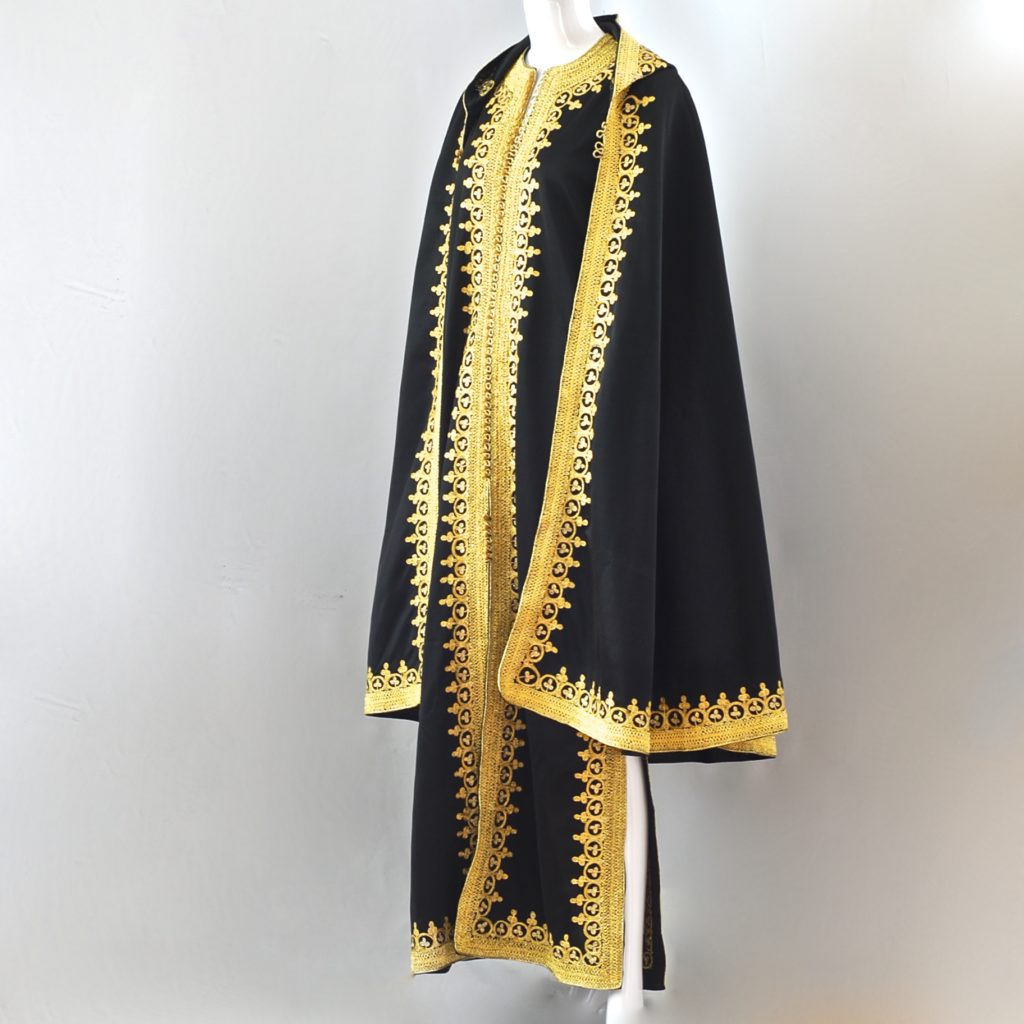
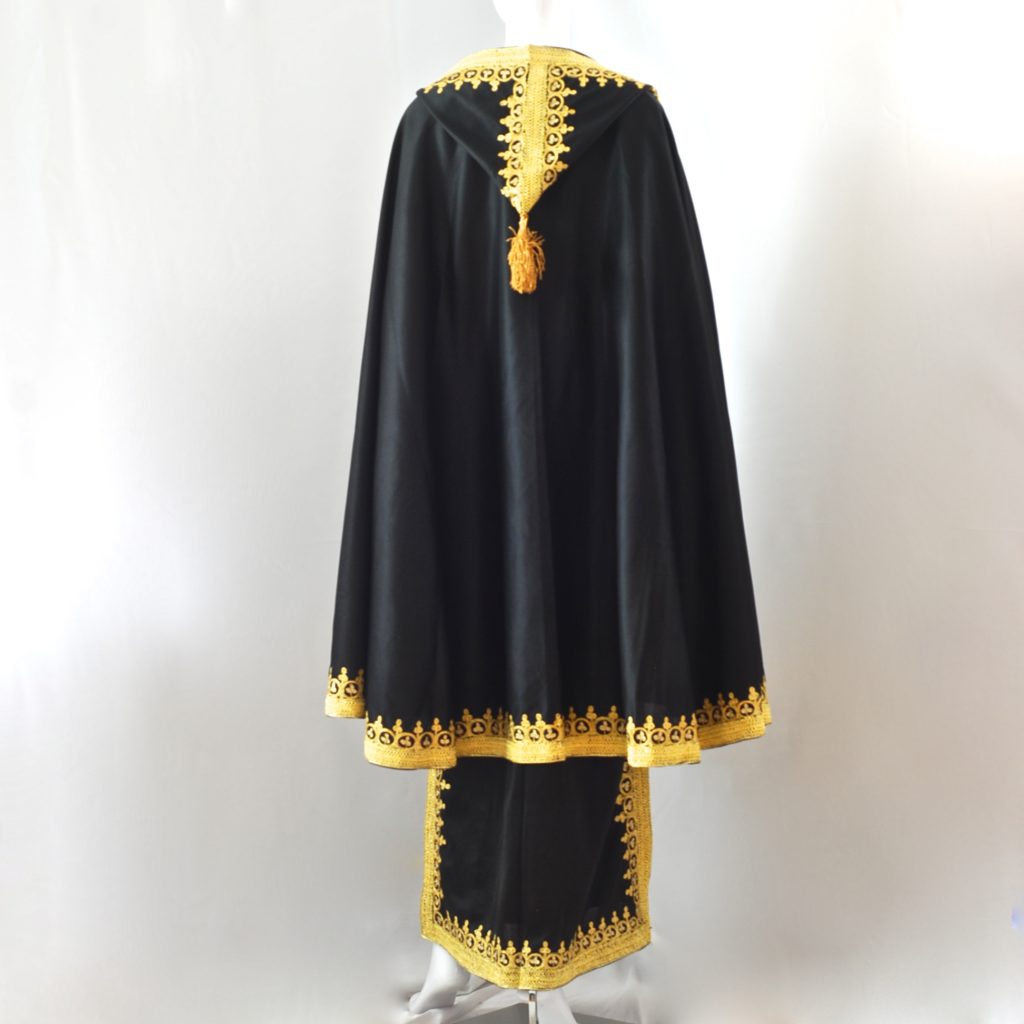
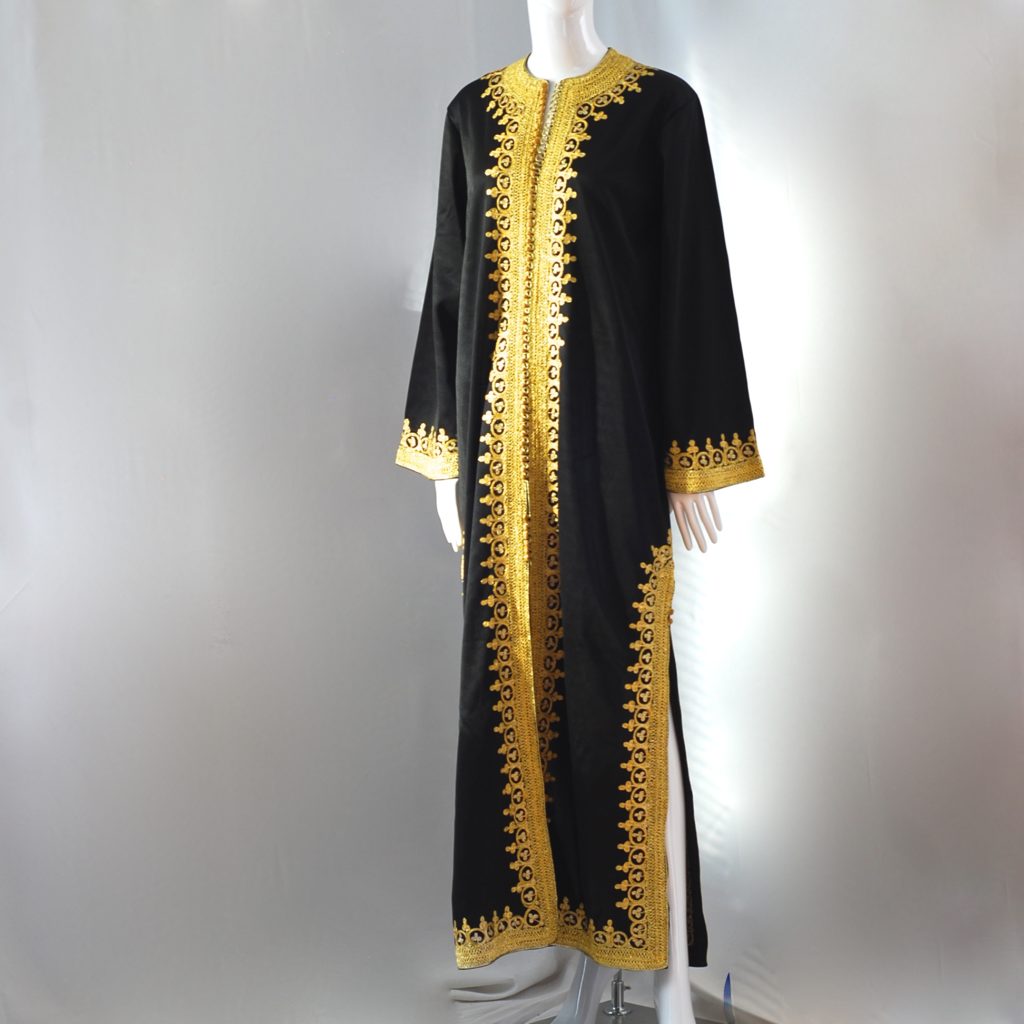
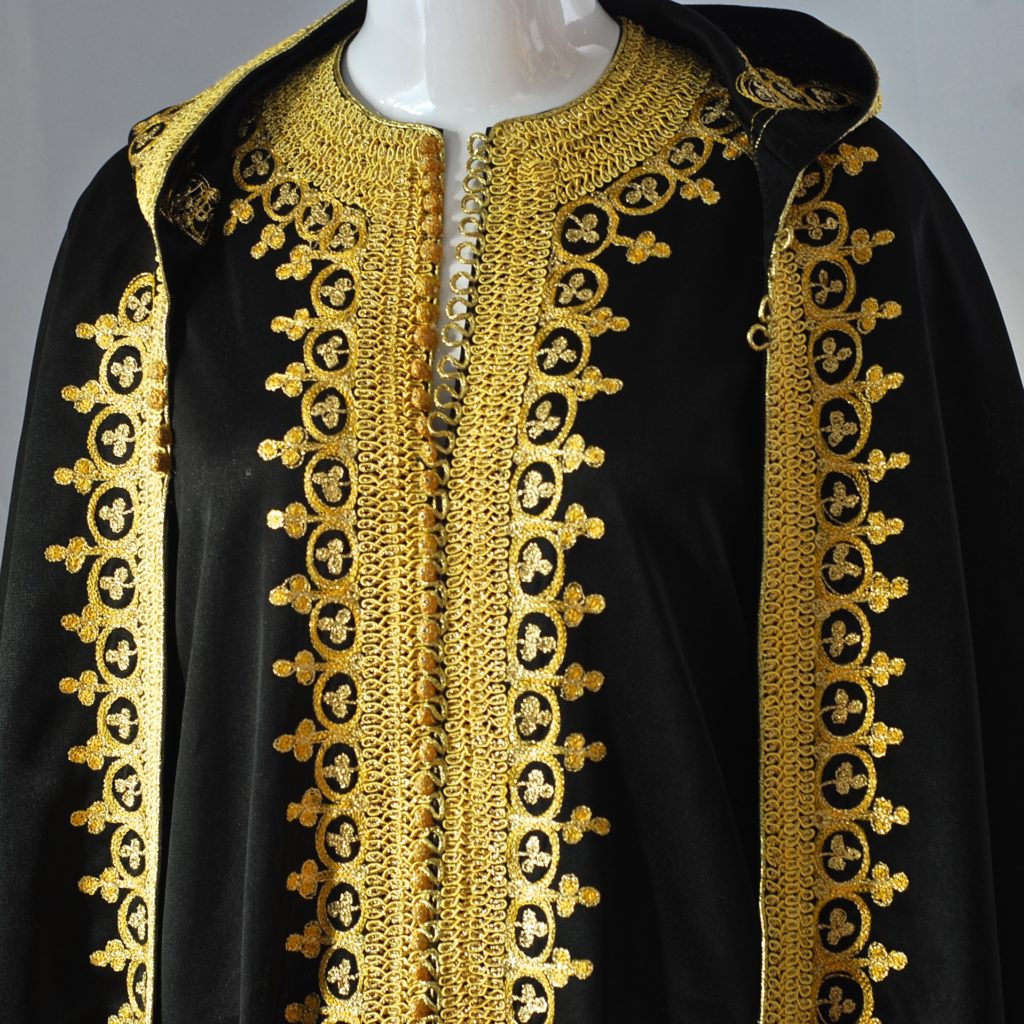
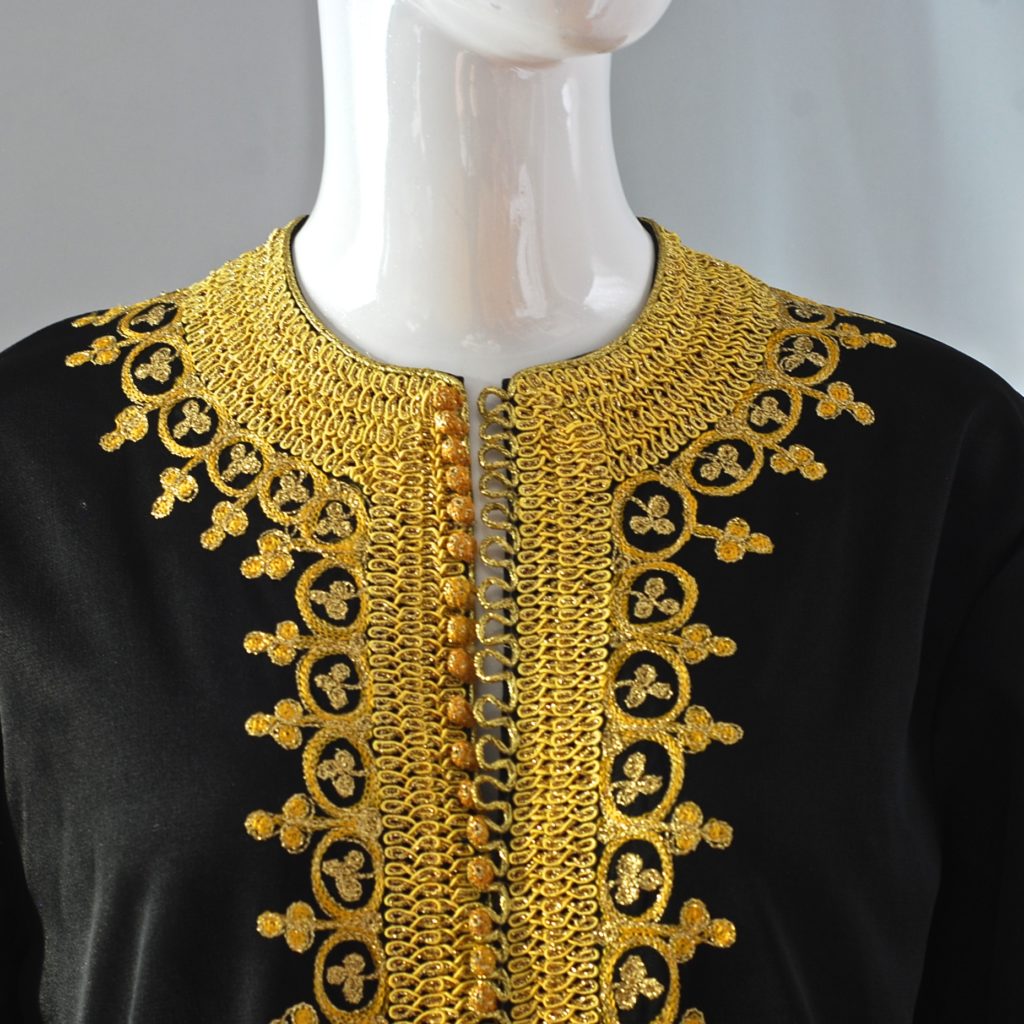
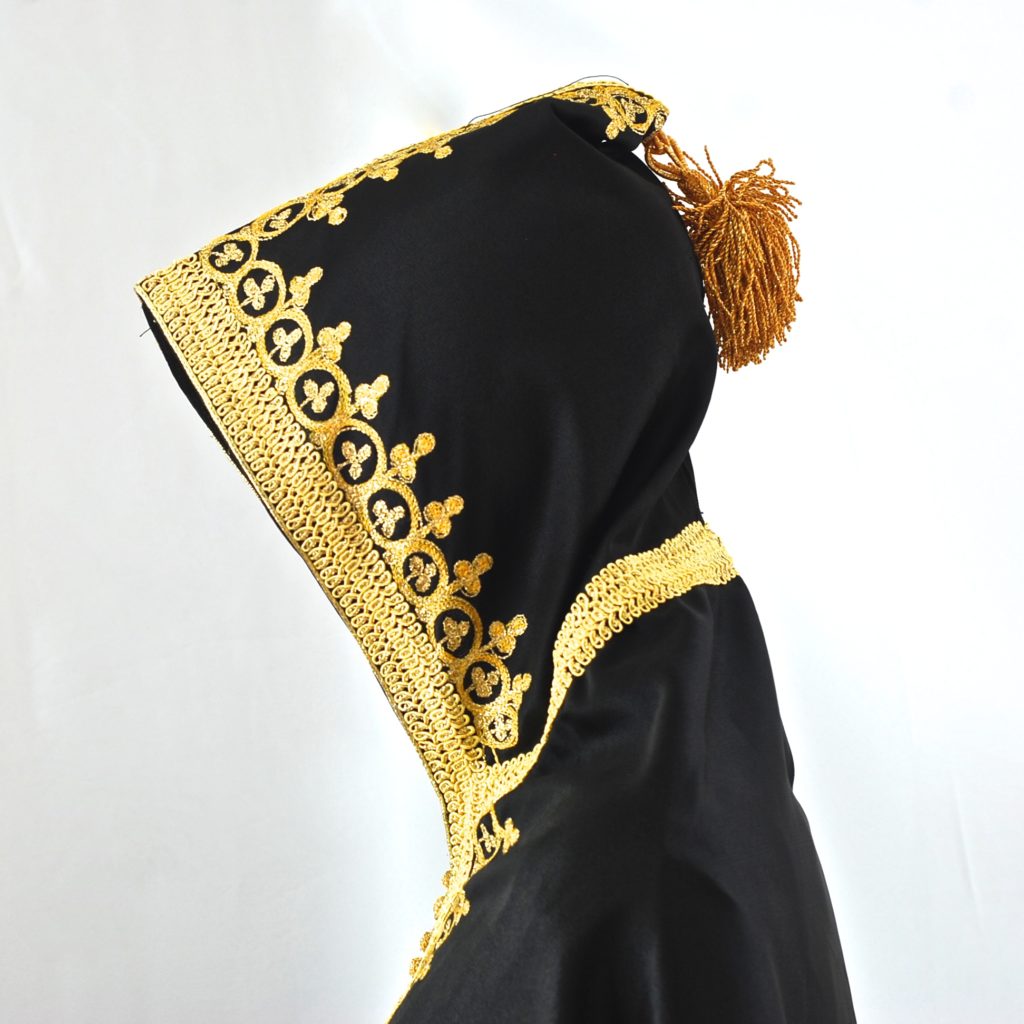
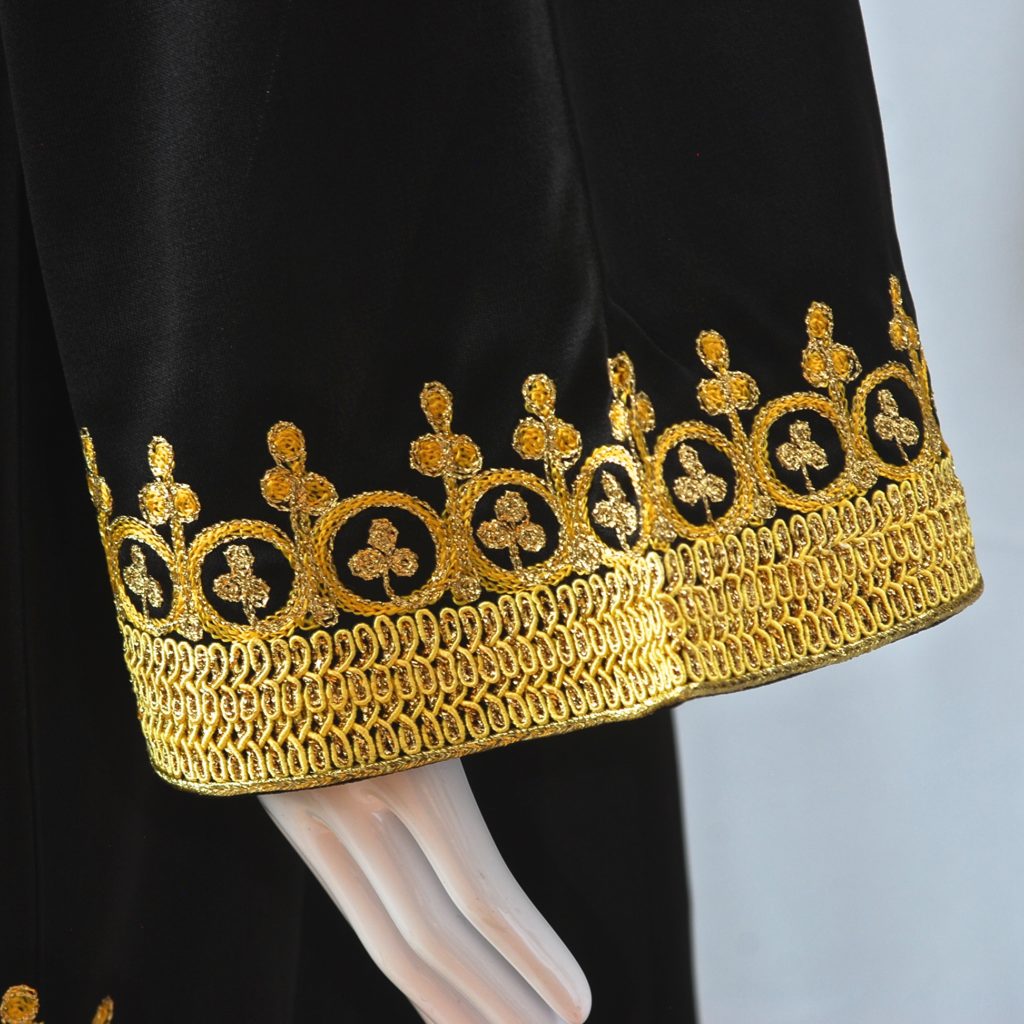
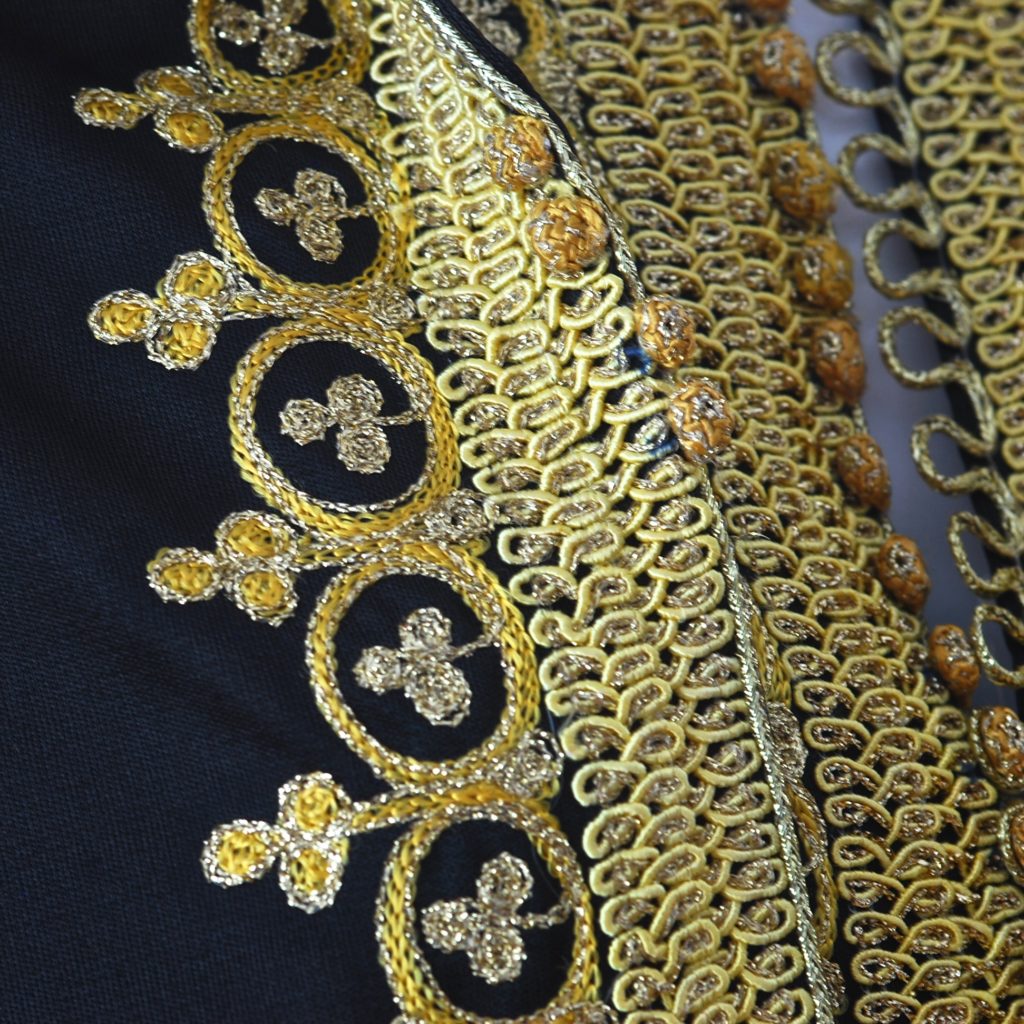
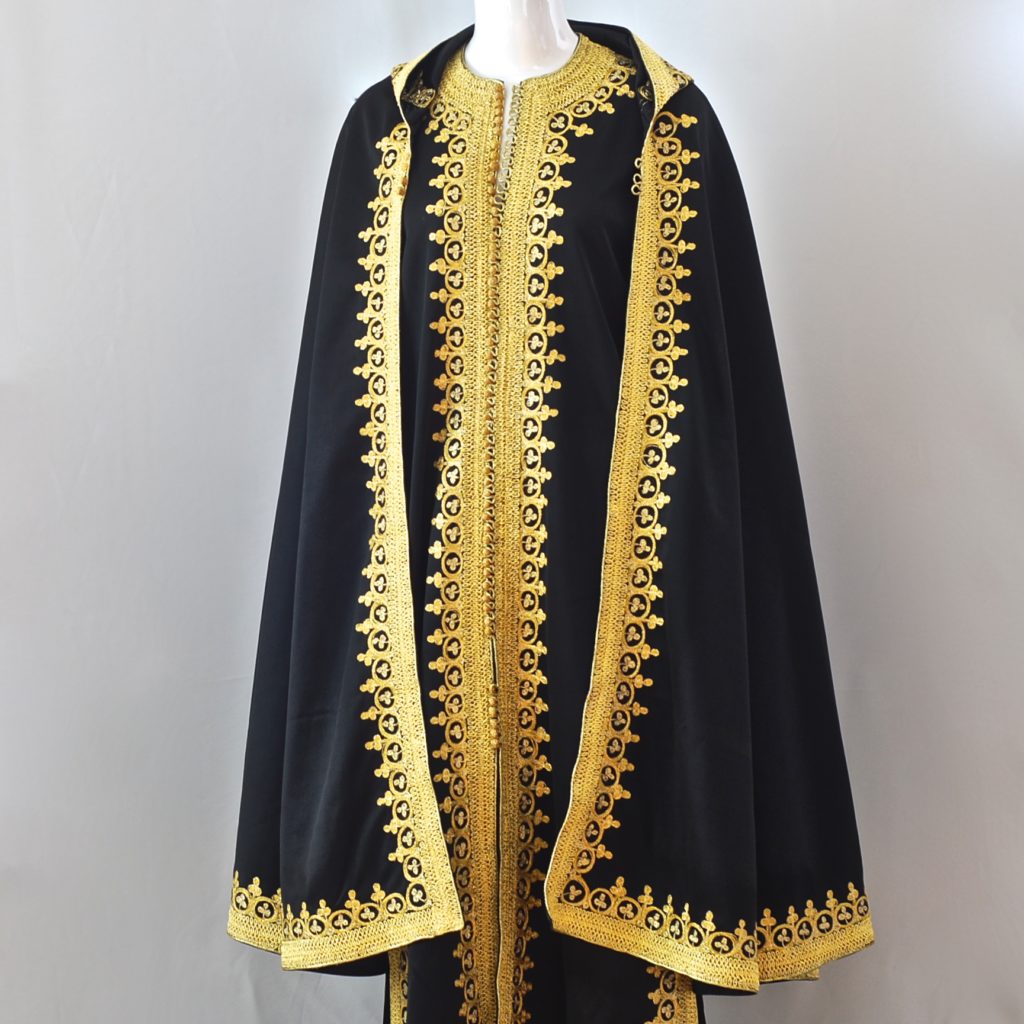
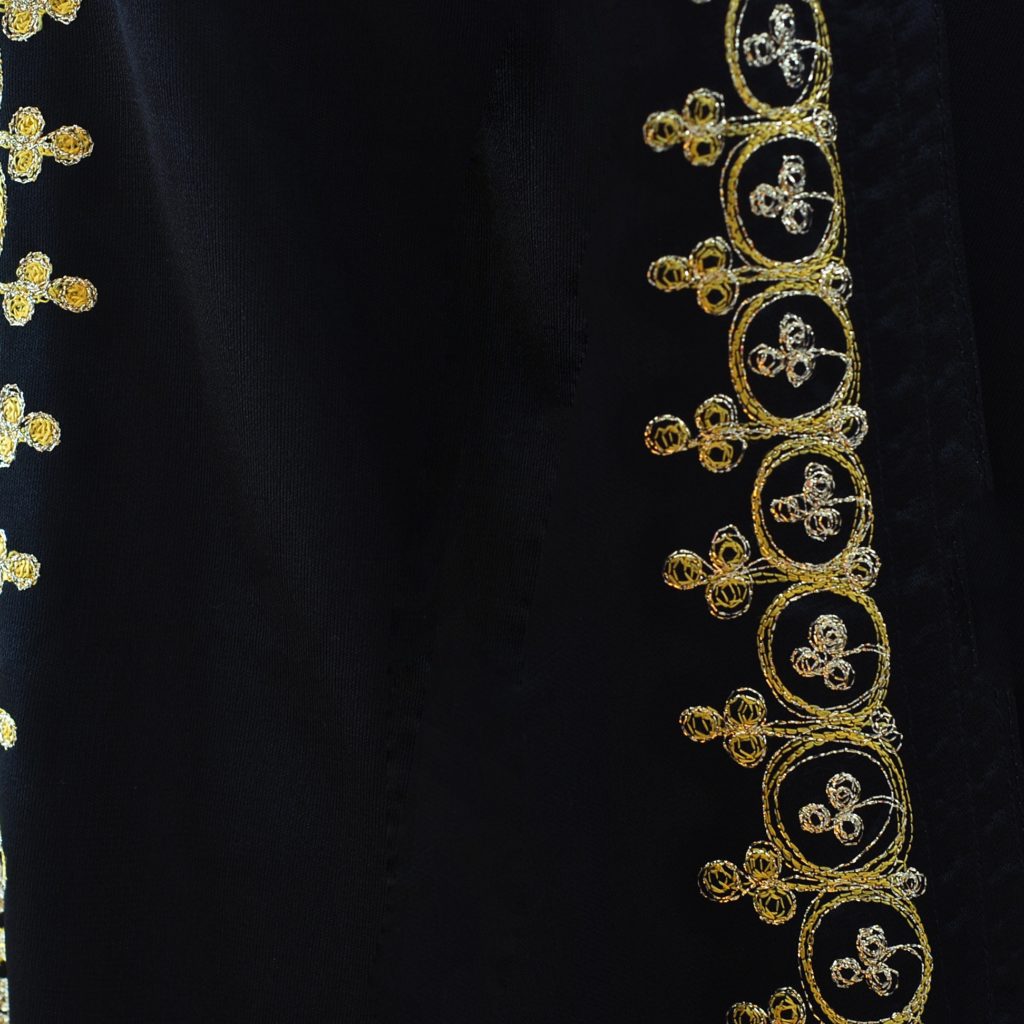
Reverse Side Of Embroidery
July 23, 2017
| Valerie Hayes
| Business & Web Development, Fashion Research, Feature Articles, View All Articles & Photos
As much as we can appreciate and learn from the expertise of others, beware of the collectors and sellers who claim to know it all. For those who are truly immersed in vintage textiles and design, it is a never-ending learning curve. When we seriously delve into the arts, like many other vast topics – it will increase our awareness of how little we know. A stubborn superiority will do nothing to alleviate our ignorance.
There are thousands of different types of fabric. Rayon alone has fifty different types and descriptions. The difference between hand loomed and machine loomed requires knowledge and a close examination of the garment. Fabrics such as mock crochet and many of the silk satin blends used in vintage clothing are now obsolete. Historical textiles from Egypt, India and Japan, for instance – can be traced back two or three thousand years. One could study textiles alone for an entire lifetime and still not know it all.
The same goes for jewelry. For example, there are thousands of sterling silver markings. I believe Mexico alone has around twenty-five hundred. Jewelry is fairly easy to transport and save – therefore it is more likely to survive the test of time. The country of origin in both textiles and jewelry design shines through in the product. Mexican sterling silver is artistically superb – especially the early and mid-century Taxco. Scandinavian and Navajo sterling silver has a very different and distinctive look compared to Mexican sterling silver. Gemstones in the jewelry also reflect the country of origin, such as the old turquoise mines, gemstones in the particular location, various treatments, settings, and alloys used.
One of the big questions in vintage clothing is in the perceived authentication of designer pieces. I don’t dispute that the vintage clothing market is complex, because it is and always has been in a state of flux and change. It is easiest to see this once you compare the same brand from decade to decade. Louis Feraud clothing from the sixties is highly desirable and recognizable. The eighties Louis Feraud is not as distinctive or as creative, however some of the scarves and certain pieces are drop dead gorgeous regardless of the age.
In my opinion the primary way to authenticate a designer garment is twofold – one is by the labels. The other is by the fabric and design. The best designer vintage has all labels to include the brand, fabric and where it was made. Pre-seventies clothing will often not have fabric content because it was not a legal requirement to have the fabric and care labels until then. Experience does help with evaluating the authenticity of a garment. However, if that information cannot be passed onto the consumer logically and without the pretense of knowing something they don’t know – how is that fair to the consumer or to the industry?
The art and history surrounding fashion design and textiles is as vast as any field can be. We are studiers and stewards of things that came before us – things we ourselves did not create. As human beings we are prone to making mistakes. There are hundreds of little tricks to help us identify things. If you use a jeweler’s loupe to examine fabric, it helps differentiate types of embroidery, the warp and weft of the fabric, loomed versus printed, damask versus brocade, etc. Gradually more and more criteria gets added to the list in your head when evaluating vintage garments. Anything that has covered buttons and/or silk lining warrants a second look.
A jeweler’s loupe will also help identify hand painted versus transfer decal, because you can see the dot pattern in anything that is printed. To determine if cinnabar is real, you hold the loupe at an angle and look for the layers in the lacquering. There is a very strong intuitive sense one gets from certain things. In some cases I will know immediately if the item is authentic – without looking at any labels. I do not buy anything designer with a Made in China label with the exception of vintage and antique Chinese silk embroidered pieces and Chinese export porcelain (and mud men). A small percentage of things in the collection are made in Hong Kong.
In many cases with jewelry I cannot identify markings that are worn or too faded. Another example is that designer labels like Dries van Noten were originally made in Belgium. Now many of the luxury labels are made in India. Dries van Noten also has clothing made in Romania on newer items. My philosophy is to be honest and up front about where an item was made and price accordingly. I do not consider famous brands to be authentic unless they are made in the country of origin. It may be a purist attitude but that’s how I see it.
In reality vintage designer clothing has become the crème de la crème of high fashion. Certain iconic pieces by Versace, Alexander McQueen, Thierry Mugler, Karl Lagerfeld, Rudy Gernreich, Christian Dior, Valentino, Courreges as just some examples – are now fetching prices between five and twenty-five thousand dollars per item. Some of the well-preserved dresses from the twenties are now listed on various sites for several thousand dollars each. I checked a textile auction in New York and saw that designer dresses with significant damage from the fifties and sixties sold for close to a thousand dollars each.
The clincher is that certain pieces by certain designers at specific times in their careers – are like original or limited edition art pieces. They represent the creative genius that drapes the human form – with rich colors, textiles, fluidity of movement and multi-dimensional ideas. The art in design has no room for know-it-alls. It is one big mirror room – both dazzling and dizzying in scope. A vintage clothing collection reflects the culture of a country. Online collections of vintage clothing from different locations are a unique representation of local talent as well as the migratory nature of things from faraway. I love to look at collections of vintage kimonos from Japan. The artistic elements of the Japanese kimonos surpass most textiles. A collection of vintage kaftans from Morocco would create an awesome and inspirational show.
We are all partakers of fashion to some degree. Some of us like to keep fanning the flames of fame for those with vision because they created beautiful things with lasting value. We pluck what we pluck for many reasons. I believe it is best to be dedicated to learning and willing to admit and correct mistakes. Why? Curiosity is a driving force. The field is sweeping and boundless. The biggest mistake is to get arrogant and convey to consumers that we know-it-all. It is completely acceptable to cite ones credentials – with specifics, not braggadocio hot air. We are more or less prone to filling in gaps with mere conjecture. I do accept and respect the knowledge of others, but it is not based on what they claim to be, more on what they are interested in and have experience with.
To create a division between “us and them” from those who declare to be experts – is the kind of limit the arts neither needs nor accepts. Just as in poetry, we get to pick and choose our words. That’s the beauty of art. Quite simply when it comes to vintage fashion and design – no one knows it all. The flow and finesse surrounding beauty and creativity in the arts contains a central hypothesis. Since it applies to almost all things requiring talent or knowledge – not only in the visual arts, but also in sports, literature, music, academia and technology. The bottom line is – show me your stuff. Don’t tell me how great you are. When it comes to vintage fashion – we are talking about material things. Besides all that – it is probably wise and a better reality check, to let those with less of a cognitive bias, be the ones to decide how great we are.
Copyright Valerie J. Hayes and Quiet West Vintage (2017). Unauthorised use and/or duplication of this material without express and written permission from this blog’s author/owner is strictly prohibited. Excerpts and links may be used, provided that full and clear credit is given to Valerie J. Hayes and Quiet West Vintage with appropriate and specific direction to the original content.
August 24, 2016
| Valerie Hayes
| Feature Articles, Textile Art, View All Articles & Photos
This hand woven silk damask textile by Raja is absolutely stunning. It is very large, with an ivory backdrop, rich in depth and texture, yet vibrantly reflective. The pictures below show each side of the design, as well as some close ups. Although there are many hand woven rugs from India and Pakistan, hand woven silks, and beautiful hand embellished saris – so far, I cannot find anything comparable to this on Ebay, 1stdibs, or any of the other sites on vintage textiles. From the Antique Textile History, the following information sheds some light on the origin of such a textile, not including the selection and preparation of the silk, or colours, but enough to enhance our appreciation:
“BROCADES – THE TRADITION OF BRINGING SILK TO LIFE
Brocade weaving, especially with gold and silver, has been an age-old tradition in India. There are two broad classes of brocades. Brocades of pure silk or silk and cotton blends and zari brocades with gold and silver threads. The most important material in brocade weaving is silk. It facilitates lovely weaves, is durable, strong, fine and smooth. There are several varieties of raw silk of which the chief ones used for brocades are Tanduri, Banaka and Mukta. Tanduri is imported from Malda and other places in Bengal. Banaka is thinner and finer variety and is mostly used to weave soft fabrics such as turbans and handkerchiefs. Mukta is a coarse and durable silk used for kimkhabs, as fine silk would not withstand heavy gold patterns.”
“MAKING NAKSHAS (DESIGNS) ON BROCADES
Making of nakshas (designs) forms an important part of brocade weaving. Banaras is the main center where the nakshabandha (designer) tradition prevails. The skill and imagination of nakshabandha plays a prominent part in making of designs. Designs are associated with legends and symbolism. The most popular motifs are drawn from nature. In Banaras, it is said that nakshabandha families were brought to this country during the reign of Muhammed Tughlak (1325-1350 A.D.). They were supreme masters of the art of tying designs into the loom. Local artisans and weavers learned this art from these great craftsmen. Some of these craftsmen were also great poets-perhaps they wove their poetry into their designs. One such renowned poet was Ghias-I-Naqsband, mentioned in Abul Fazl’s ‘Ain-I-Akbari’. The nakshas are first worked on paper. This part of the work is called likhai (writing). The nakshabandha then makes a little pattern of it in a framework of cotton threads like a graph. This pattern gives guidance to the working of that design into weaving.”
The example in this post, is a much heavier silk than most. The design on one side does not show through or impact on the other side. I am guessing it was part of a special ordered bridal trousseau, and estimate it to be from the sixties or seventies. It is truly extraordinary – with many components in the design and fabric, from dimensional rose floral outlines, to small raised slubs on the fabric, and a periwinkle contrast. The centre on one side features a large round design, a bouquet, outlined in coloured lines. In the very centre, there is a small red symbol or signature. The condition is pristine. It is one of the most beautiful textiles I have ever handled and photographed. It is visually tactile, a fascinating sight to behold, with a luminescent glow and vibrant colour and synchronization. It creates an exhibit with features unique to the richly exotic and historical textile artistry from faraway lands.
It demonstrates how the non-material world – beginning with the vision of a poet or artist, can be woven into the material world – and will always retain the beauty and vision of the soul that went into it. Initially as a concept it may seem overwhelming and elusive. Eventually it turns out to be, a fine representation – of soulful materialism and poetic realism.
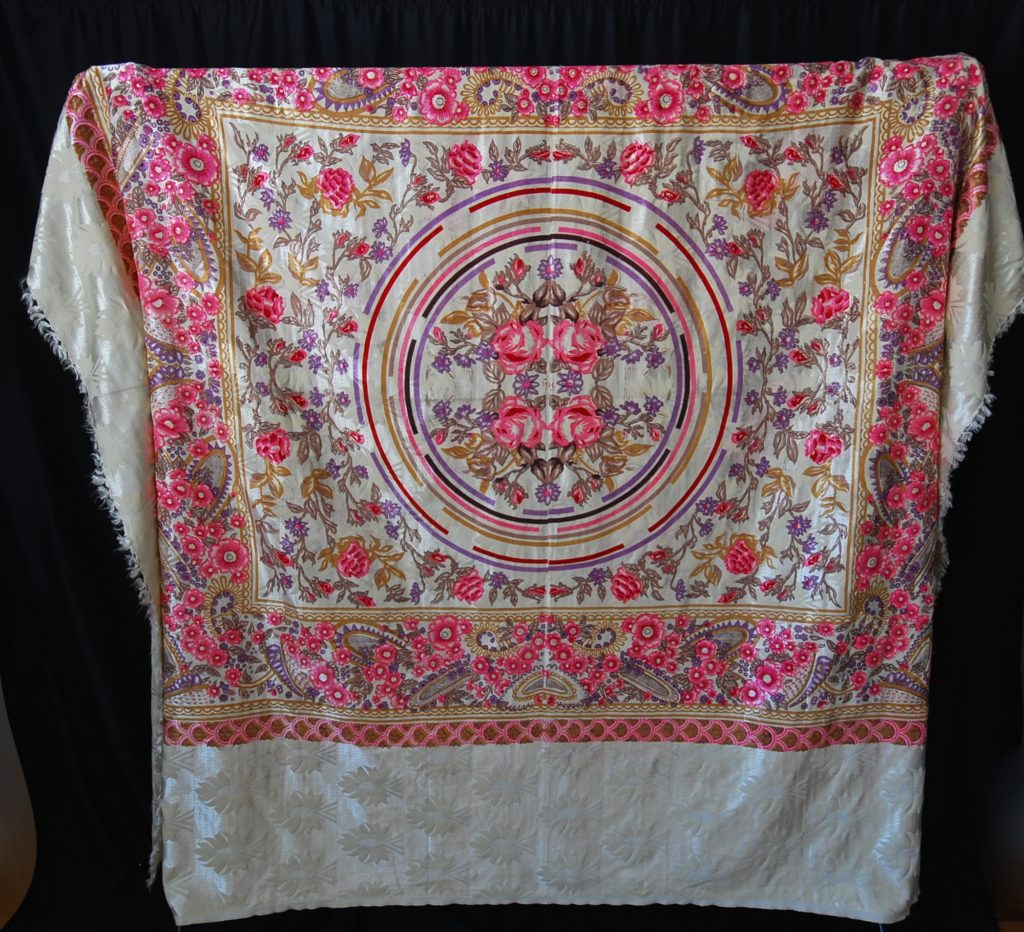
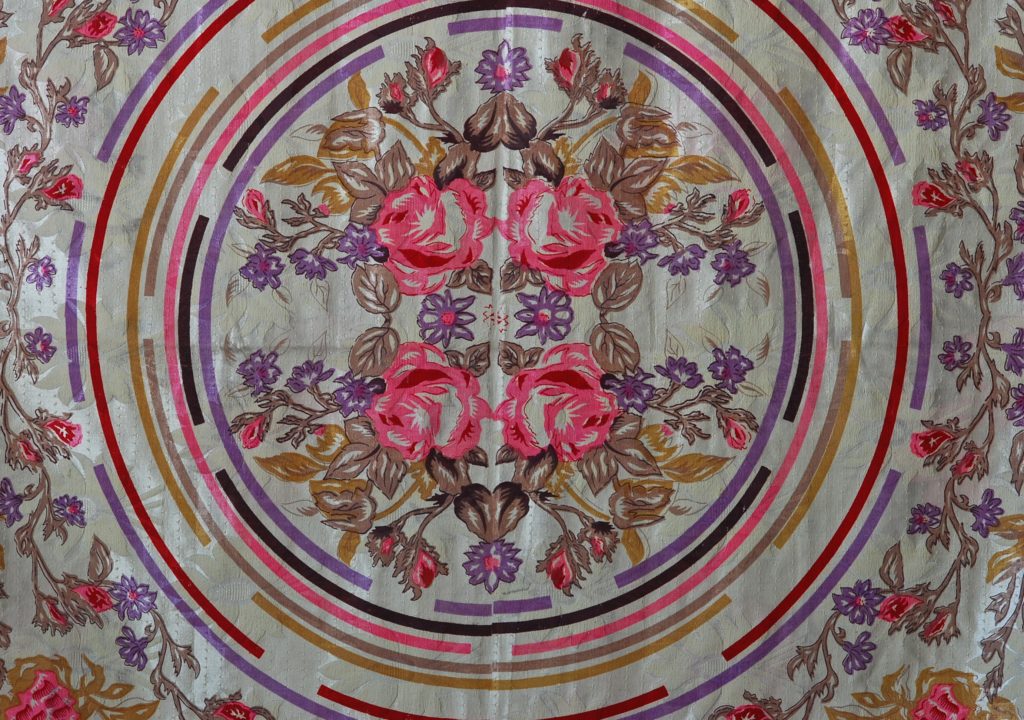
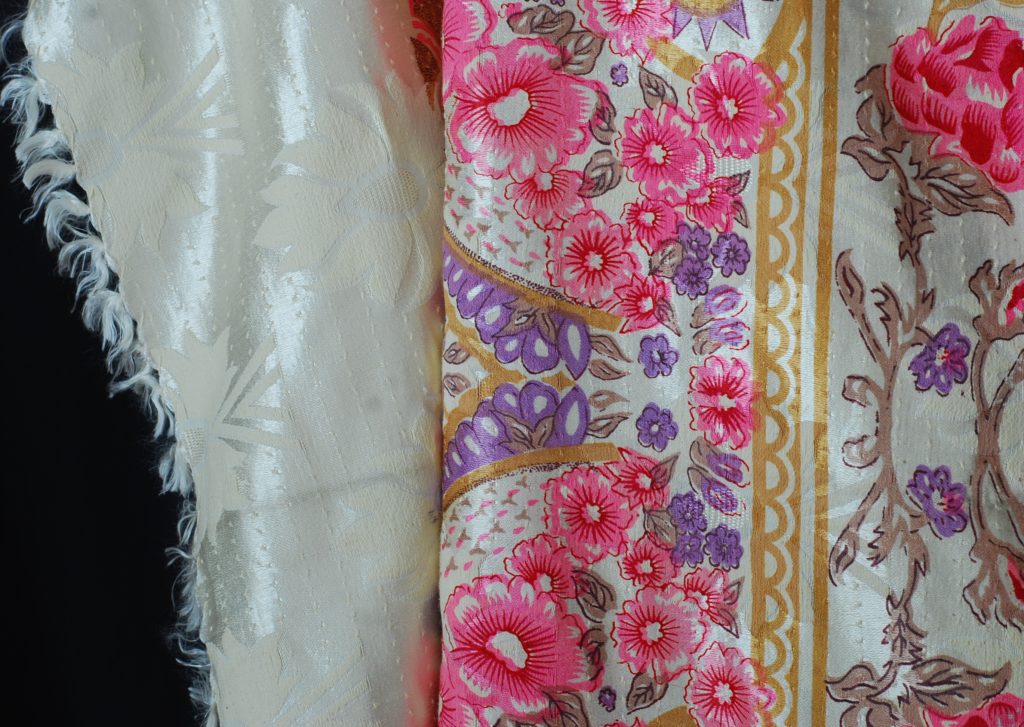
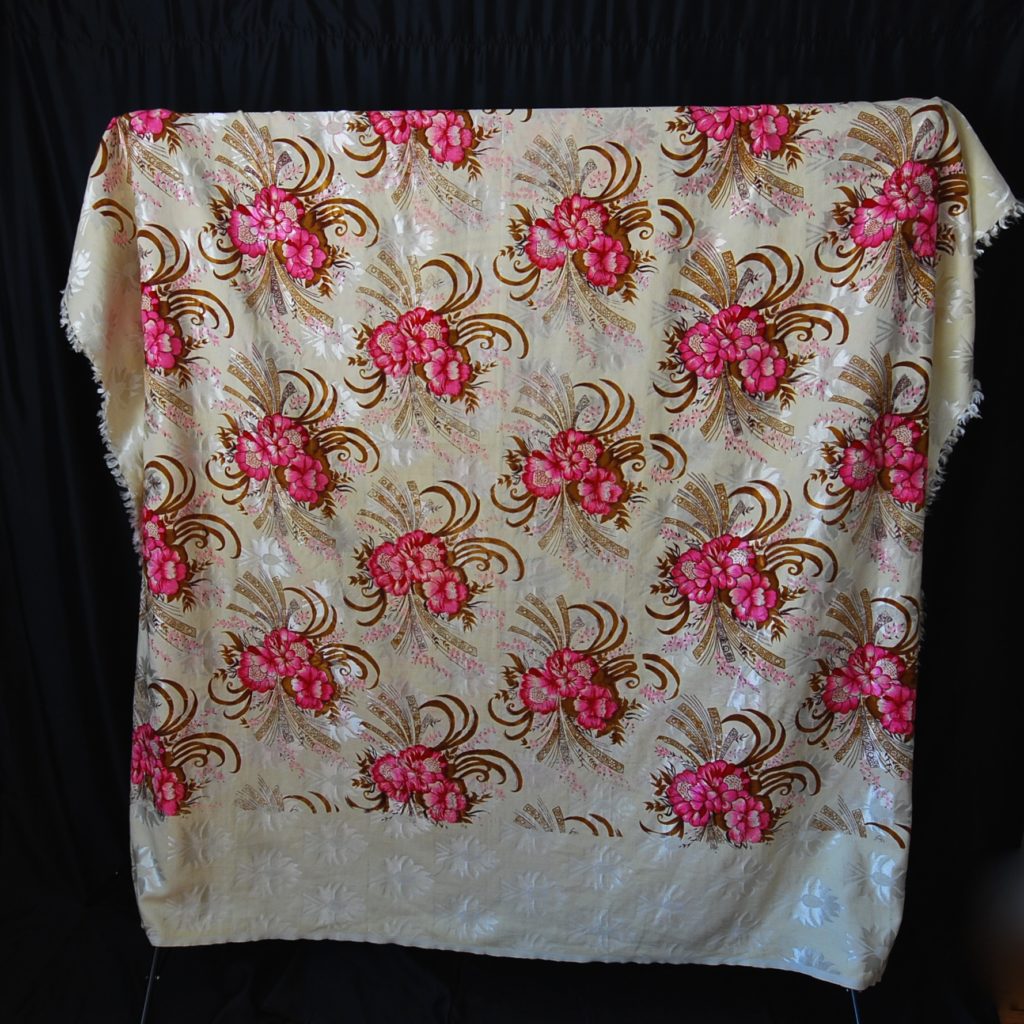
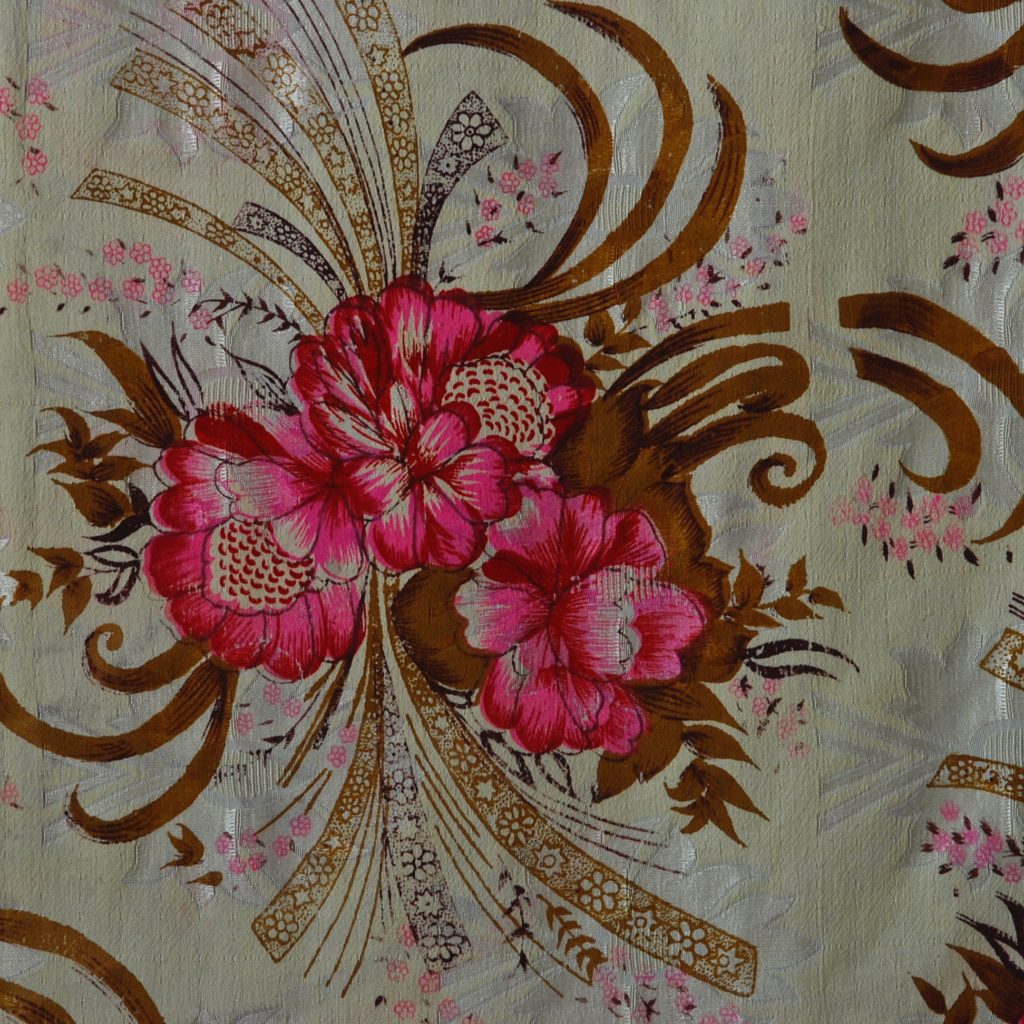
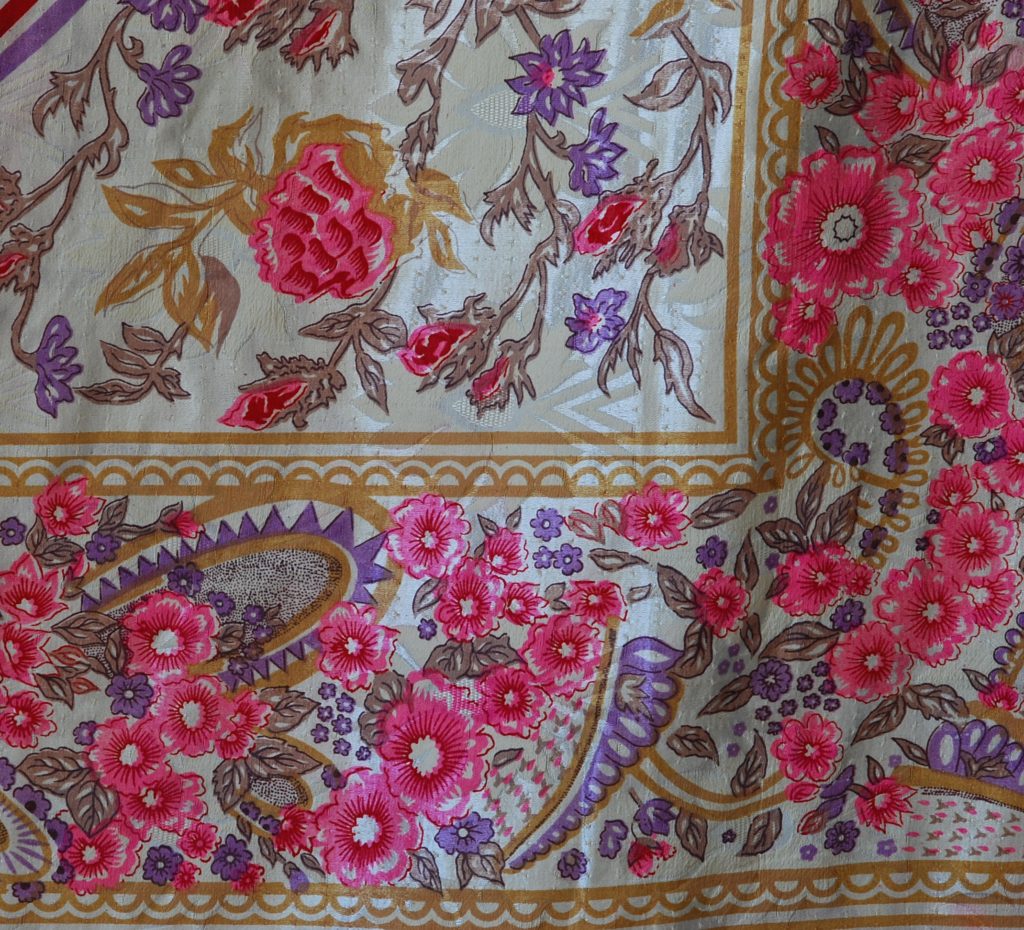
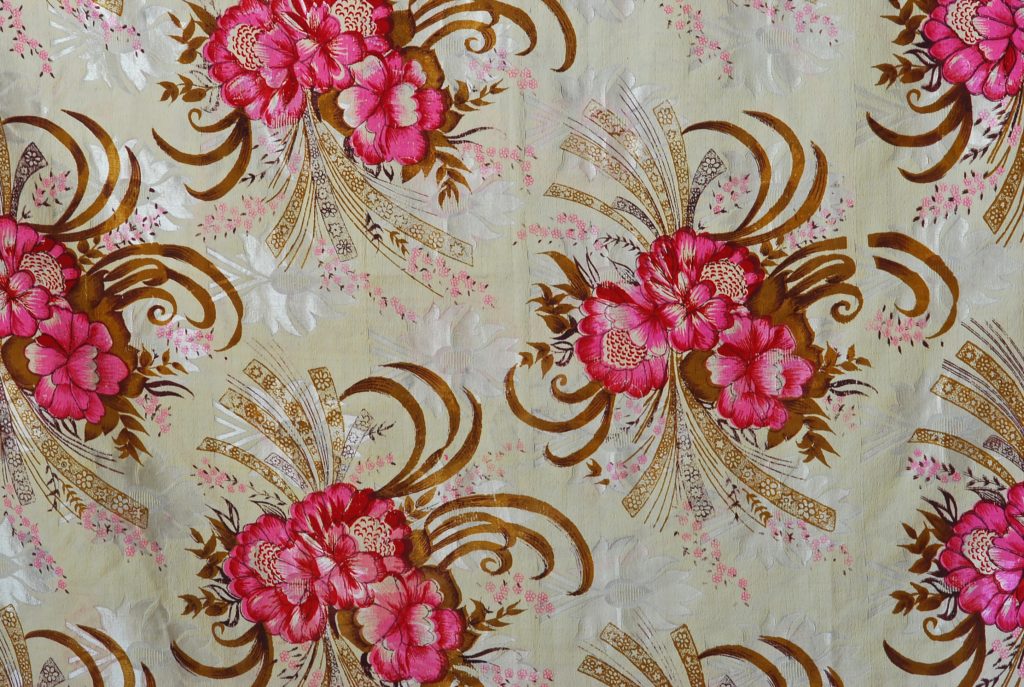
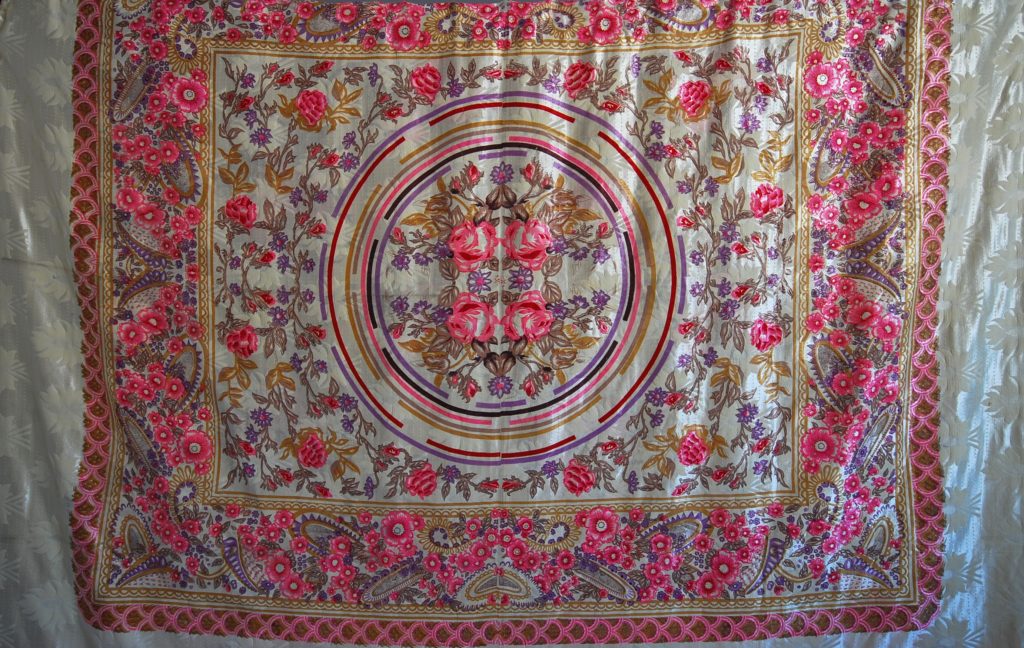
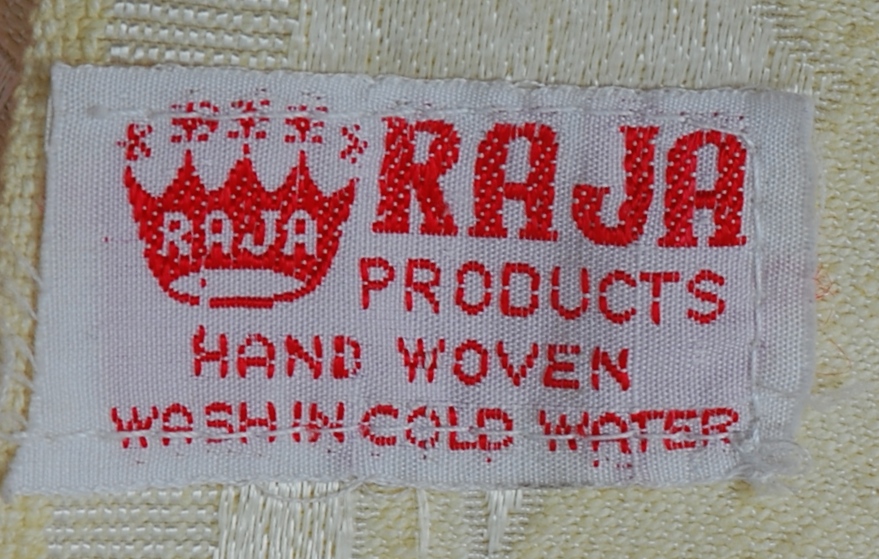
July 4, 2016
| Valerie Hayes
| Business & Web Development, Designer History, Fashion Research, Feature Articles, View All Articles & Photos, Vintage Outfits
To sum up the Canadian Designer Celebration mini series, a high percentage of Canada’s best mid-century designs and designers, have their roots in Montreal. The more I delve into the collection, and the labels – the more I realize how much of our great fashion history can be credited to Montreal. When it comes to fashion, the French do not disappoint. Toronto as a second runner-up, retains a mid-century vibrancy, with its legacy of notable designers.
The Montreal designed little black cocktail dresses from the sixties, are as sleek, and as wearable today, as they were back then. The hallmark of a great designer, is in the timelessness of their creations. I will happily share some exclusive examples…Starting with a late fifties, or early sixties Irving Nadler lace cocktail dress with a cape style top.
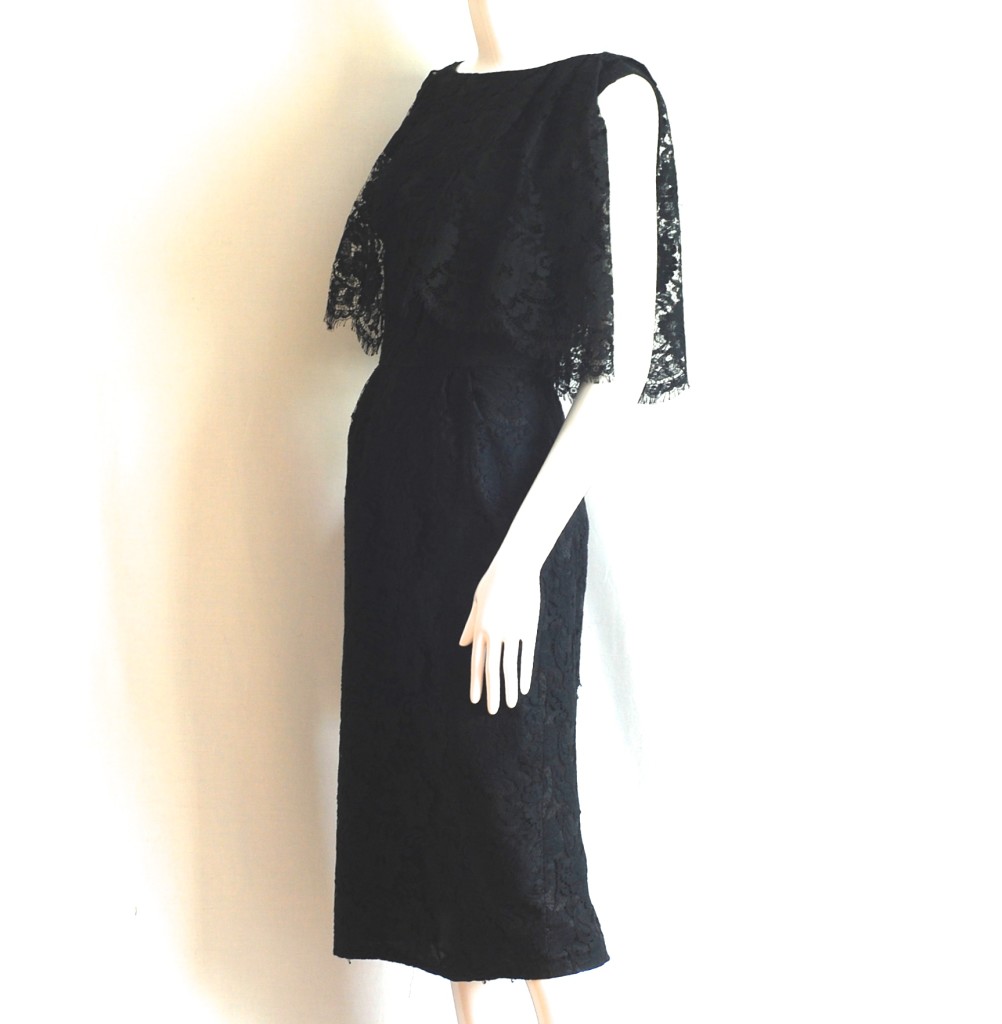
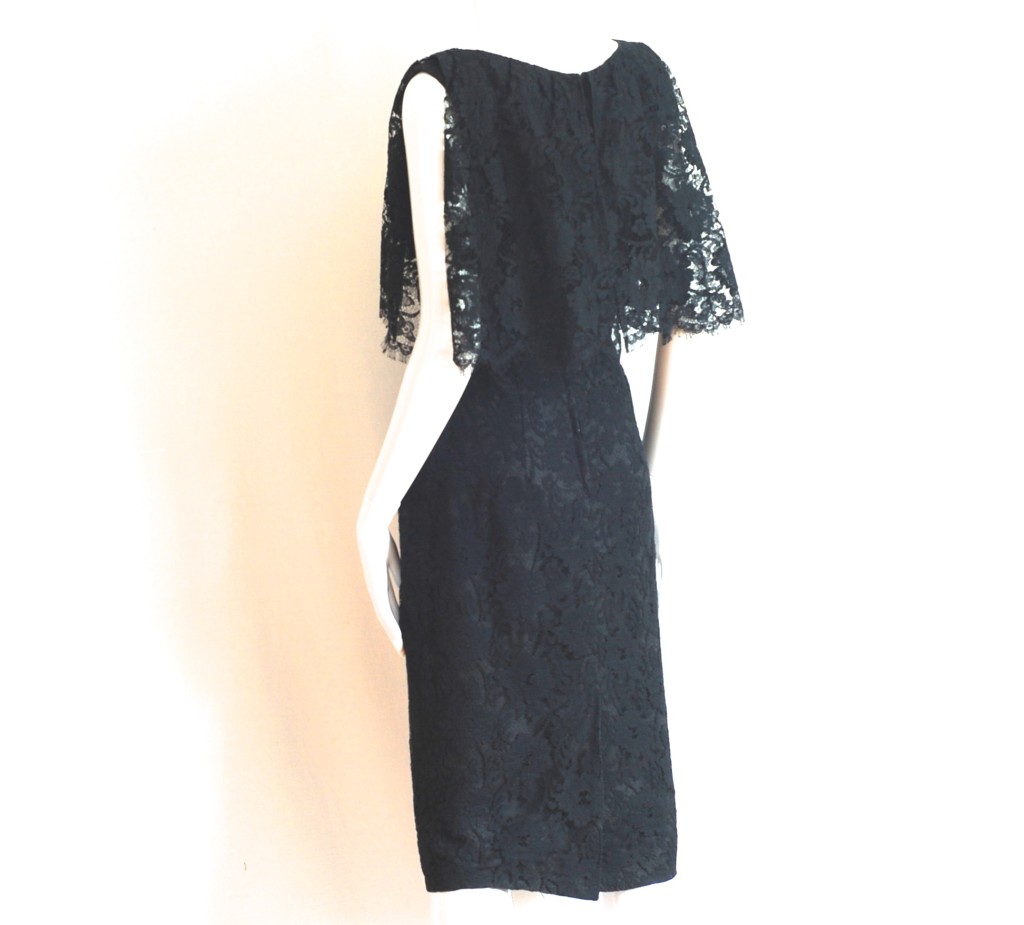
Irving Nadler, Montreal Late 1950’s or early 1960’s Cocktail Dress
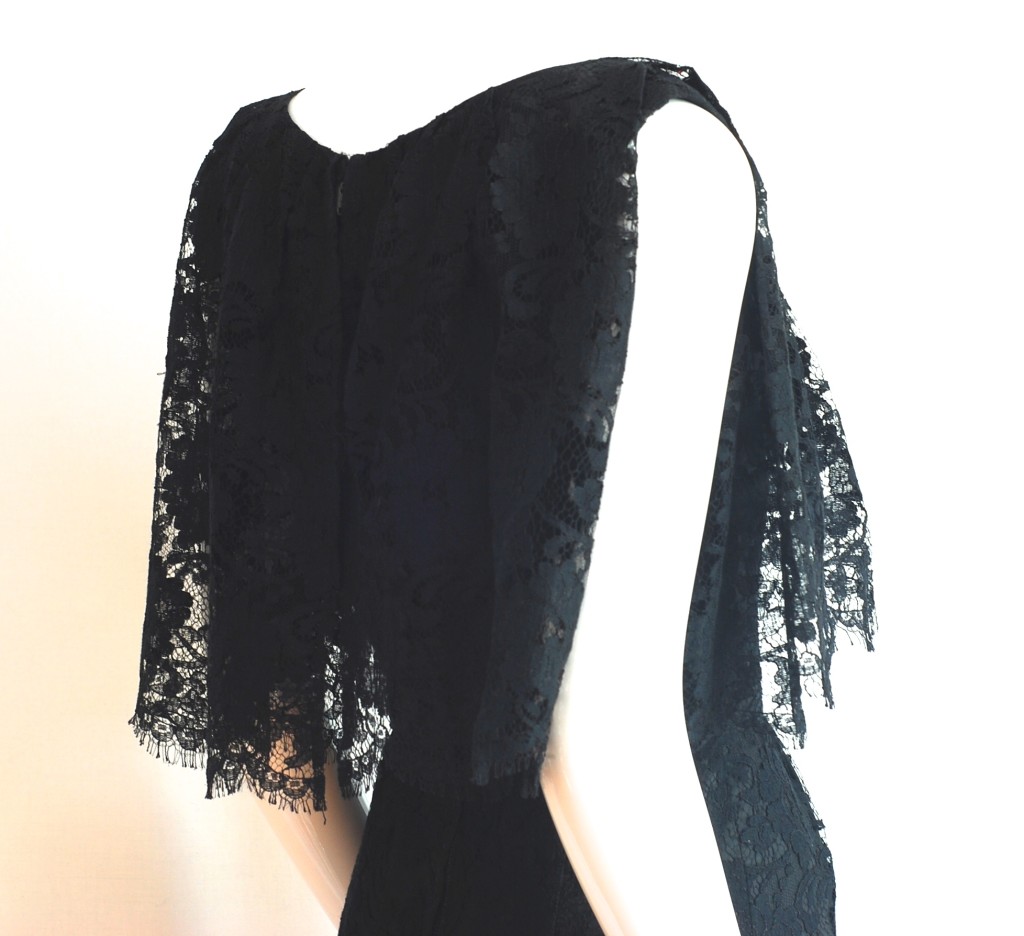
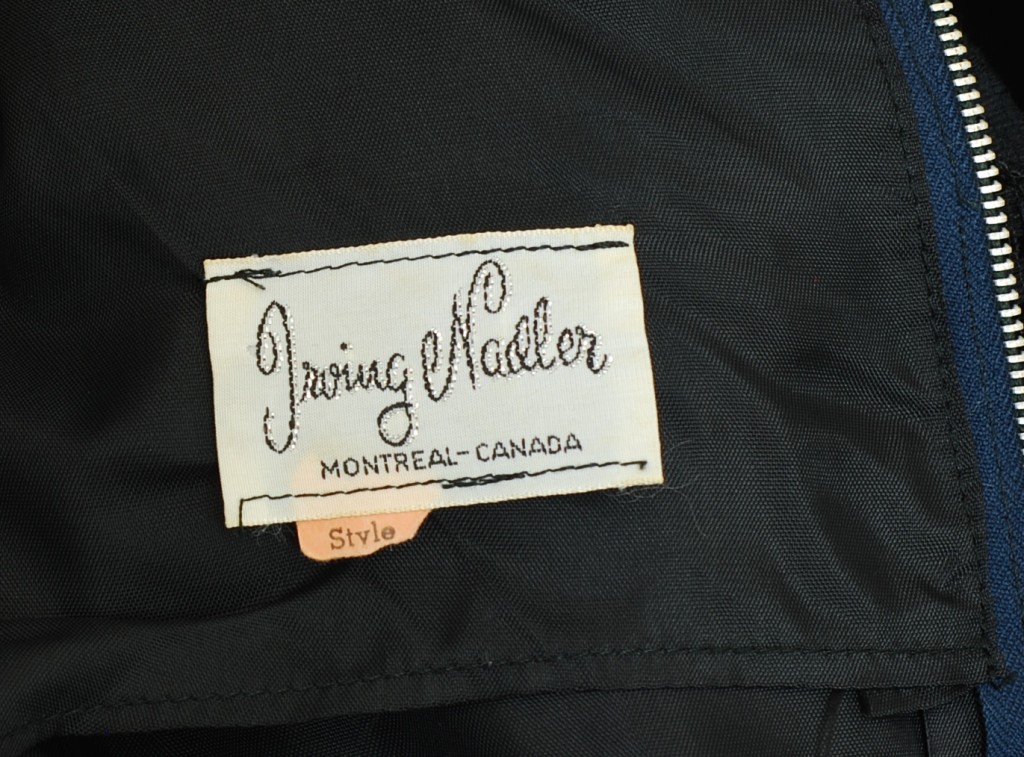 The next 1960’s little black dress from Montreal is aptly labeled – After dark Cocktails.
The next 1960’s little black dress from Montreal is aptly labeled – After dark Cocktails.
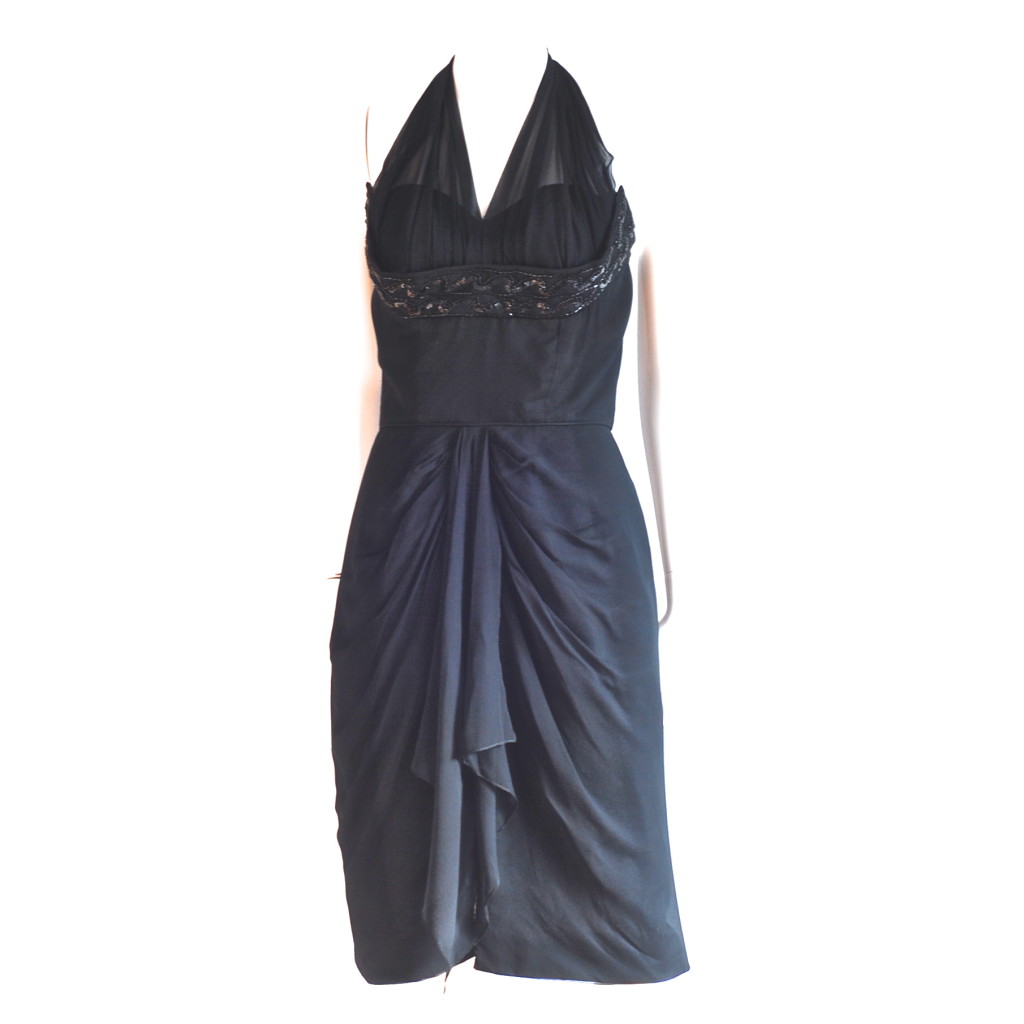
After dark Cocktails, Montreal 1960’s black halter dress.
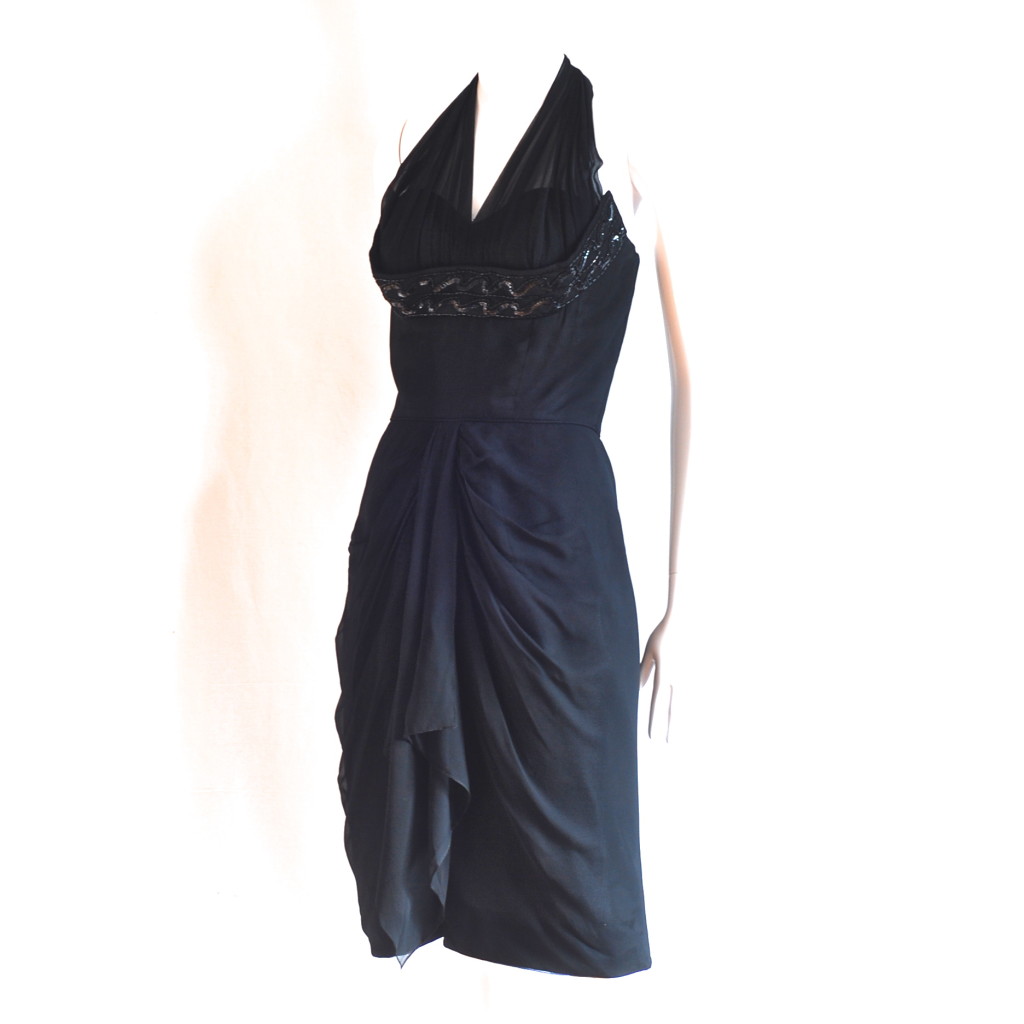
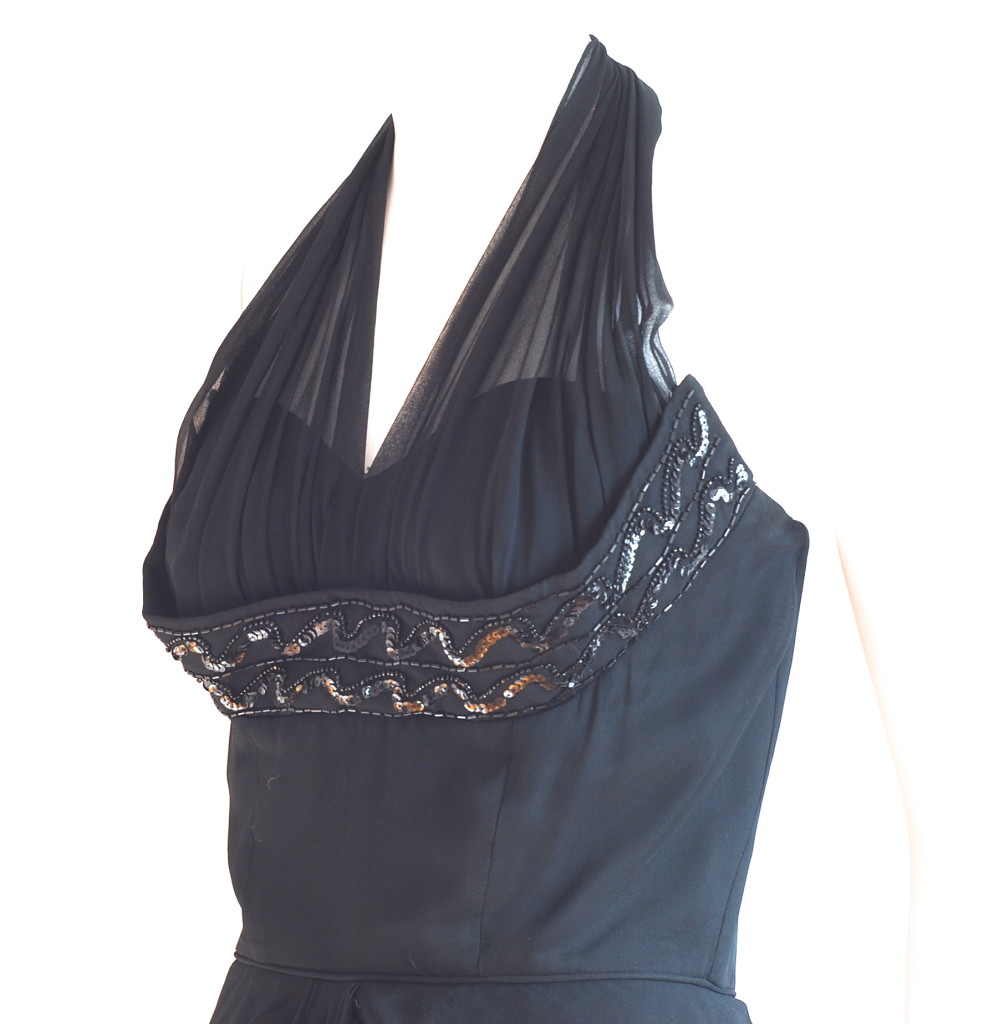
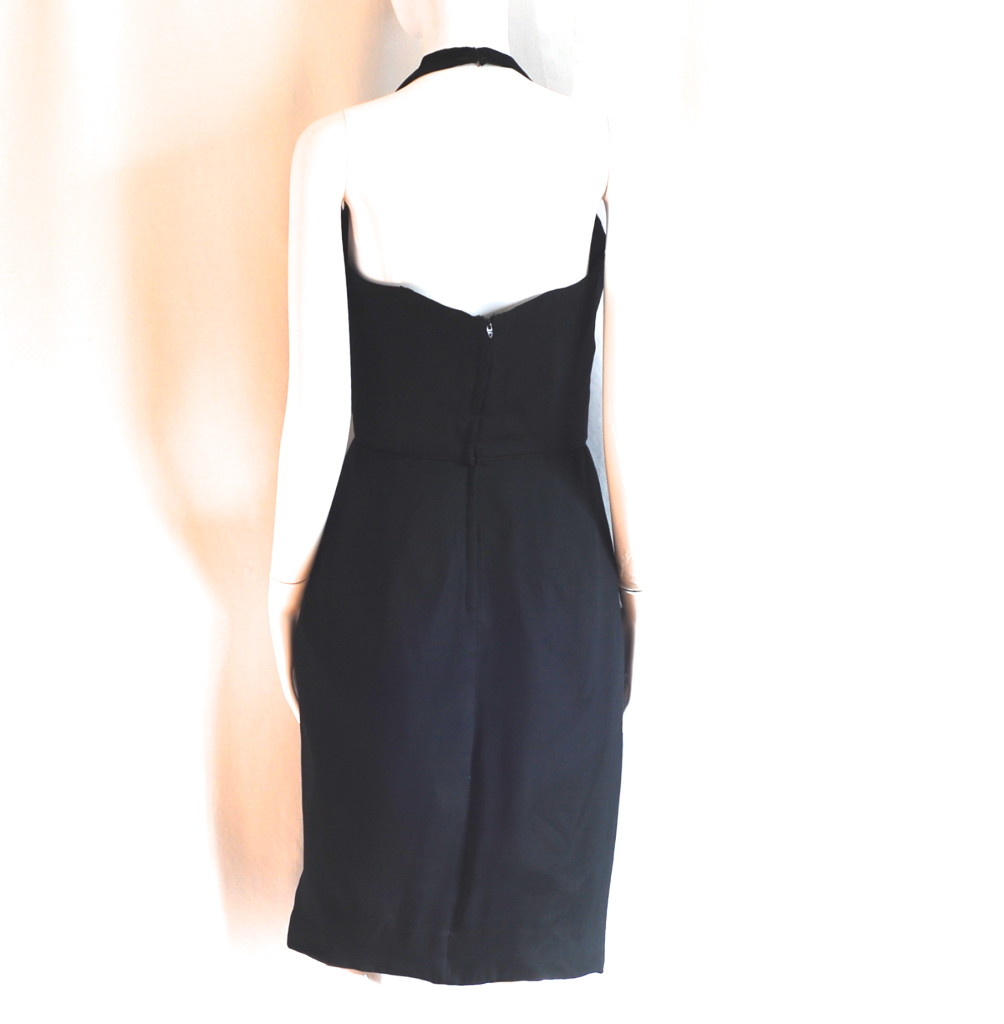
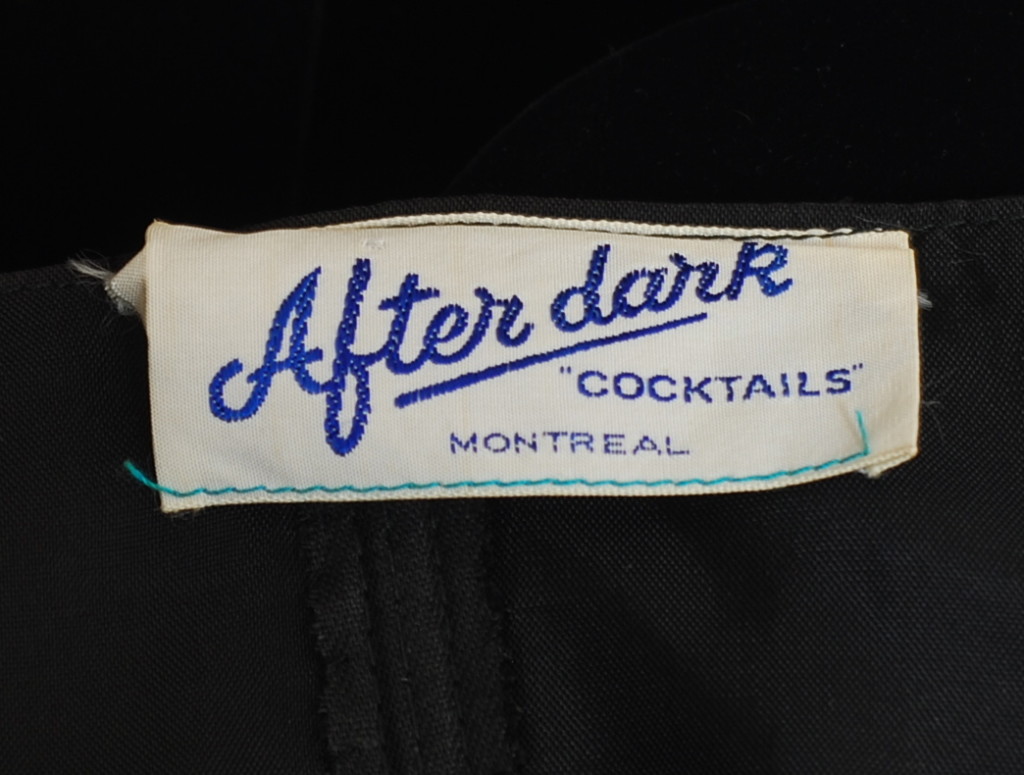
Another Montreal classic little black dress, 1960’s black velvet, with gold piping at the waist. This one has the musical label – Beau Time Melodie Frocks.
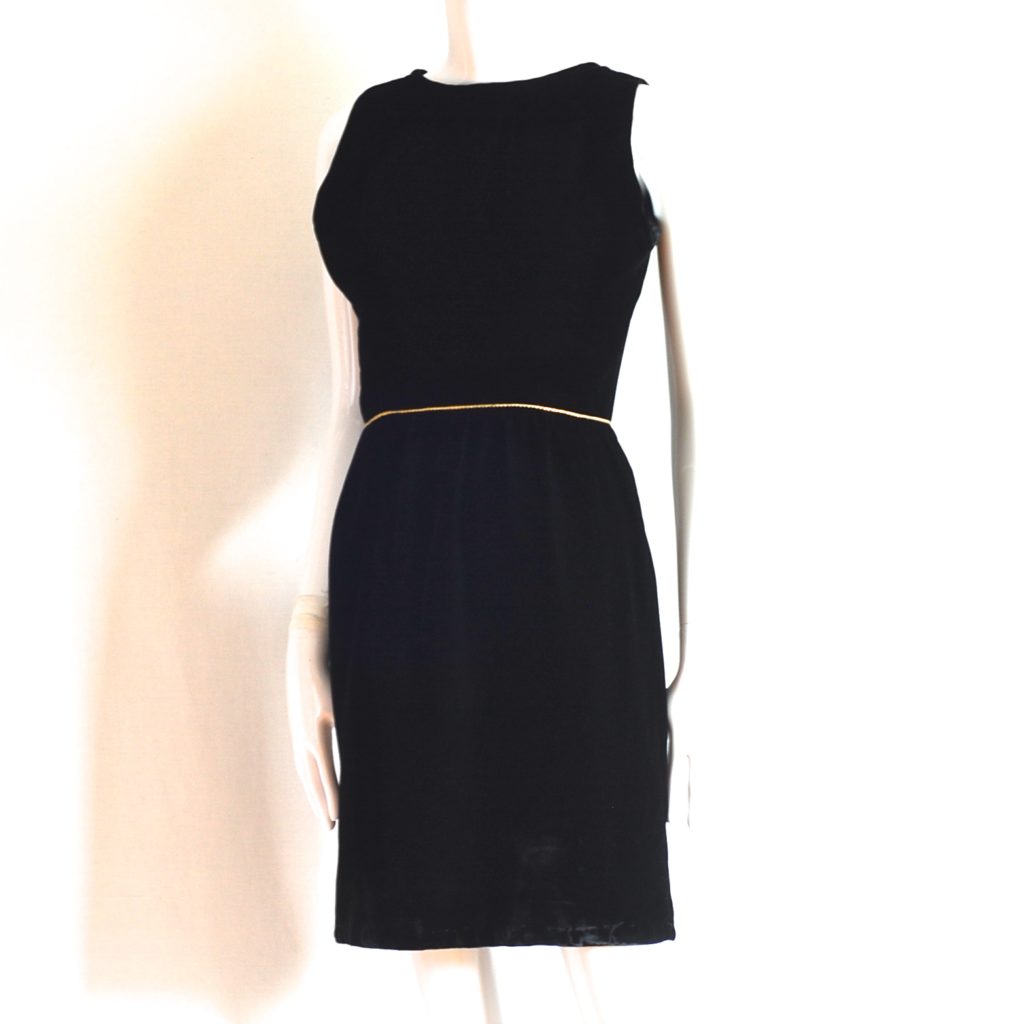
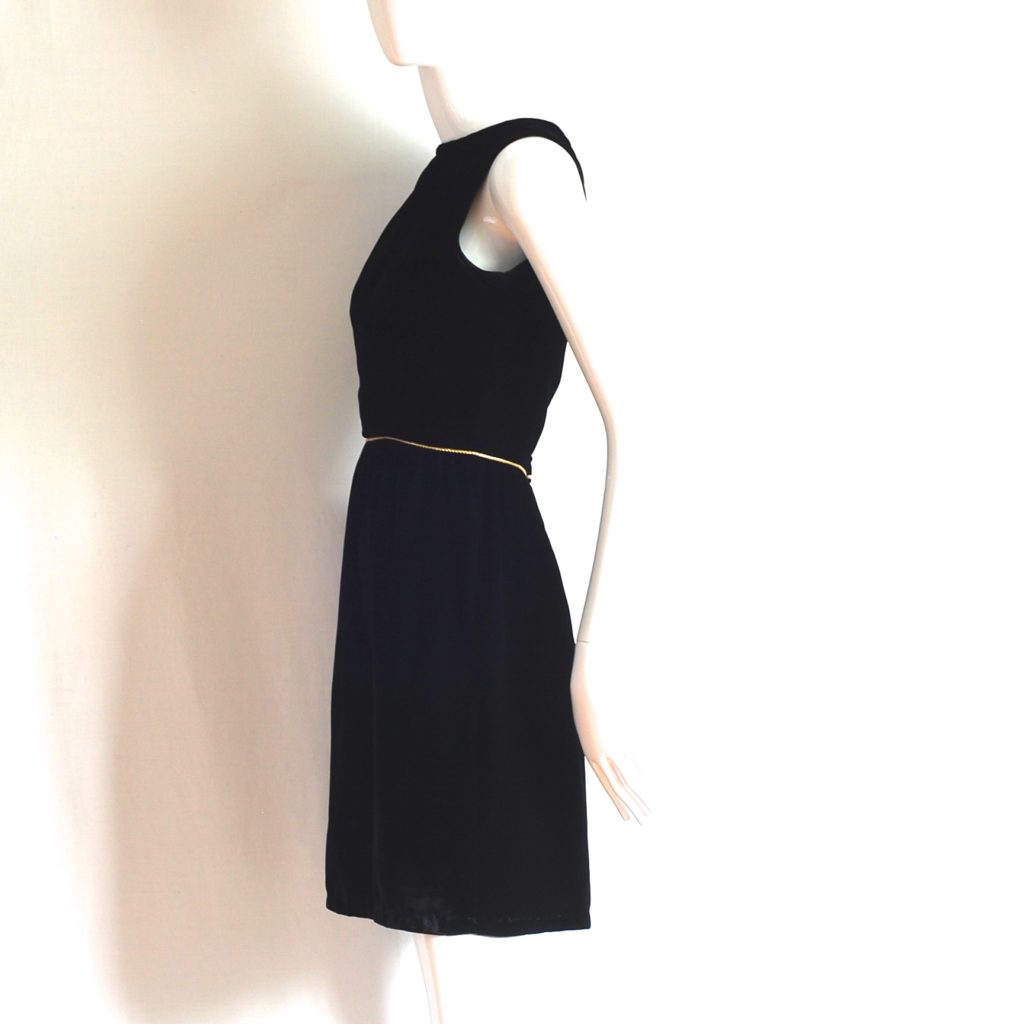
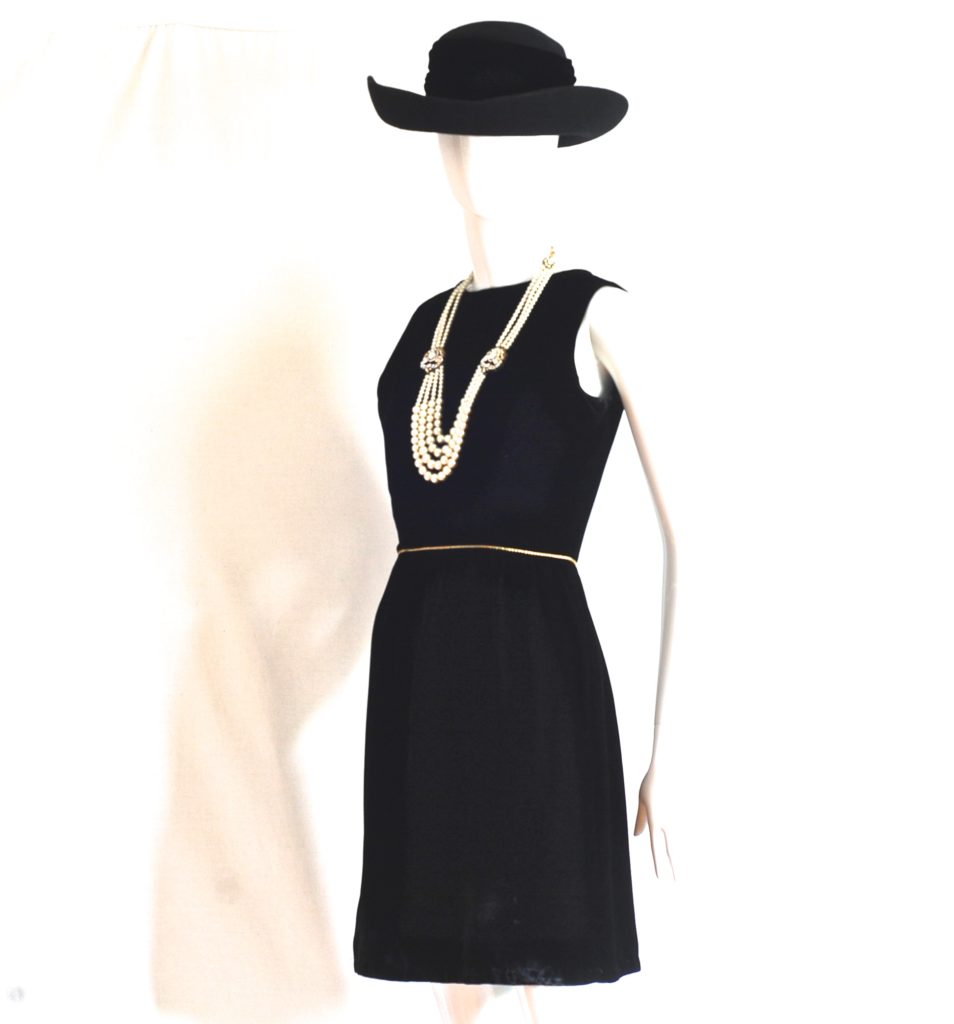
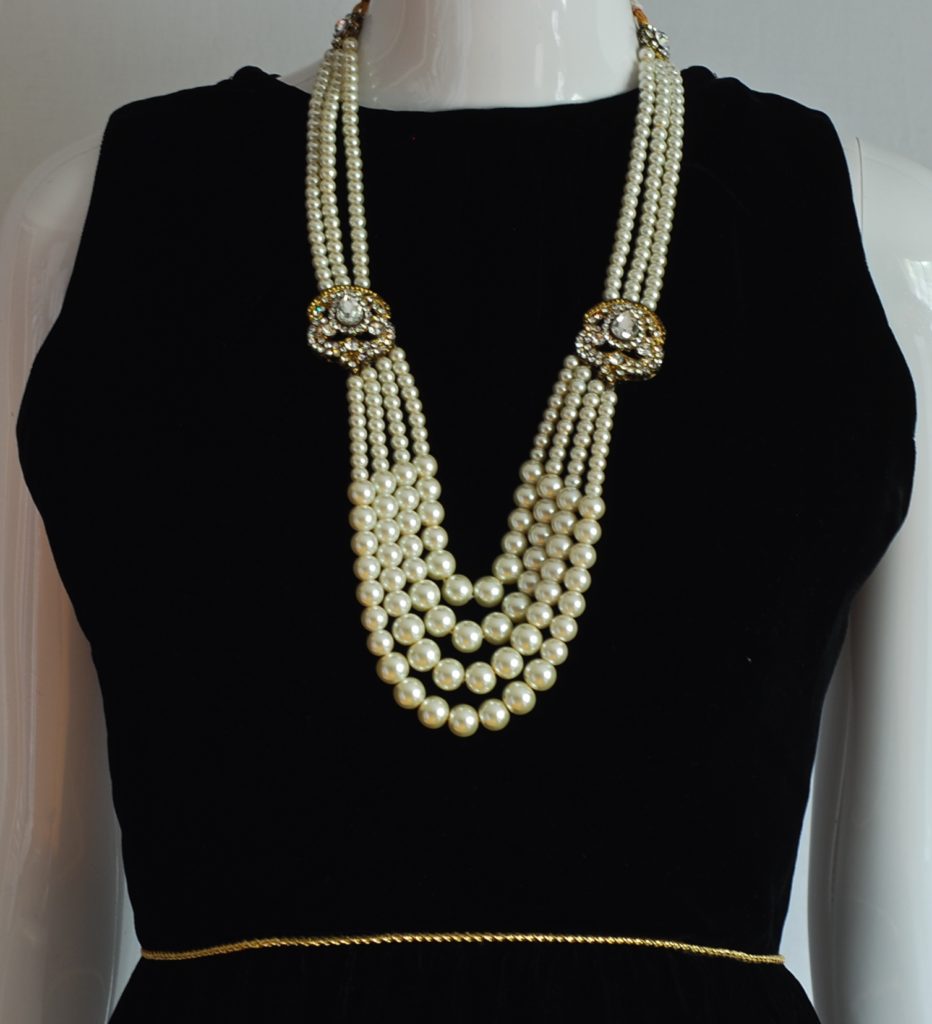
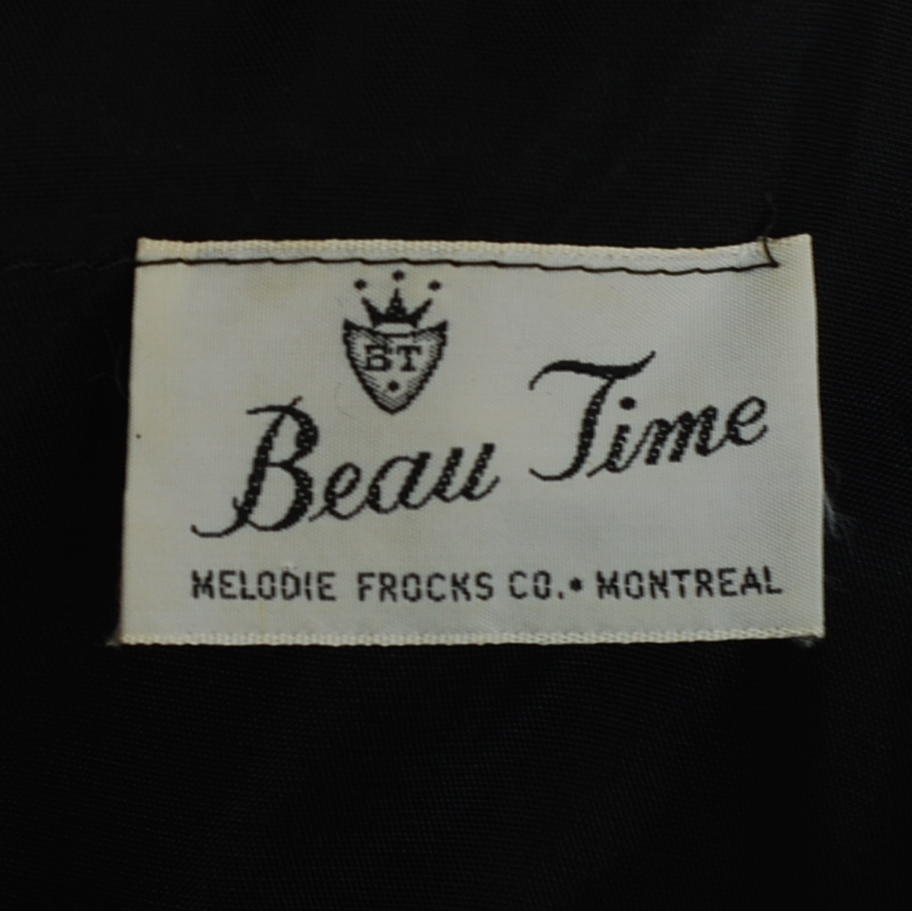
An impressive 1950’s full circle skirt by Montreal designer Val Hughes.
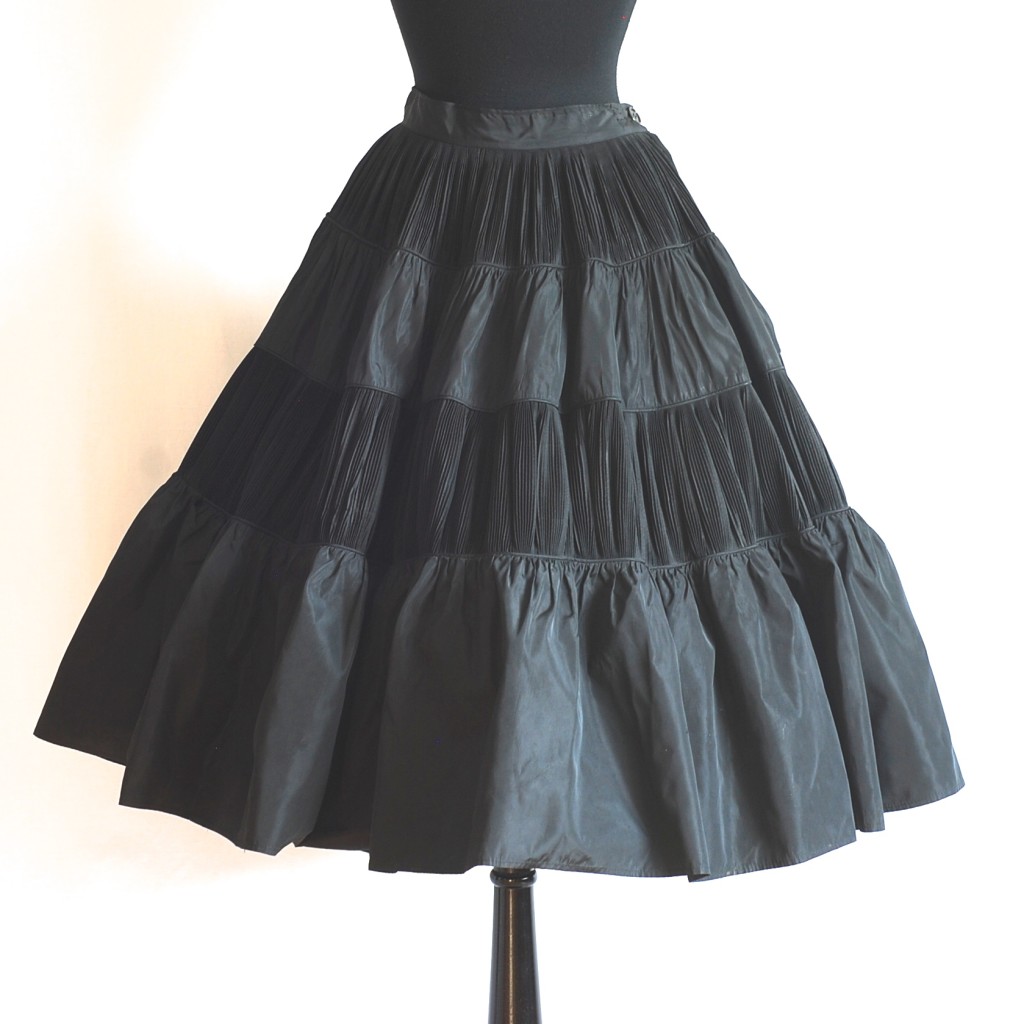
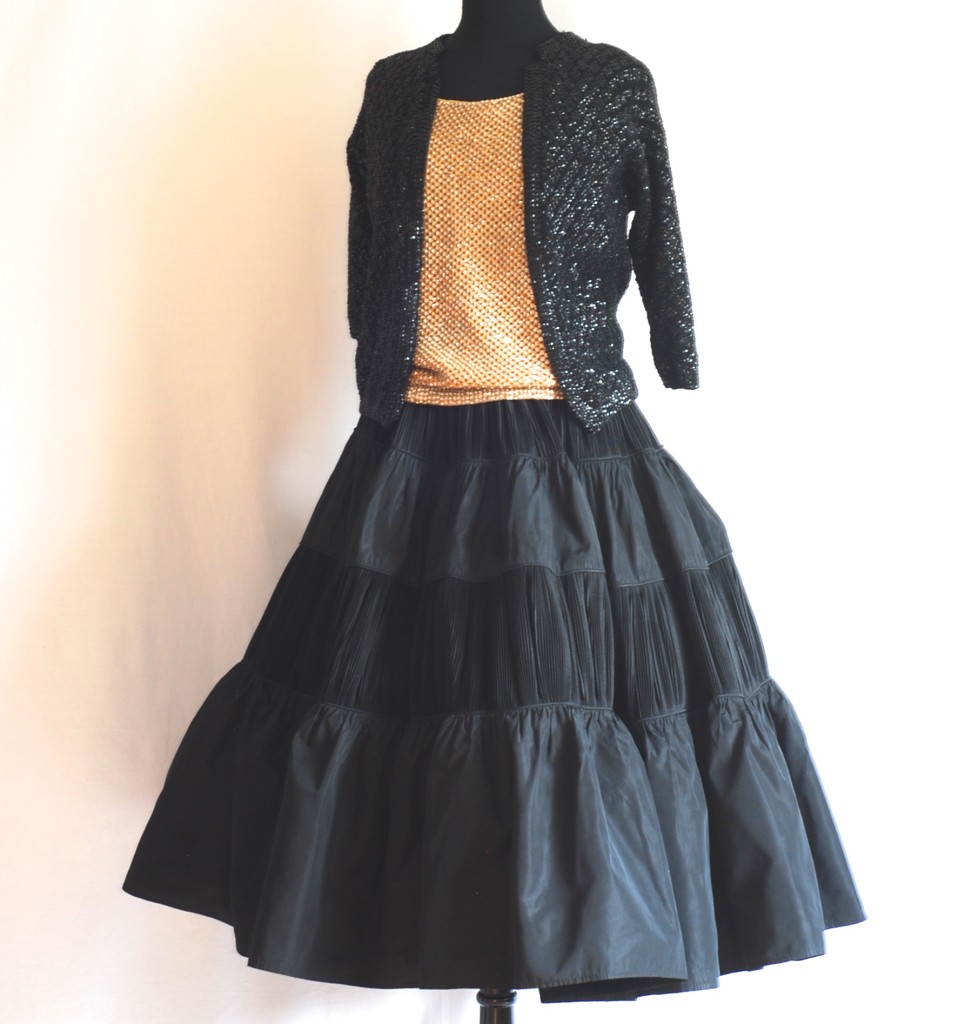
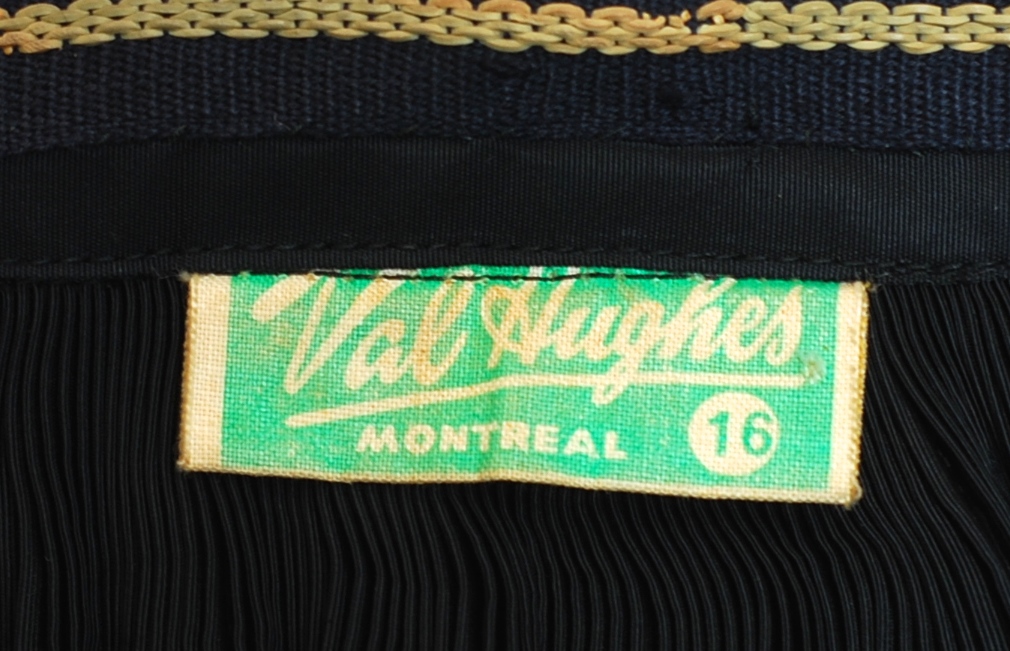
To end the series on a brighter note, this very artistic, abstract printed silk skirt, is labelled Cocktail Montreal. Thanks to these fabulous and talented designers of the eras – they put Canada on the runway, when it comes to mid-century chic.
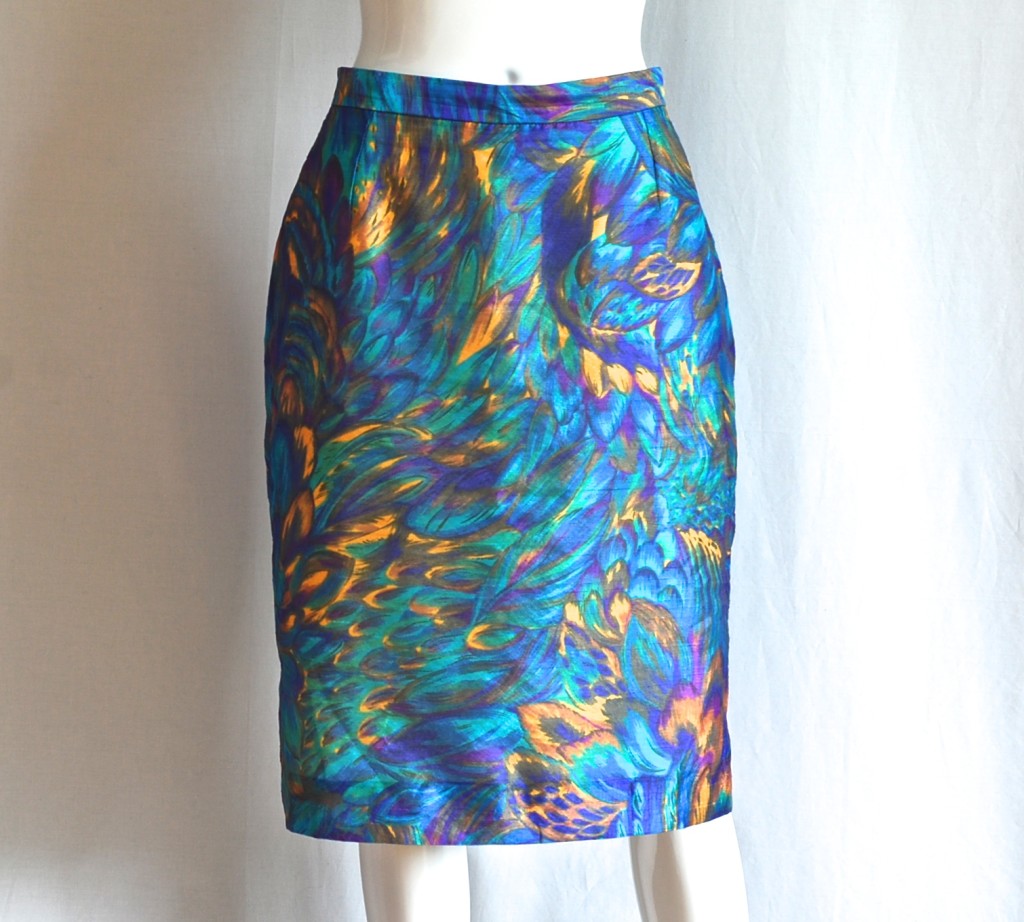
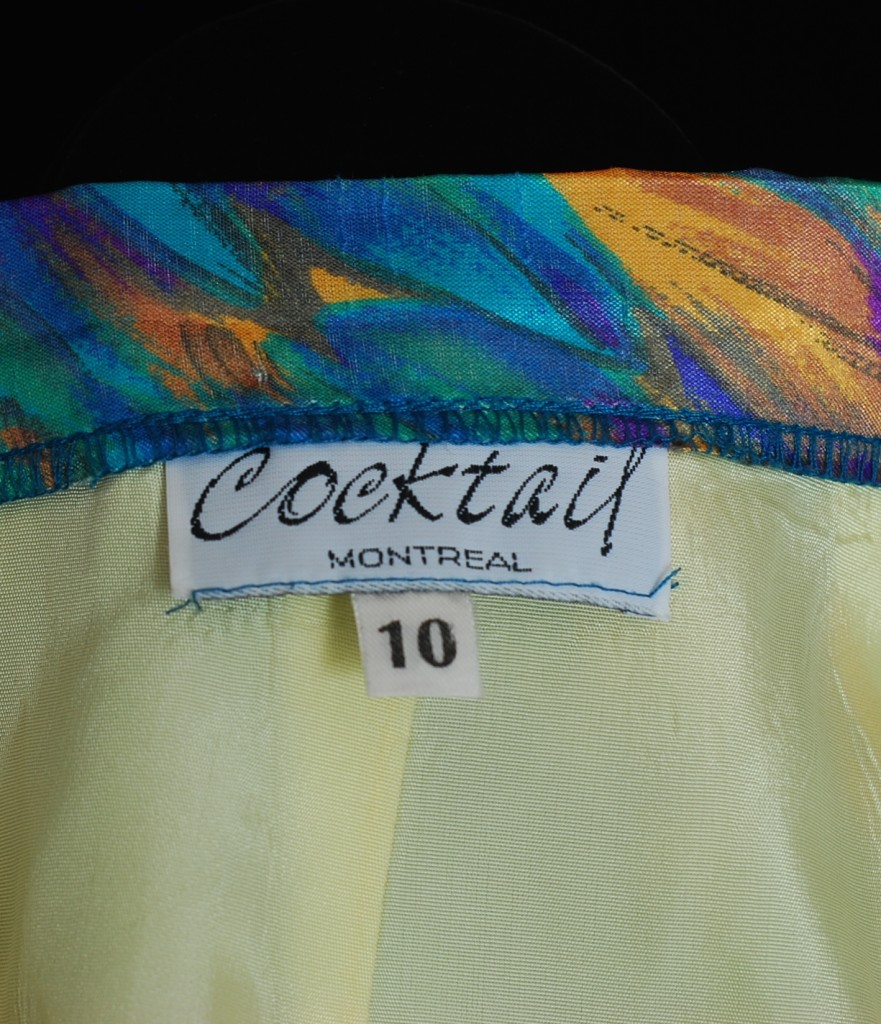
July 4, 2016
| Valerie Hayes
| Business & Web Development, Designer History, Fashion Research, Feature Articles, View All Articles & Photos, Vintage Hats
These wonderful hat designs are mid-century Canadian, made in Montreal and Toronto:
Lilliput, Toronto feathered fedora with velvet accents.
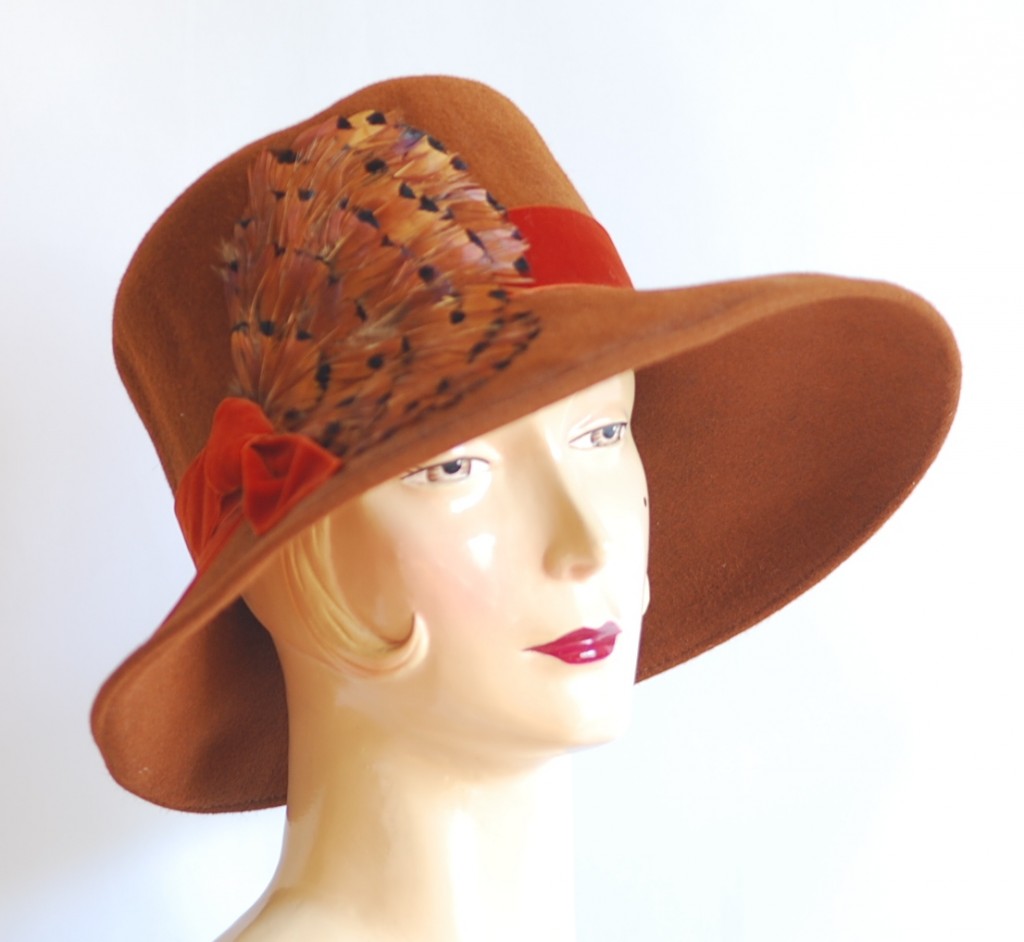
Lilliput Feathered Vintage Fedora – Toronto, Canada
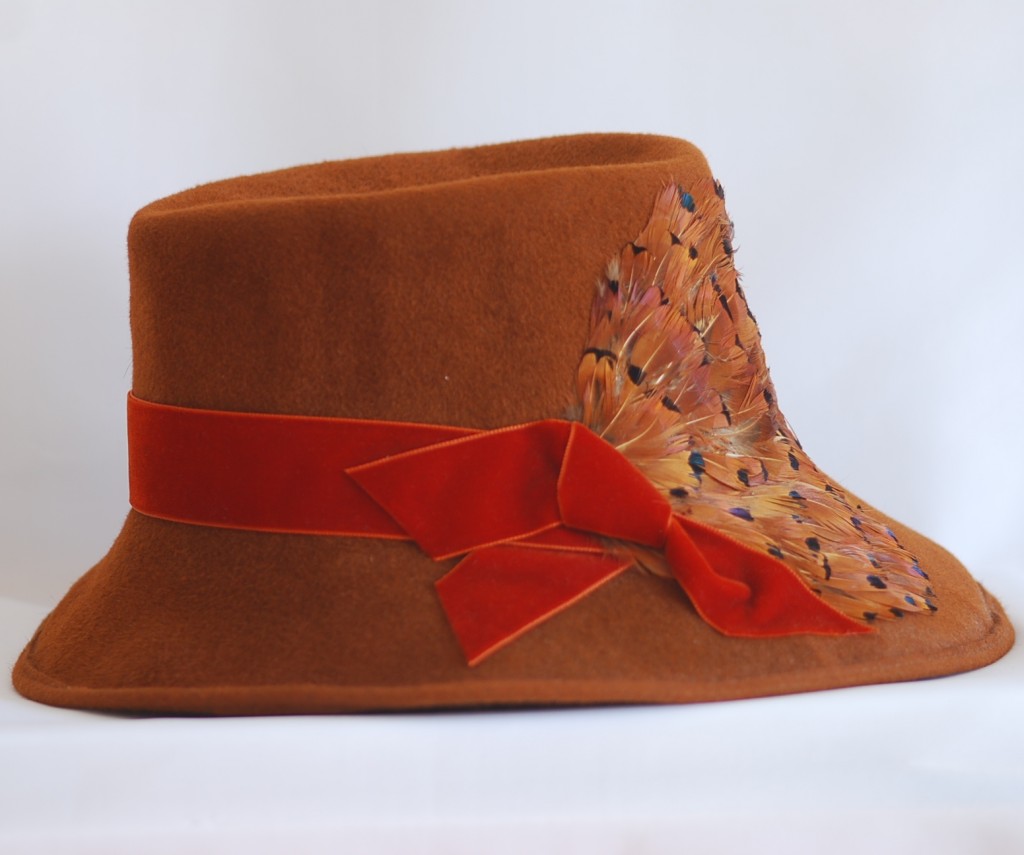
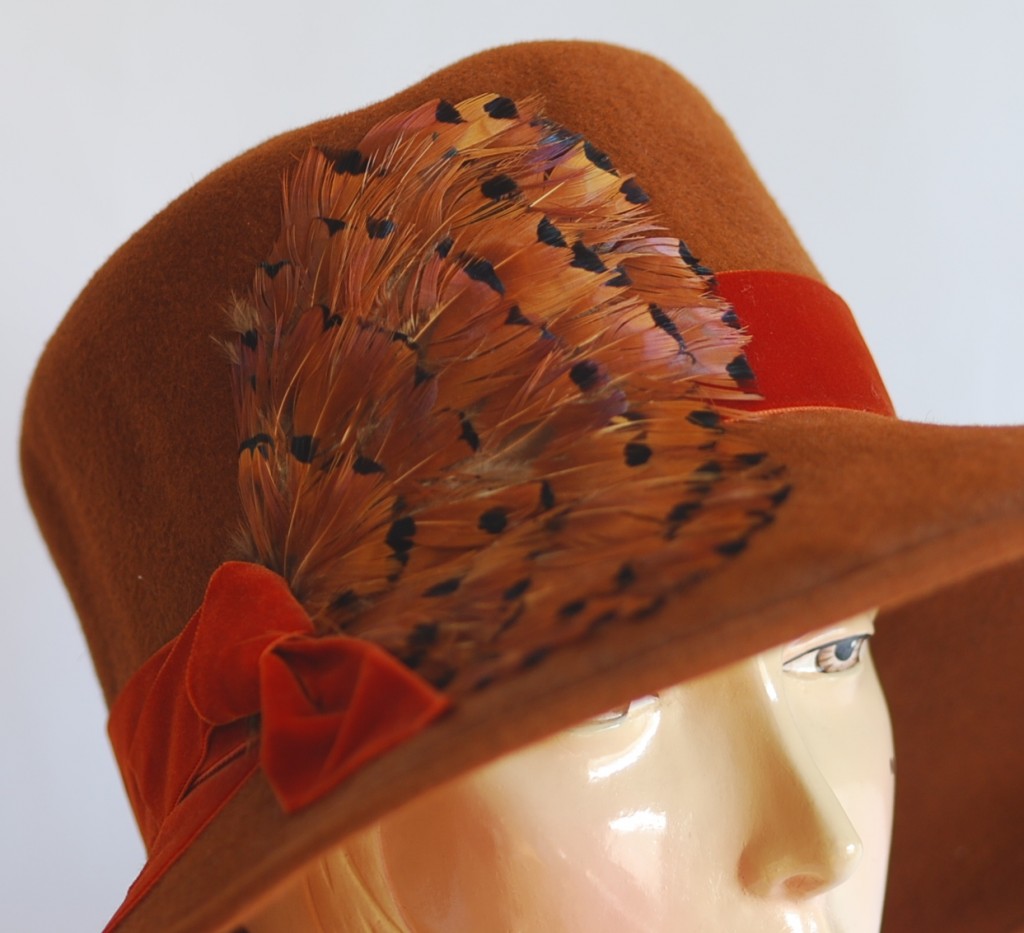
Featuring Nadelle, Montreal 1960’s velvet lampshade hat, and Nadelle 1960’s elaborate beaded turban.
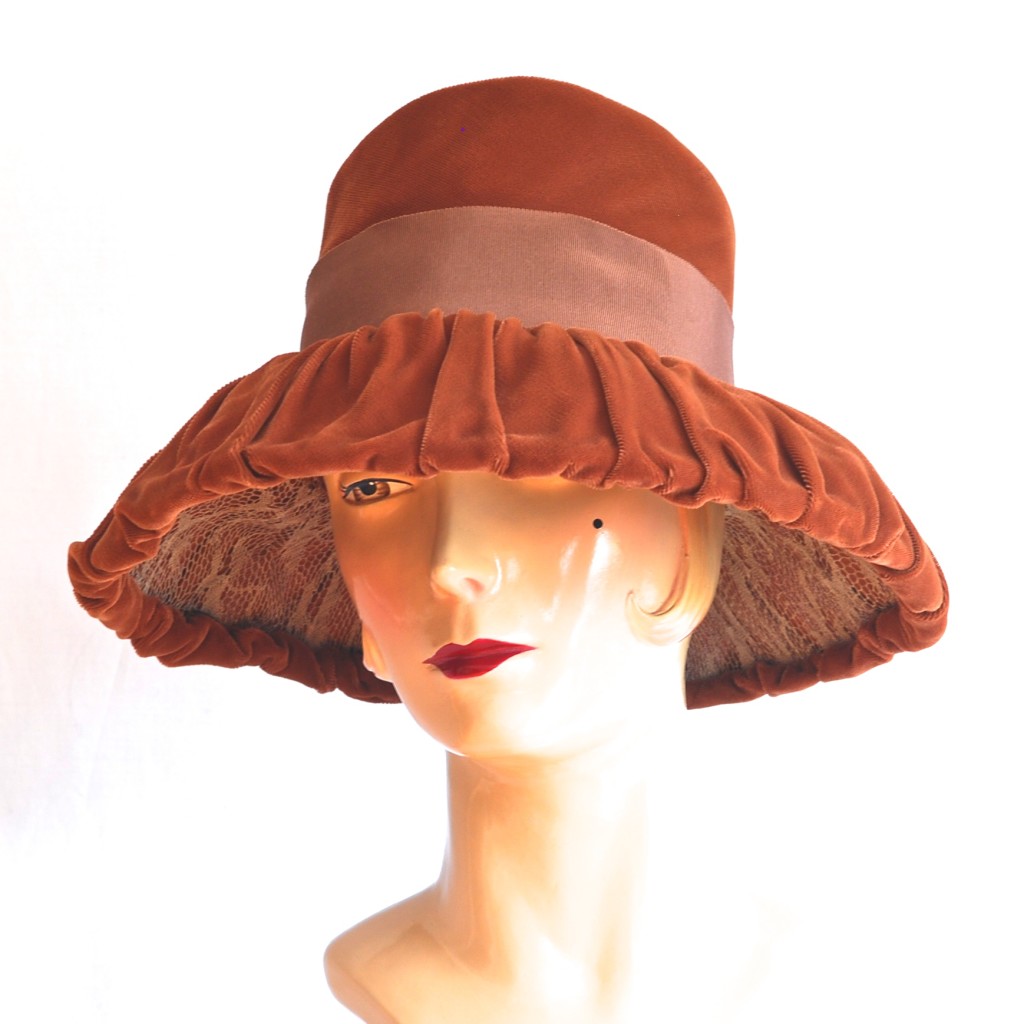
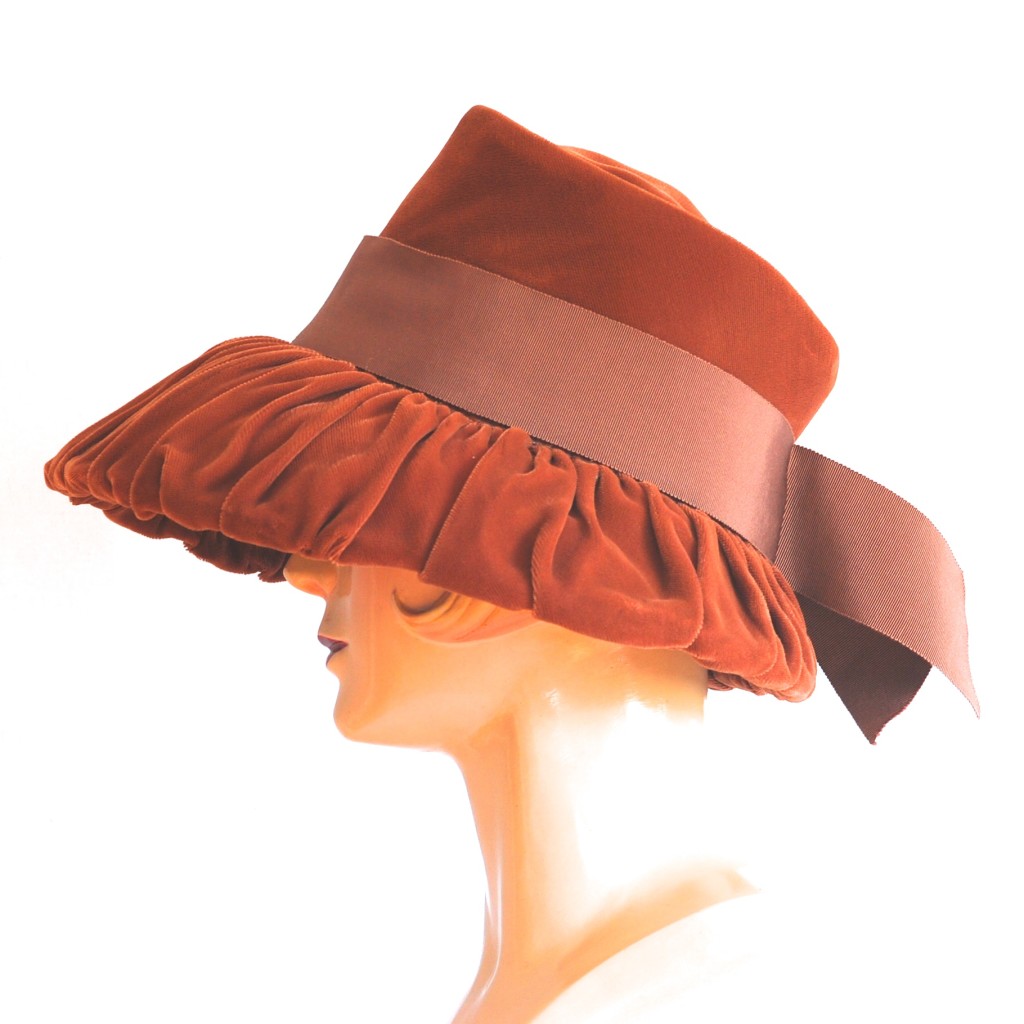
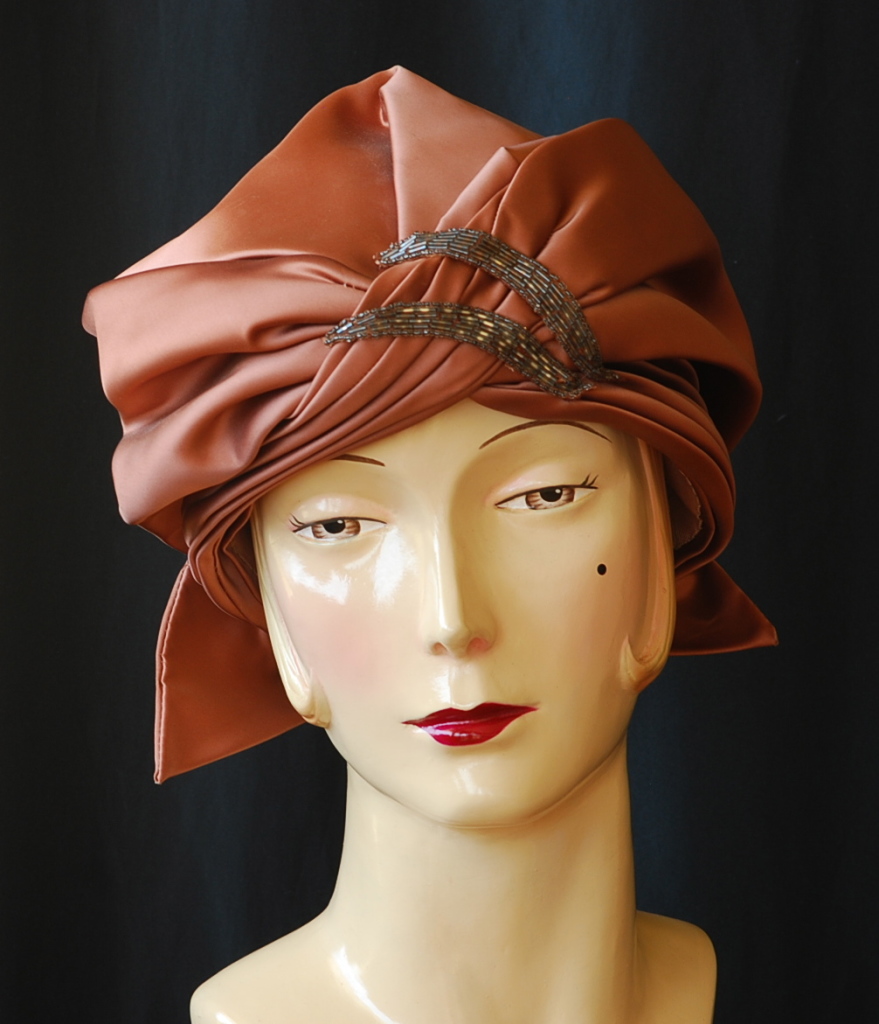
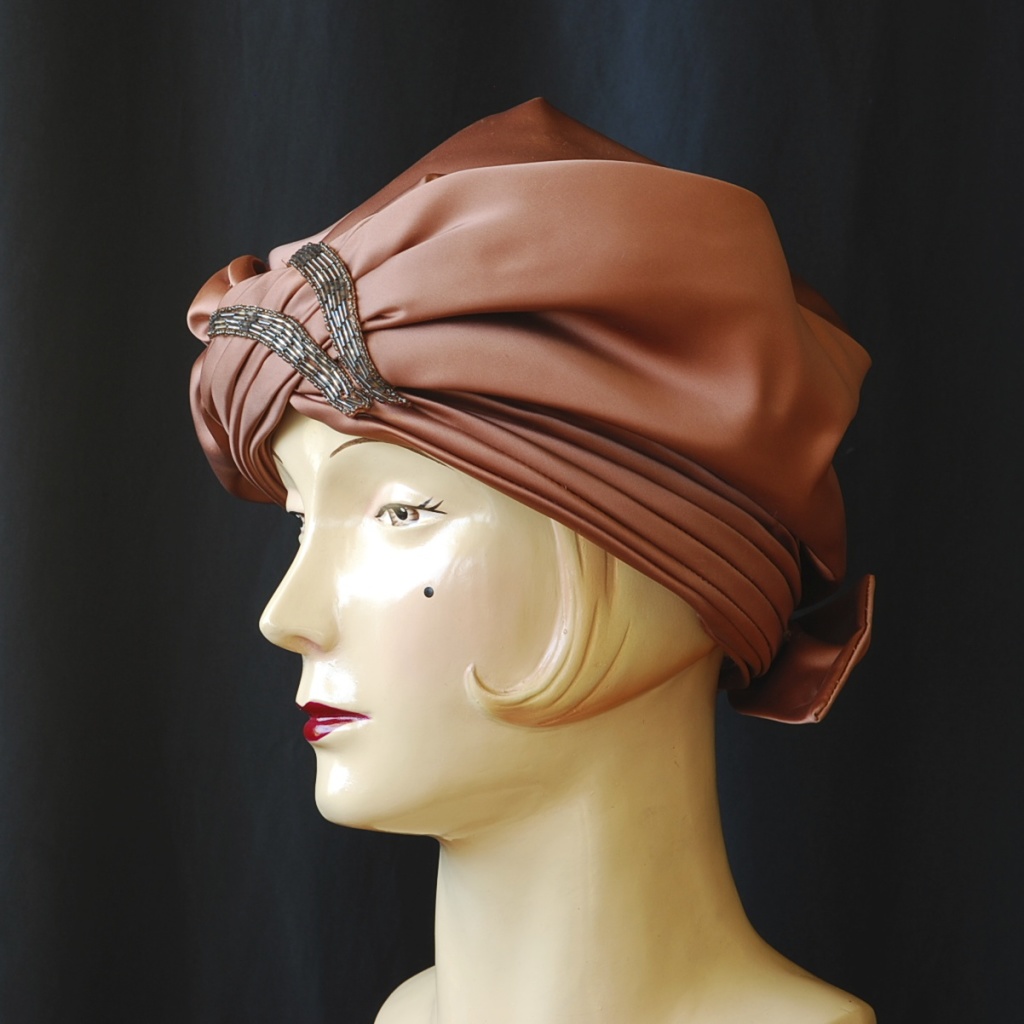 Leopold Original, Toronto 1960’s Velvet Hat With Big Satin Bow.
Leopold Original, Toronto 1960’s Velvet Hat With Big Satin Bow.
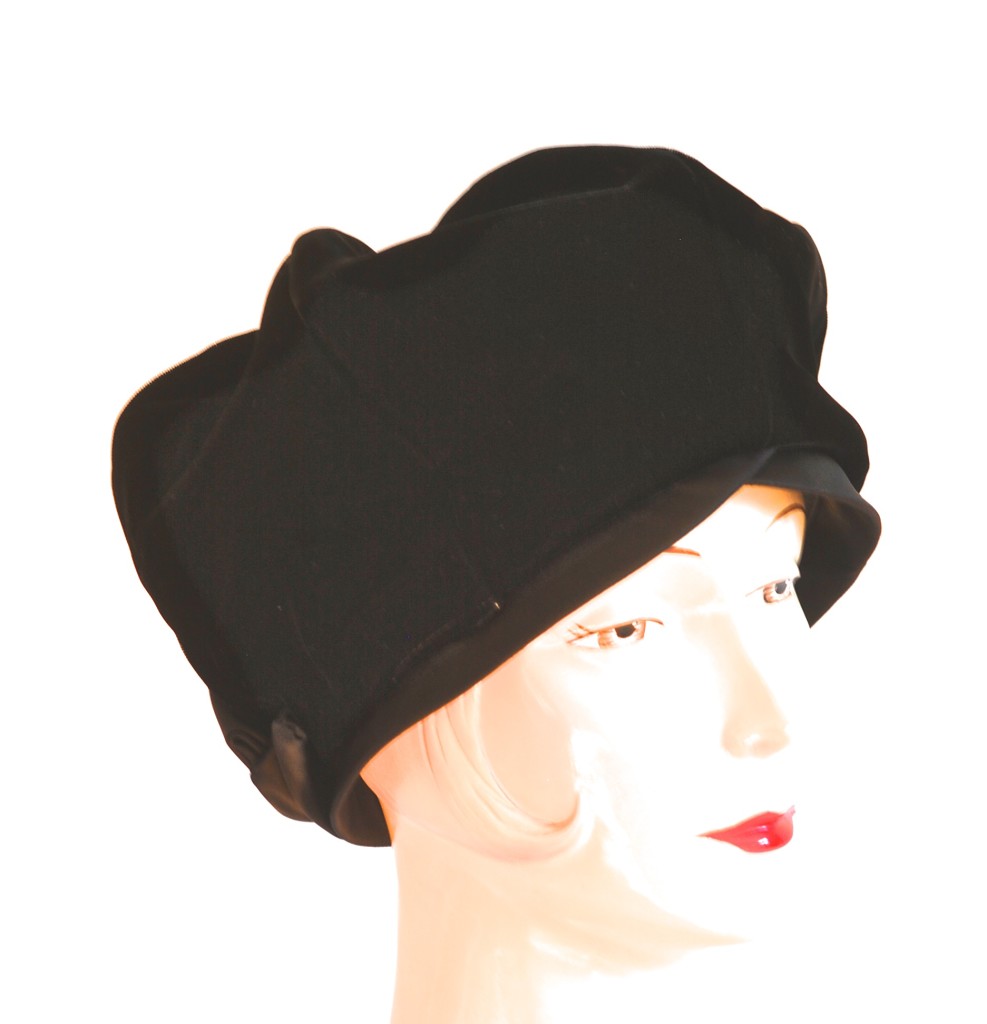
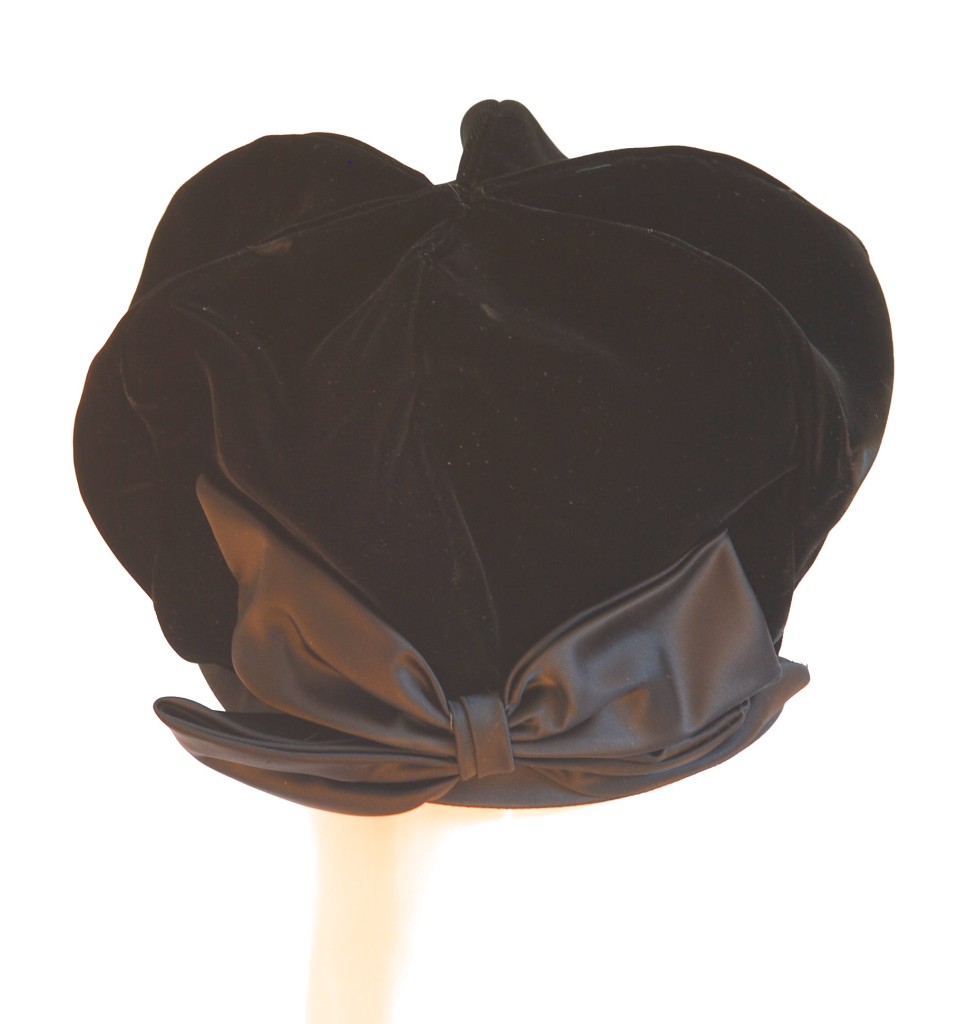 Andre, Montreal 1960’s Gold Brocade Turban.
Andre, Montreal 1960’s Gold Brocade Turban.
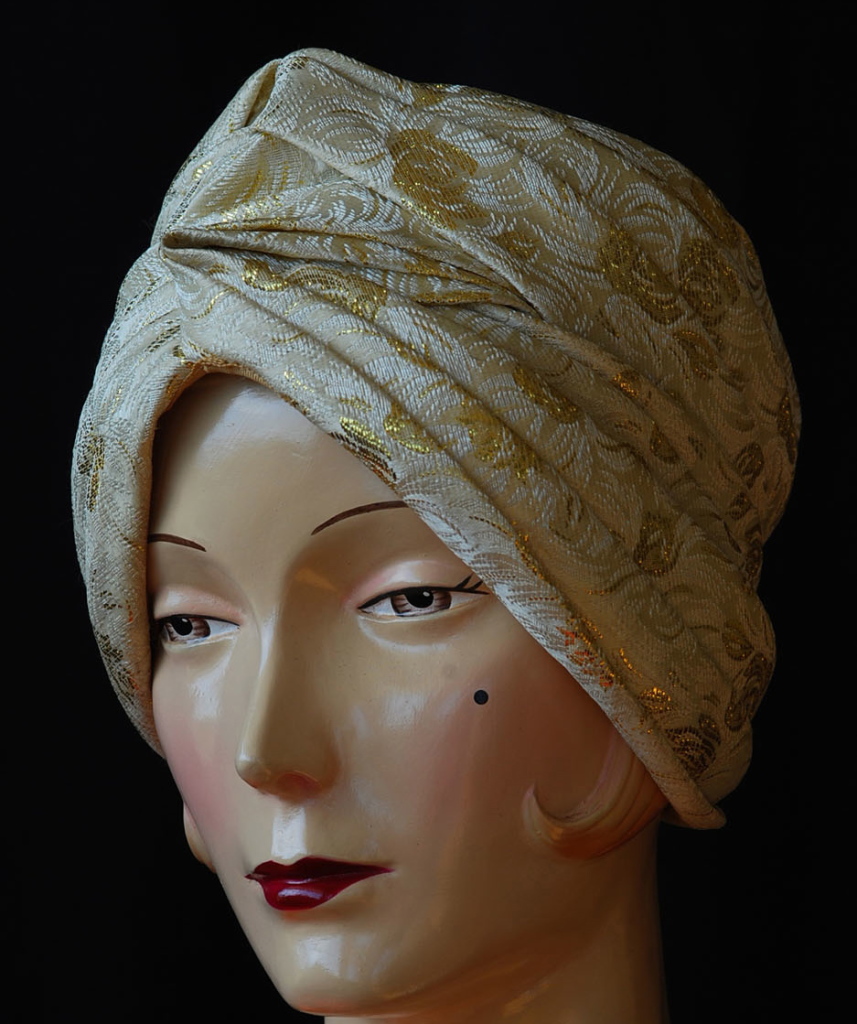
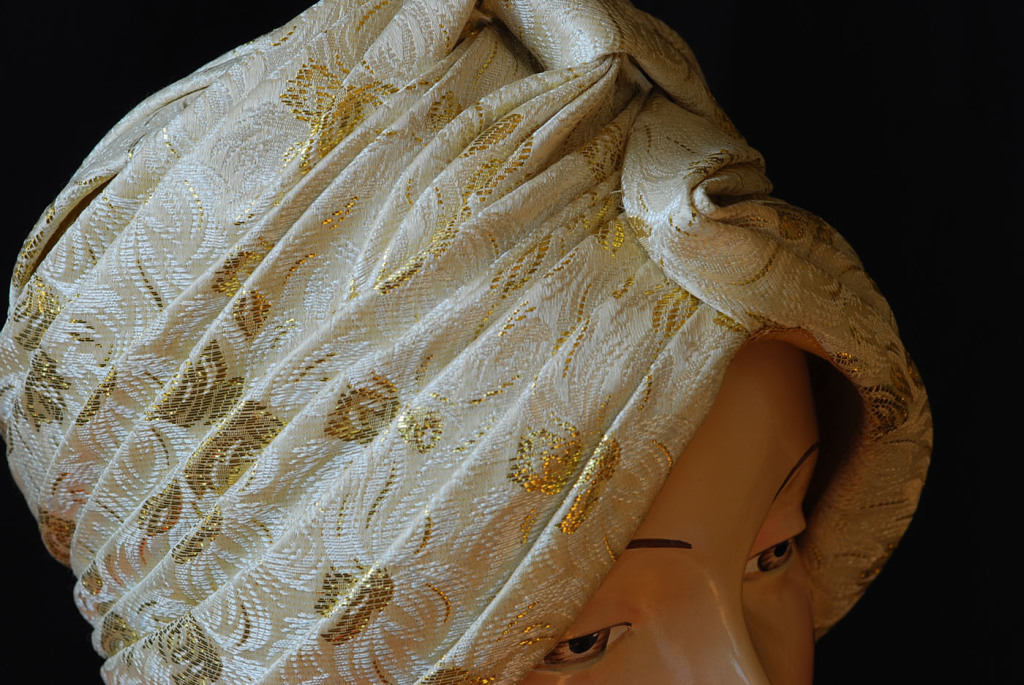 M’Sieu Leon, Montreal 1970’s Beaver Fedora.
M’Sieu Leon, Montreal 1970’s Beaver Fedora.
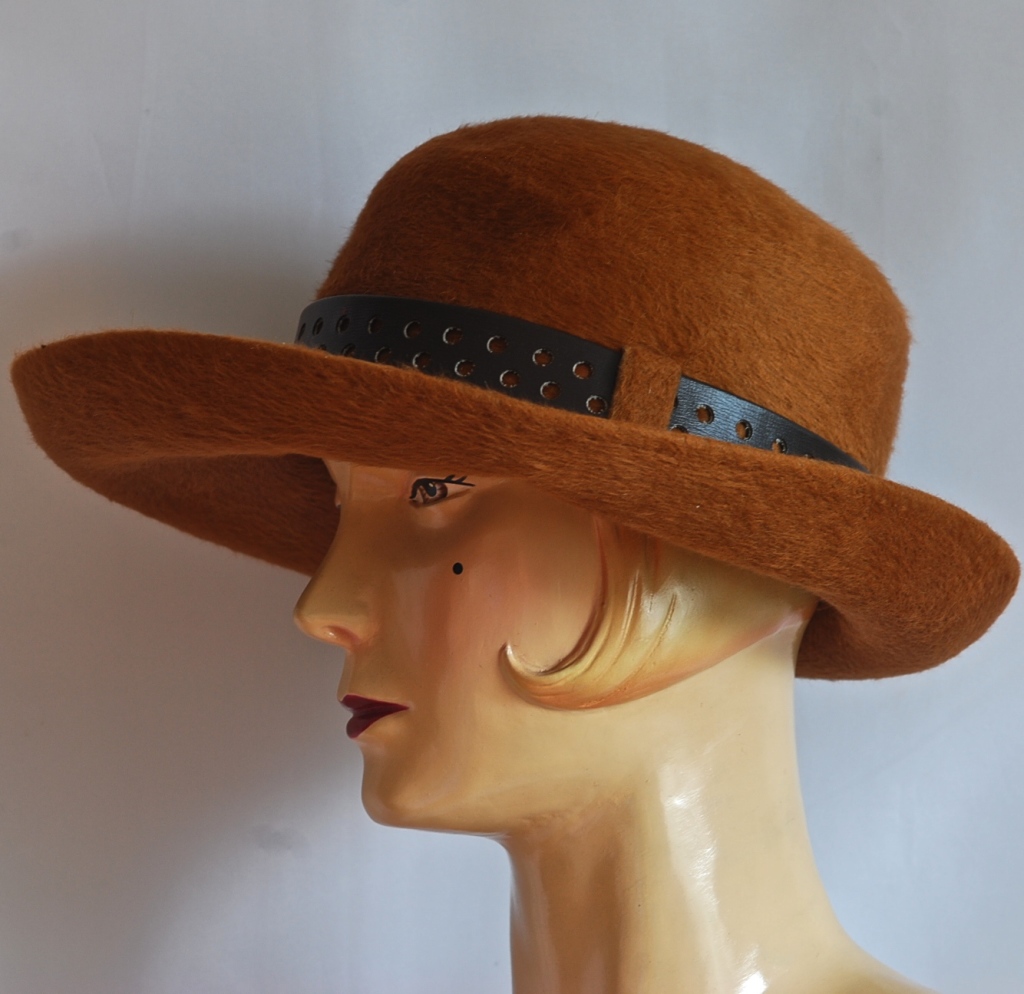
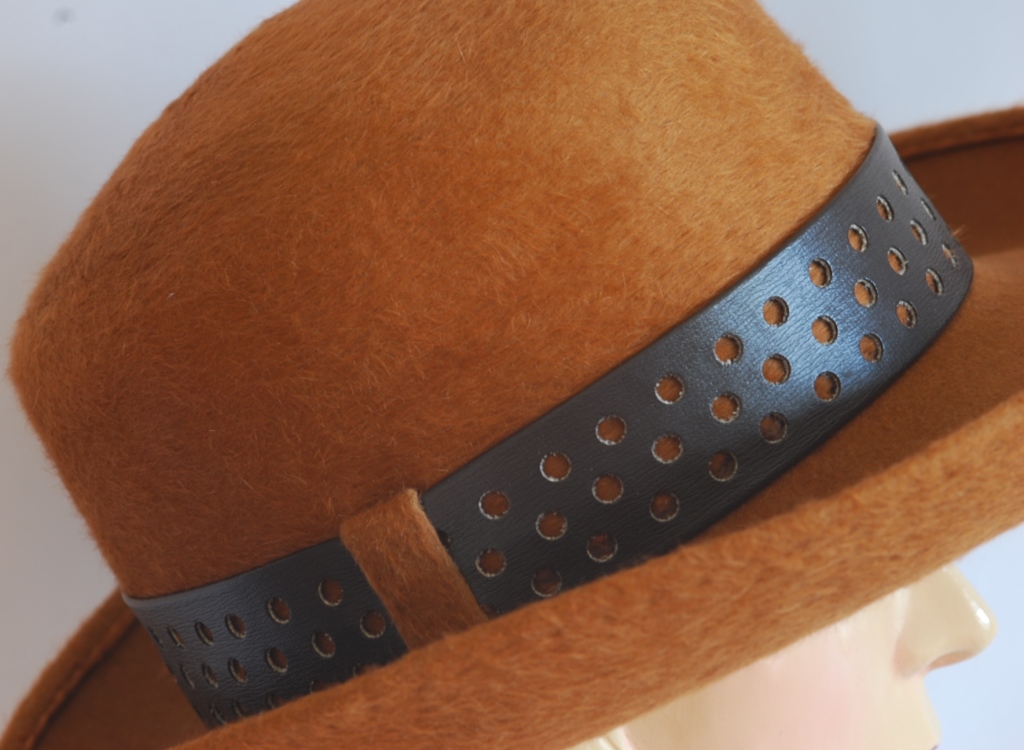
July 3, 2016
| Valerie Hayes
| Business & Web Development, Designer History, Fashion Research, Feature Articles, View All Articles & Photos, Vintage Outfits
This exceptional 1980’s Wayne Clark Couture dress, is made of layered silk chiffon, with rhinestone embellished lace inserts in the bodice, and sheer balloon sleeves. The dress has rows of satin piping down the length of the skirt, satin cuffs, and matching trim on the bottom layers, of an asymmetrical hemline. The back is open, plunging to the waist, and ties at the back of the neck, with a dangling satin ribbon.
For those who love the floating and fluid movement of a silk chiffon skirt, and being well covered; in a pose to behold. Those watching your back, will know… A Wayne Clark dress – is worth its weight in the folds!
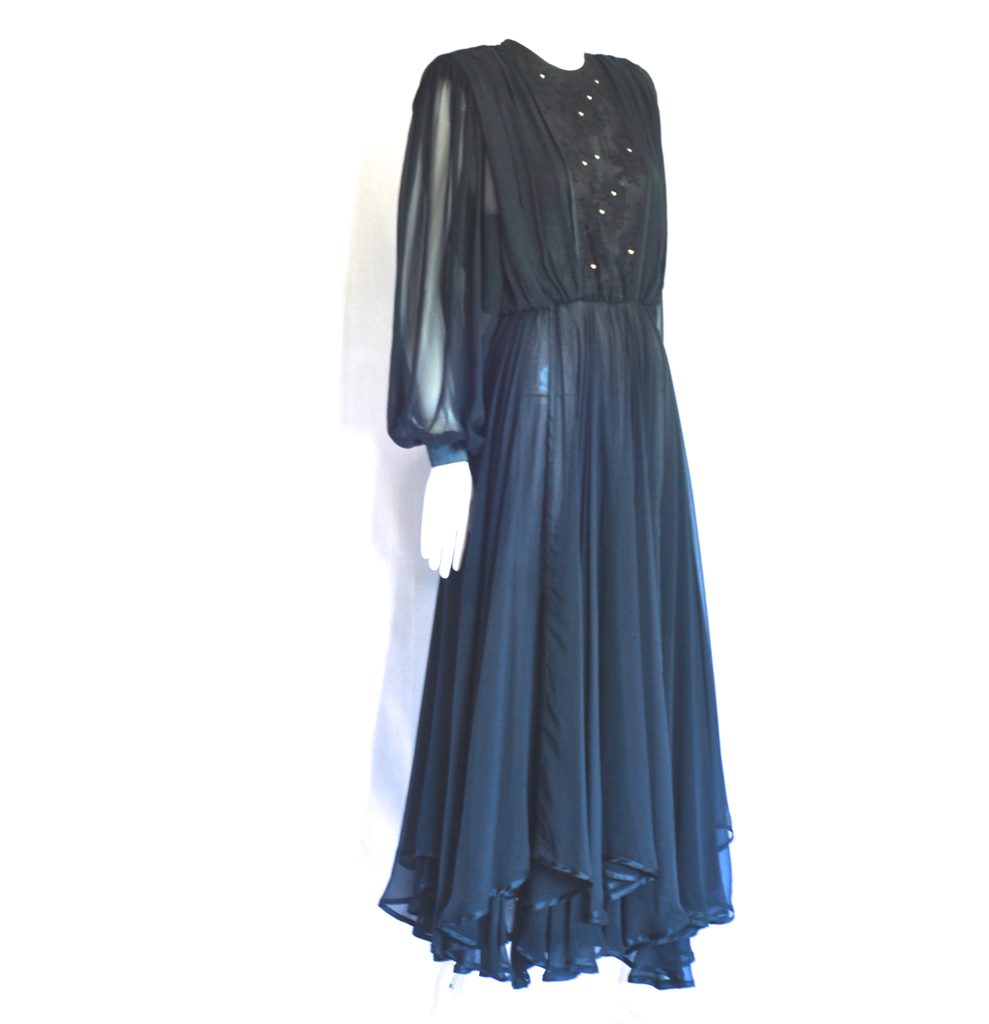
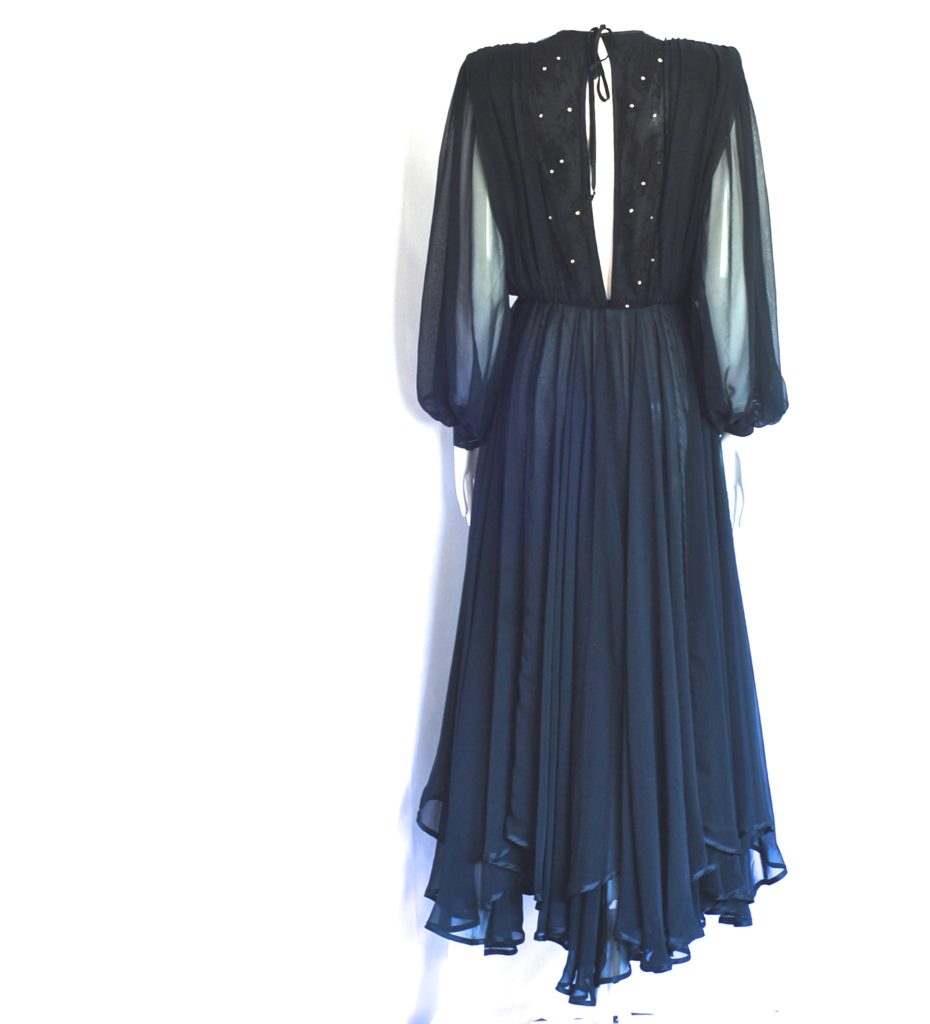
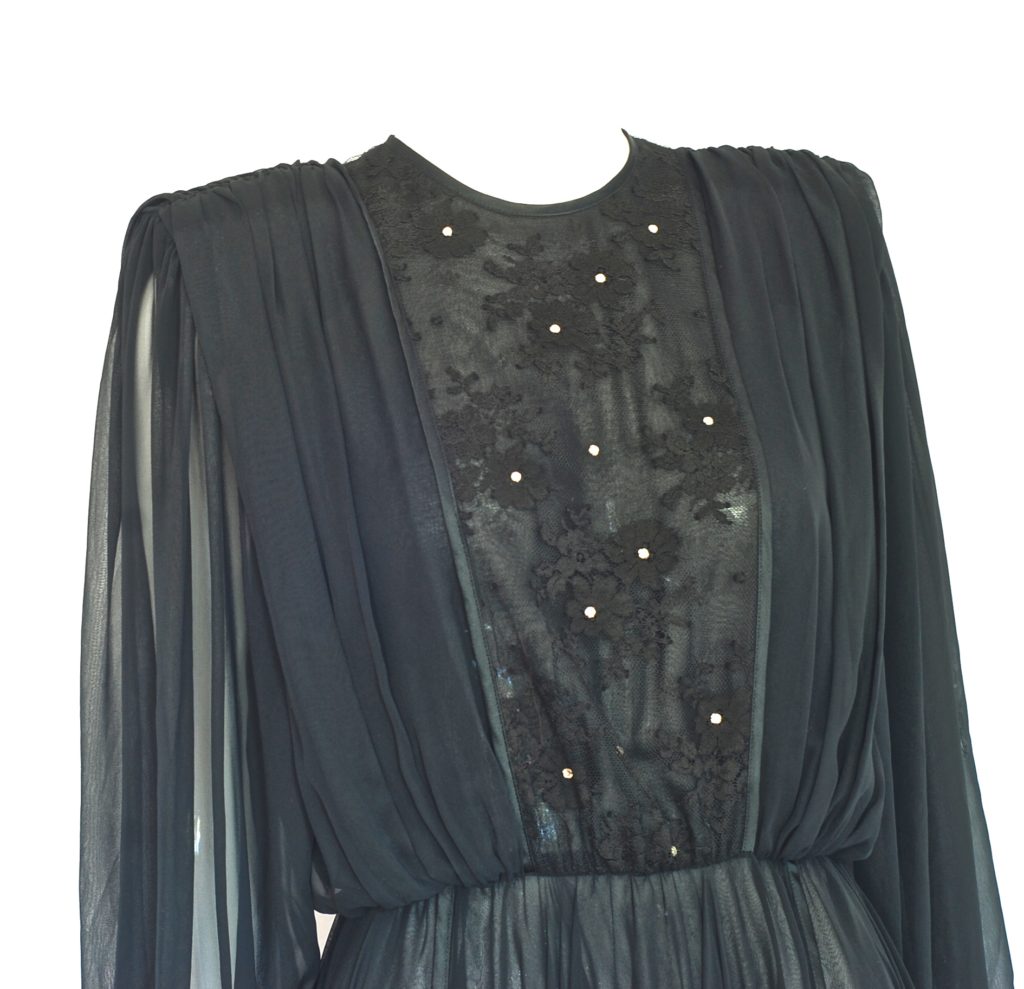
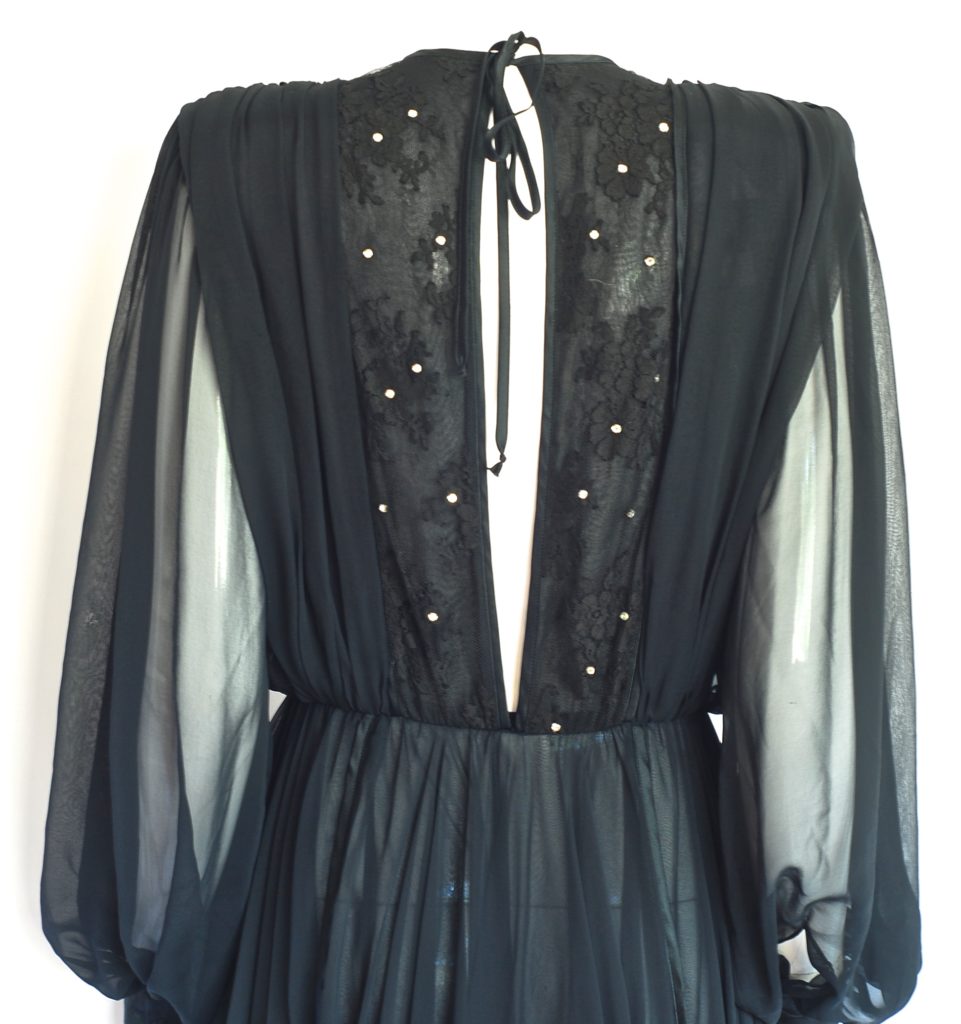
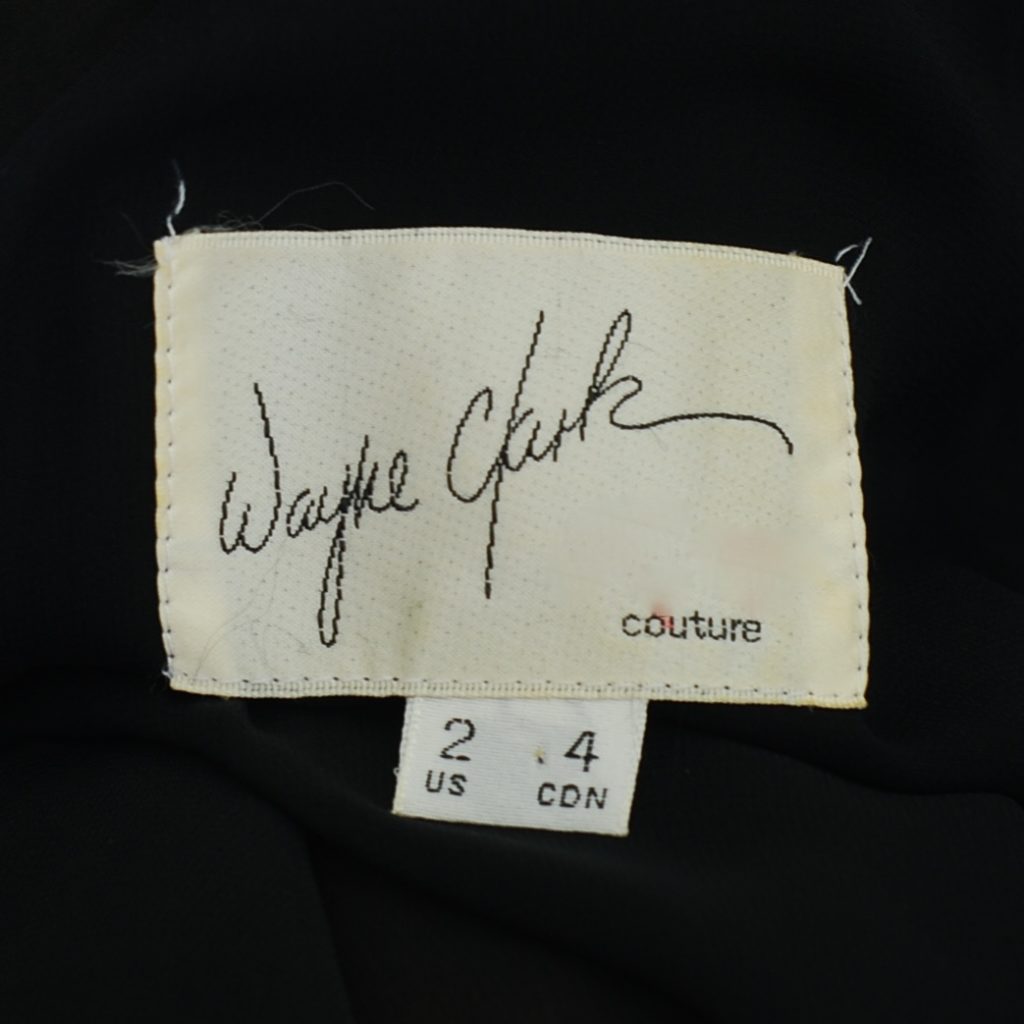
July 3, 2016
| Valerie Hayes
| Business & Web Development, Designer History, Fashion Research, Feature Articles, View All Articles & Photos, Vintage Jewelry
Gustave Sherman of Montreal made costume jewellery from 1947-1981. The company logo was “made to last a lifetime”. He sourced out, and used the highest quality Swarovski crystals, and set very high production standards. The backing on Sherman jewellery is heavily rhodium plated, japanned, or sterling. The stones are brilliant, cut with precision, into narrow marquise stones, with cluster elements, and stunning designs. Sherman jewellery lasts to this day, and will last much longer, therefore the jewellery was made to last more than one lifetime.
Sherman jewellery has always been recognized as high end costume jewellery, and was sold through luxury retailers and jewellery stores. The jewellery continues to be highly collectible. Certain pieces, in particular full sets, and the colour Siam red, command high prices, and have set off bidding wars on Ebay. Gustave Sherman passed away in 1984. His legacy, and commitment to the highest standards in craftsmanship, has left us with sparkle and shine – to wear and to admire, for many years to come. From the Quiet West collection, the following are some fine examples of the lasting quality in Sherman jewellery.
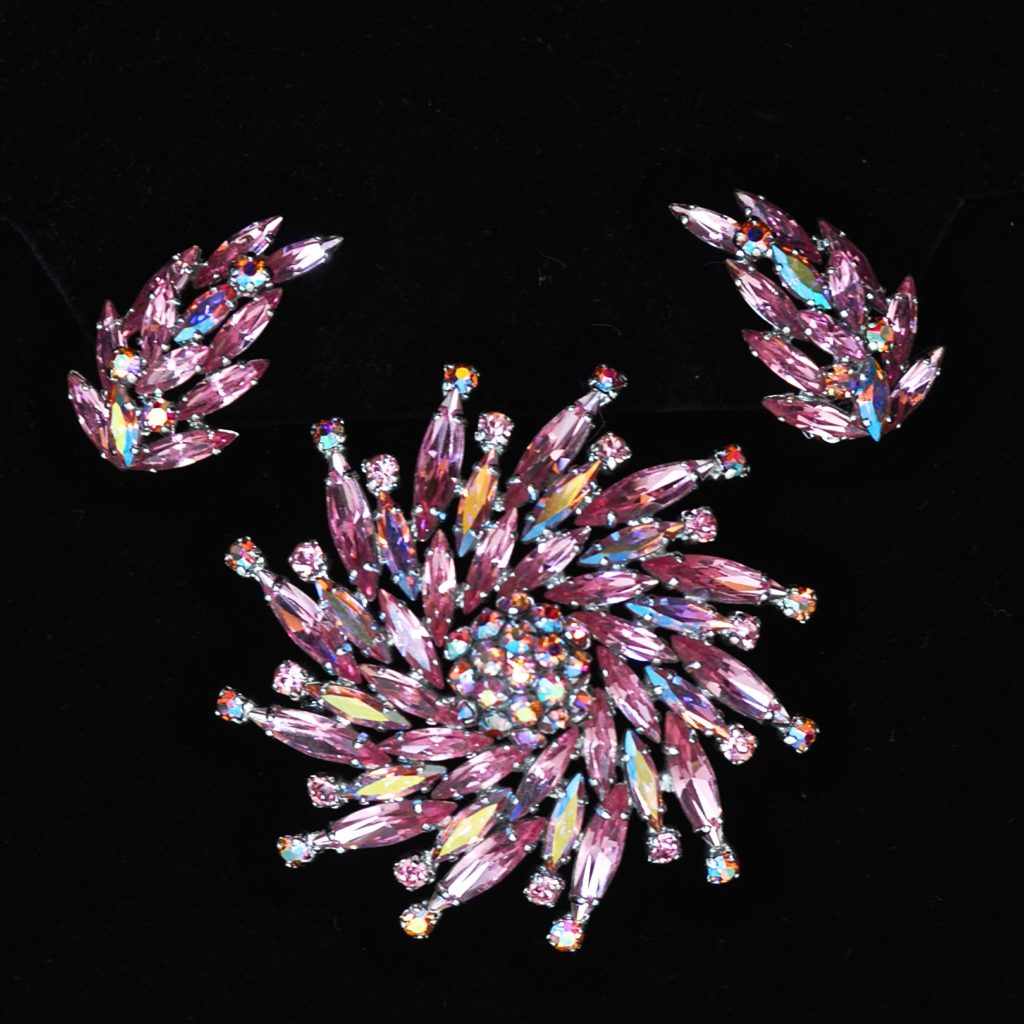
Sherman Pink Earrings & Matching Pin
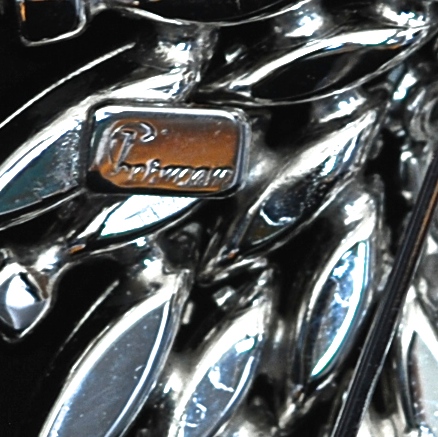
Sherman Script Signature
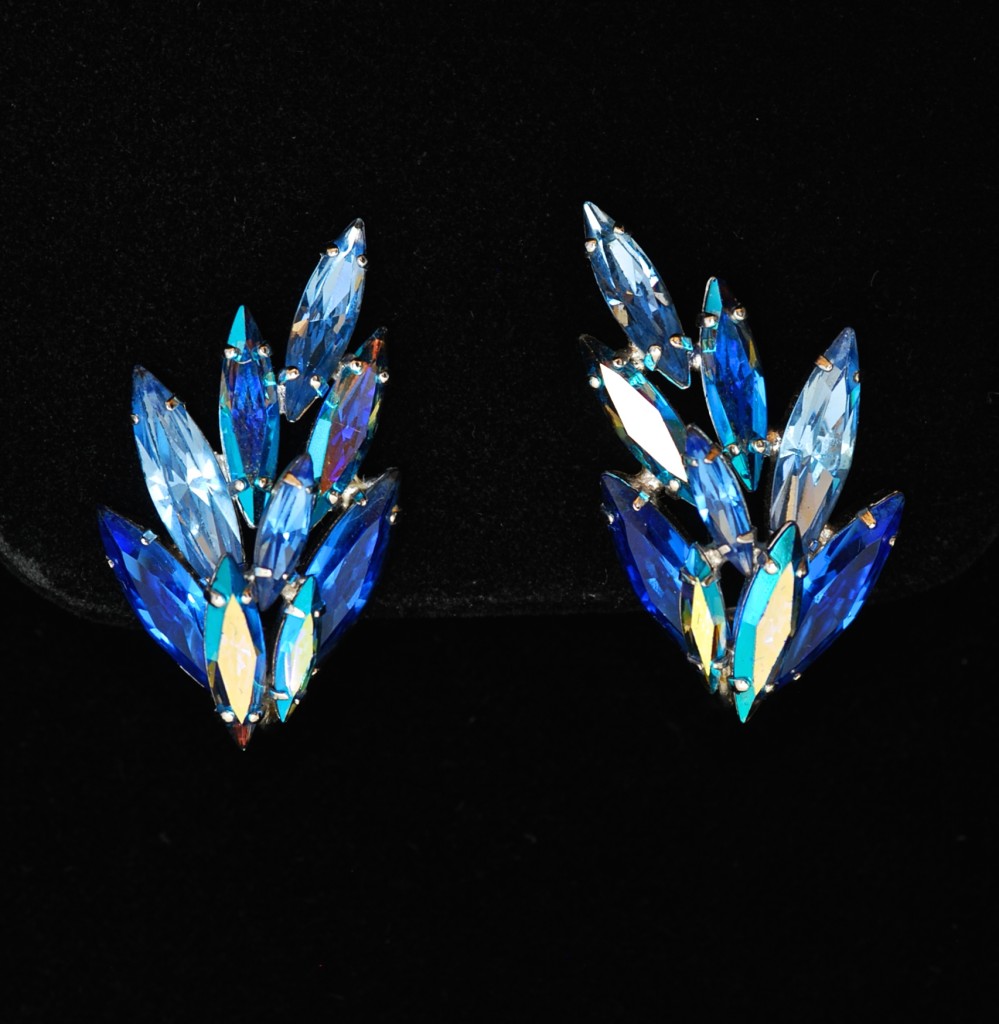
Sherman Earrings With Blue Marquise Cut Stones
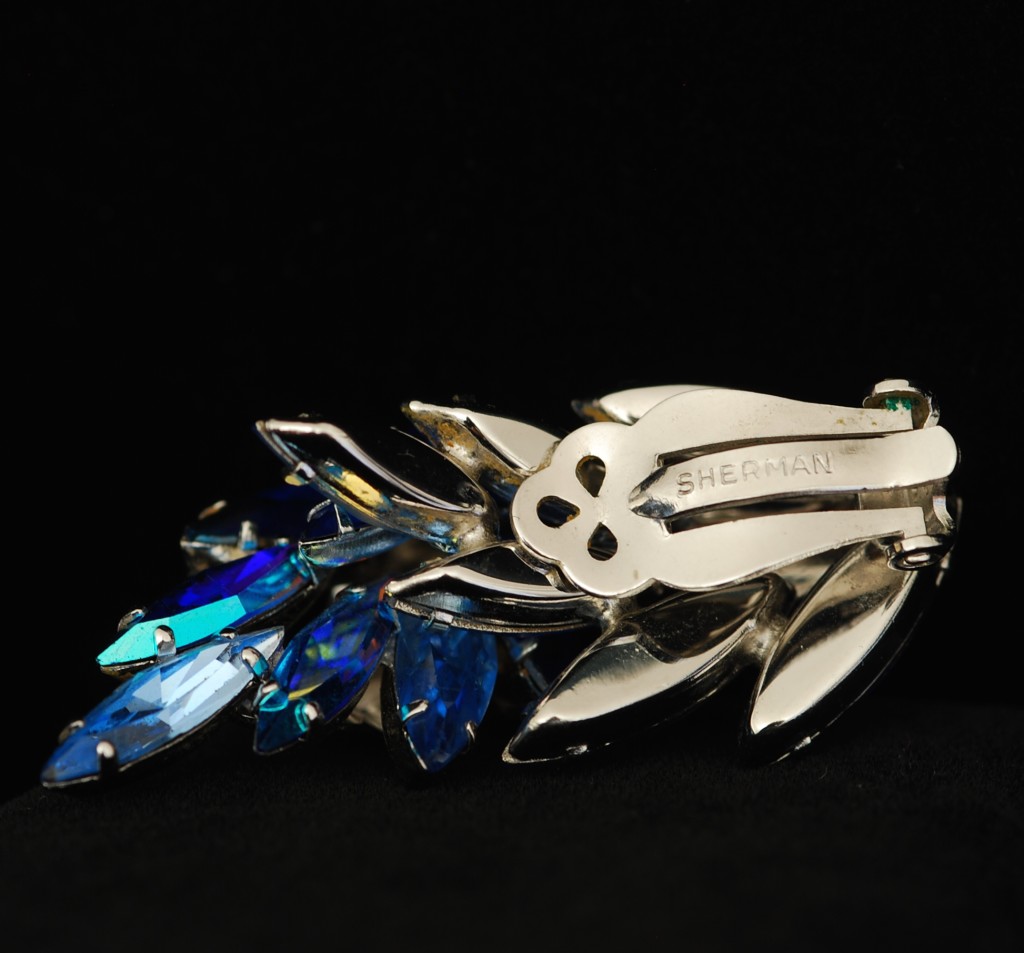
Sherman Signature in Block Letters
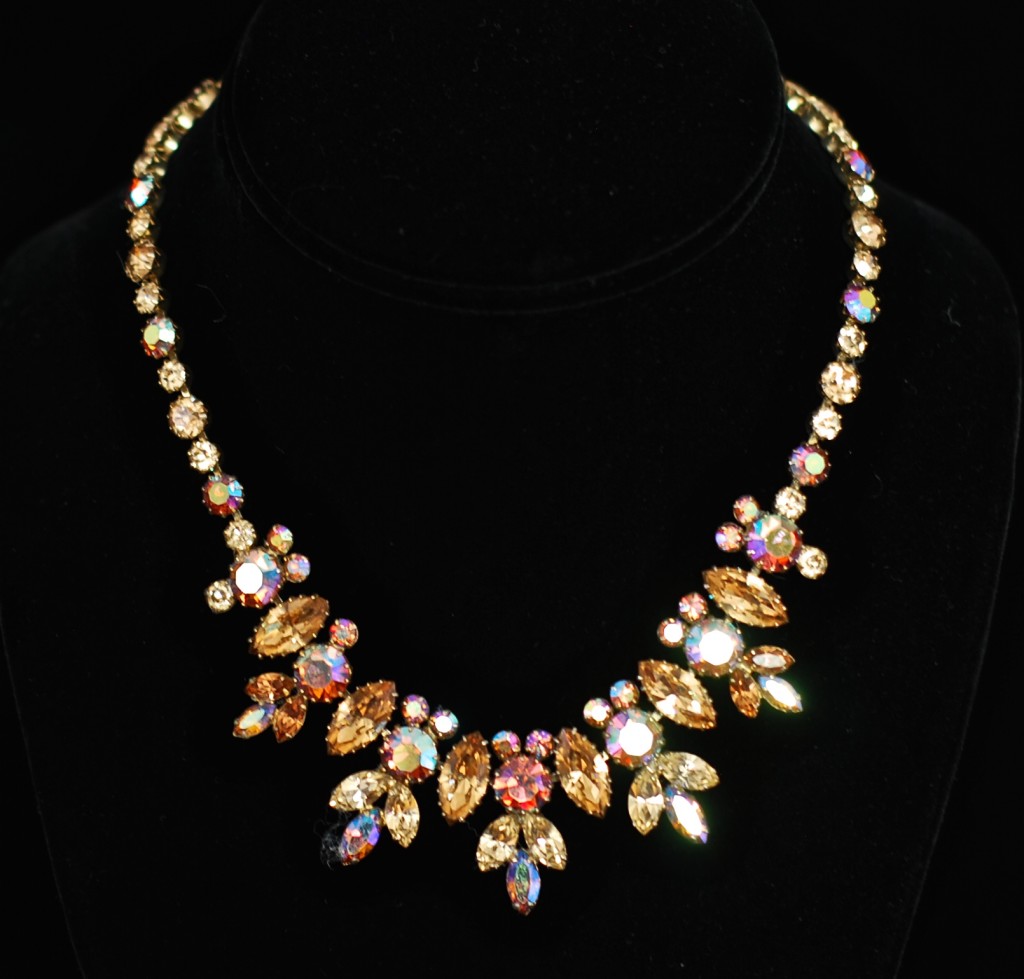
Gustave Sherman Stunning Vintage Necklace
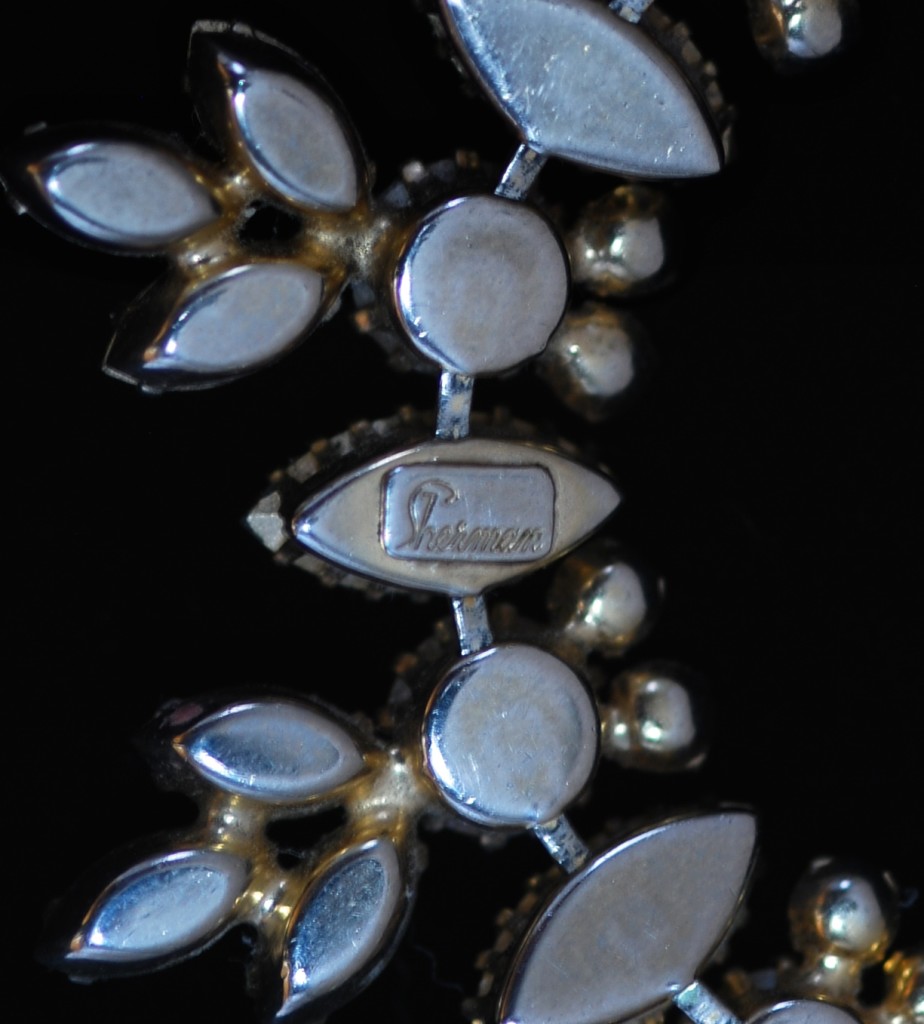
Sherman Signature On Necklace
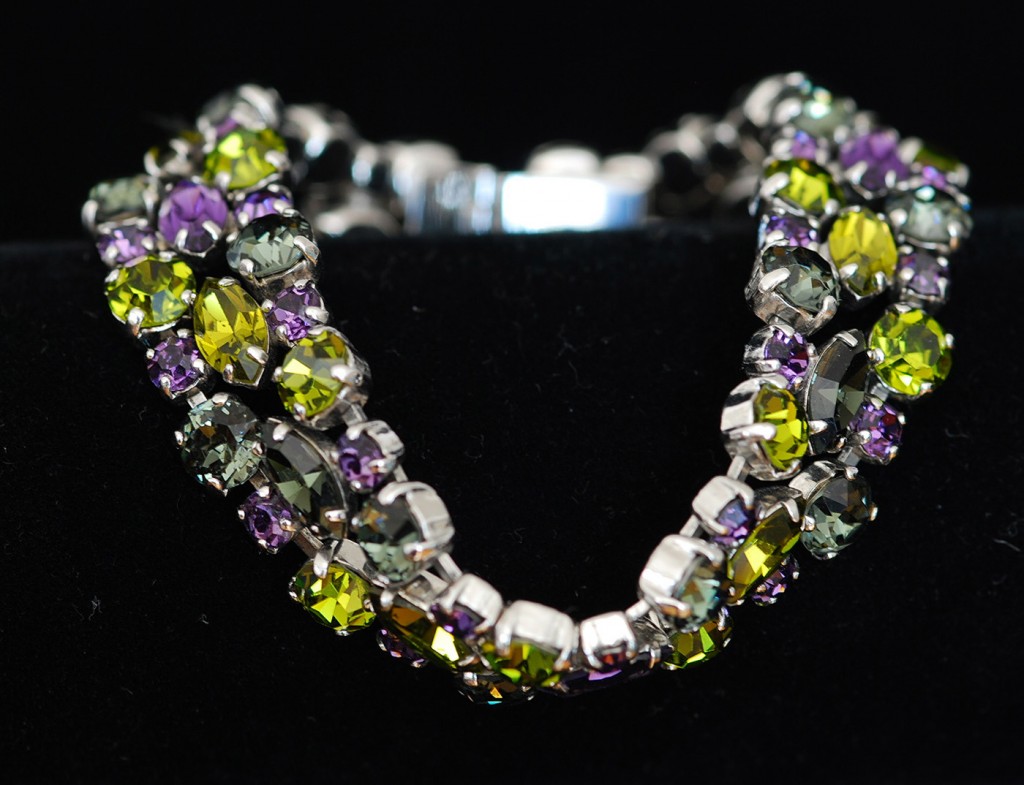
Sherman Bracelet With Coloured Stones
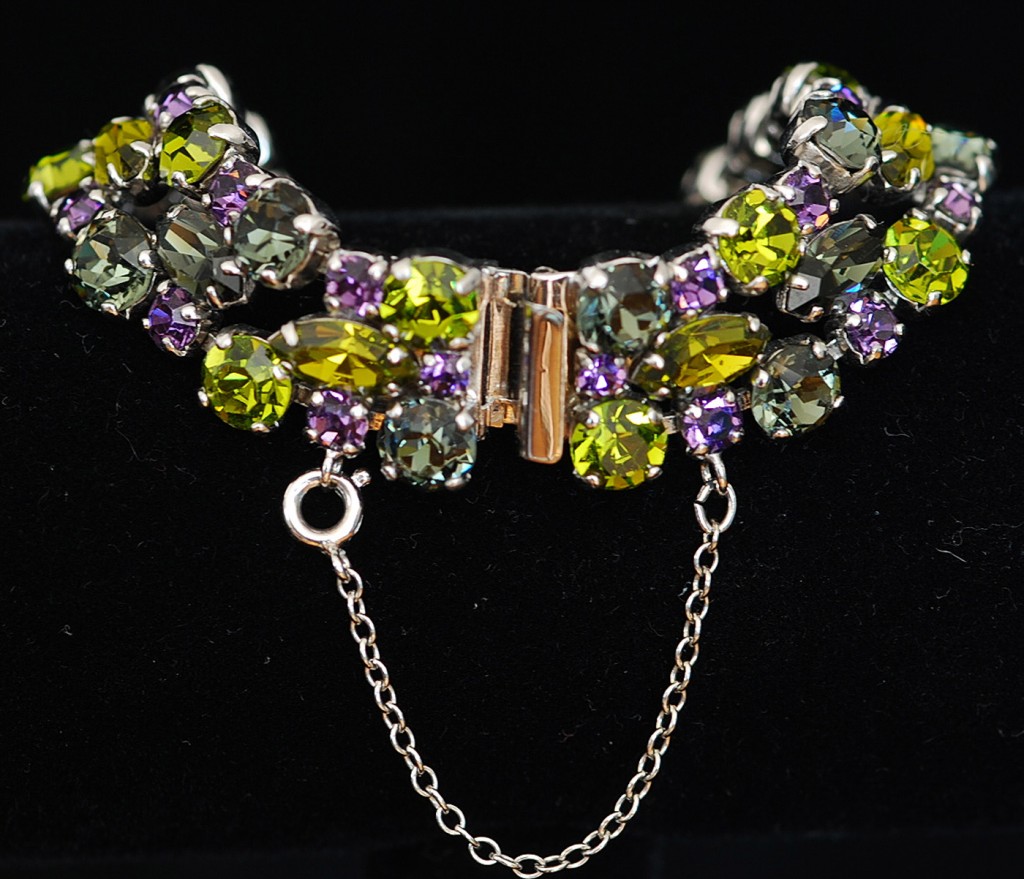
Sherman Bracelet With Safety Chain On Clasp
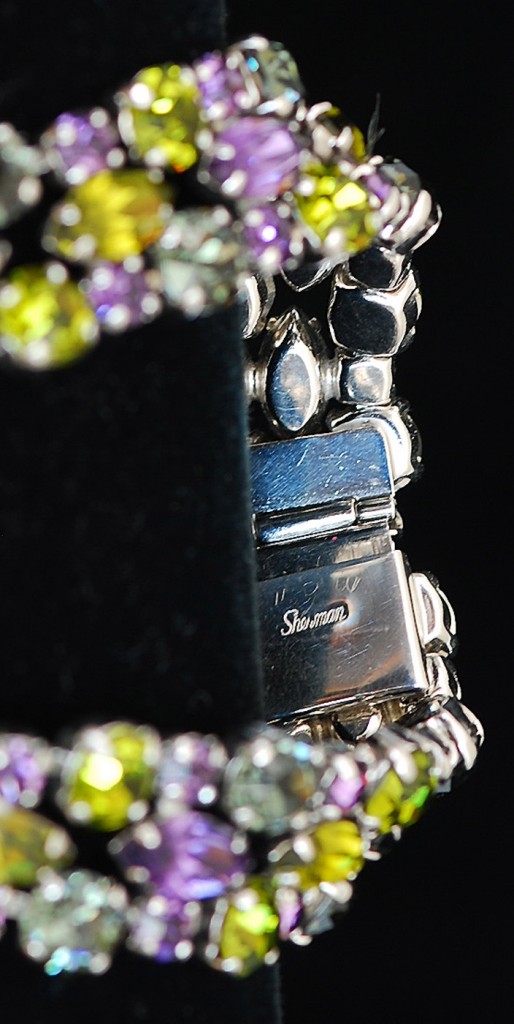
Sherman Signature On Coloured Bracelet
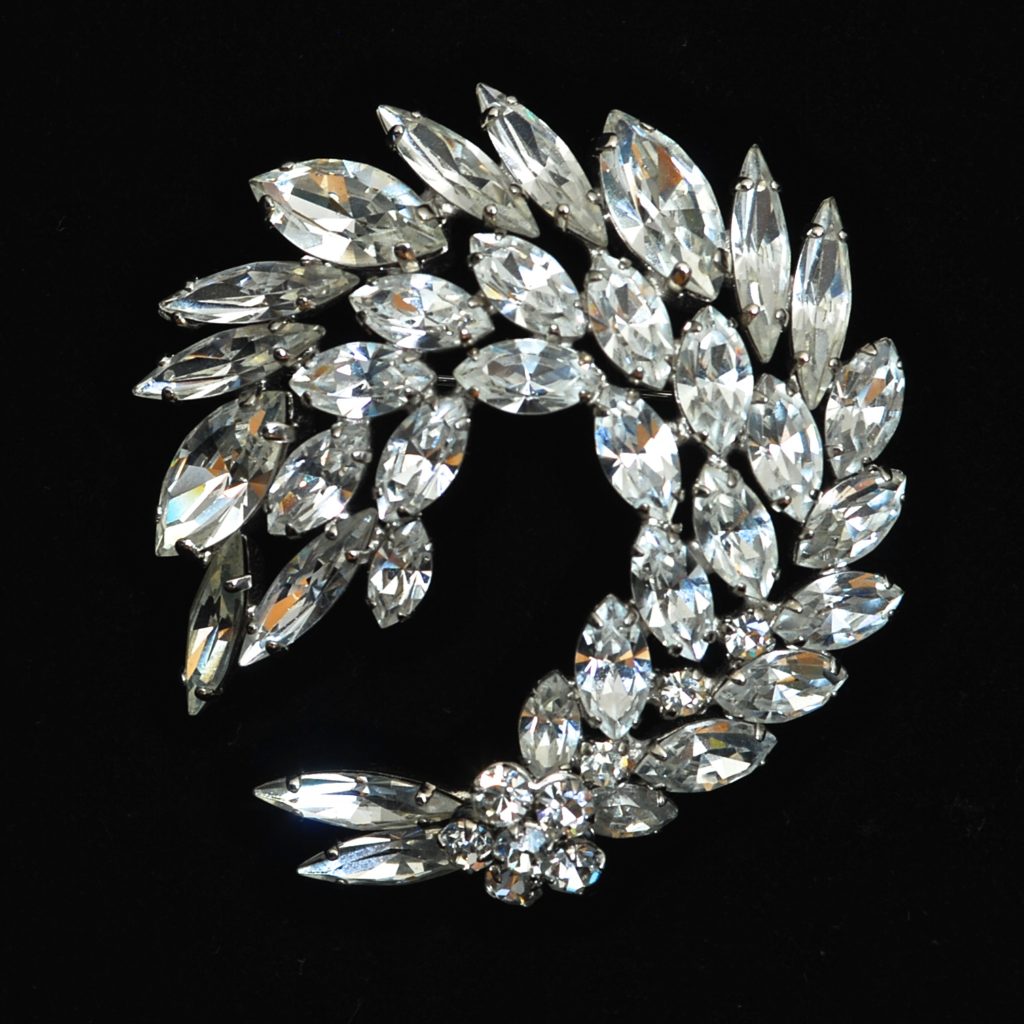
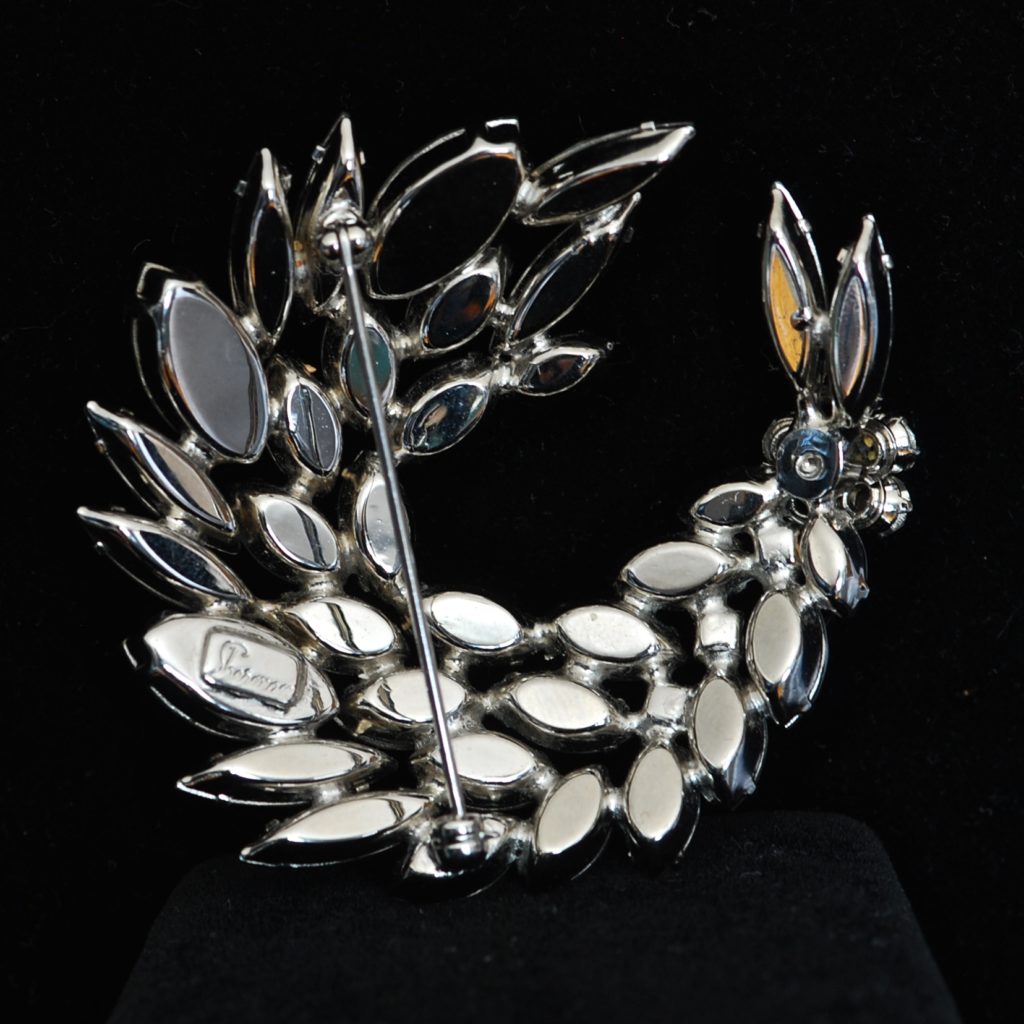
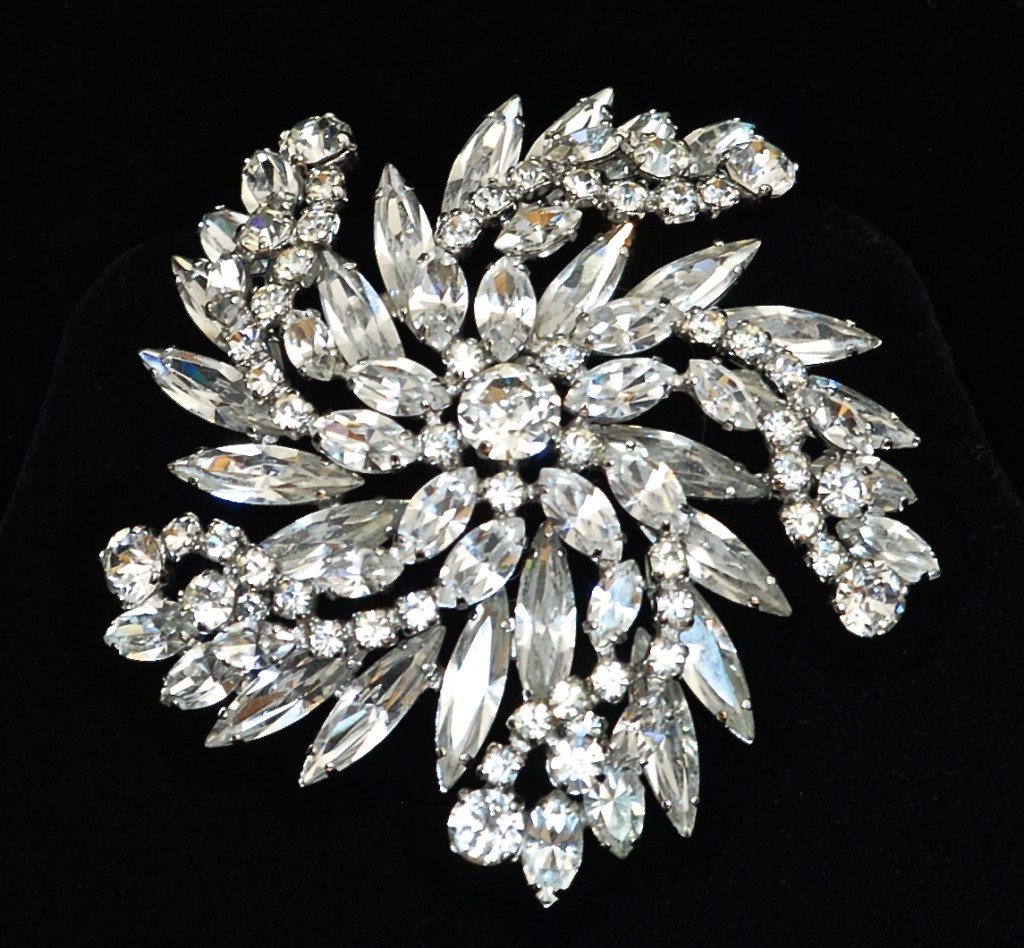
Sherman Fabulous Large Rhinestone Pin
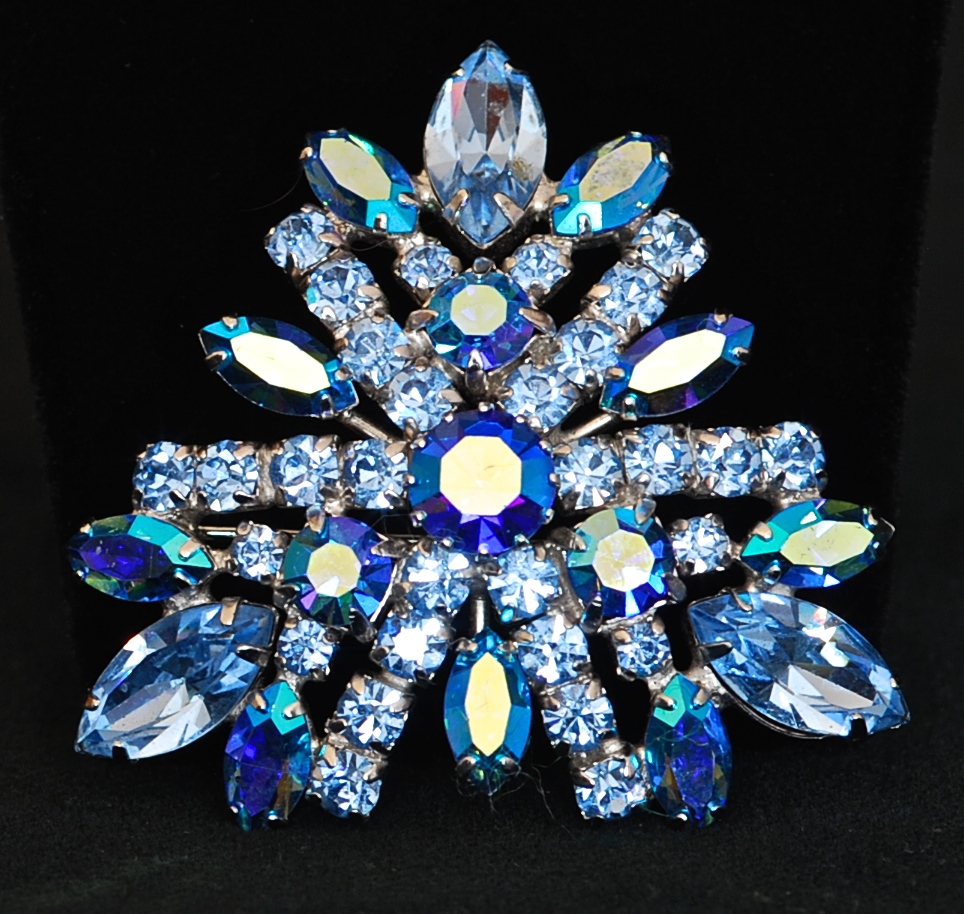
Gustave Sherman Blue Crystal Pin
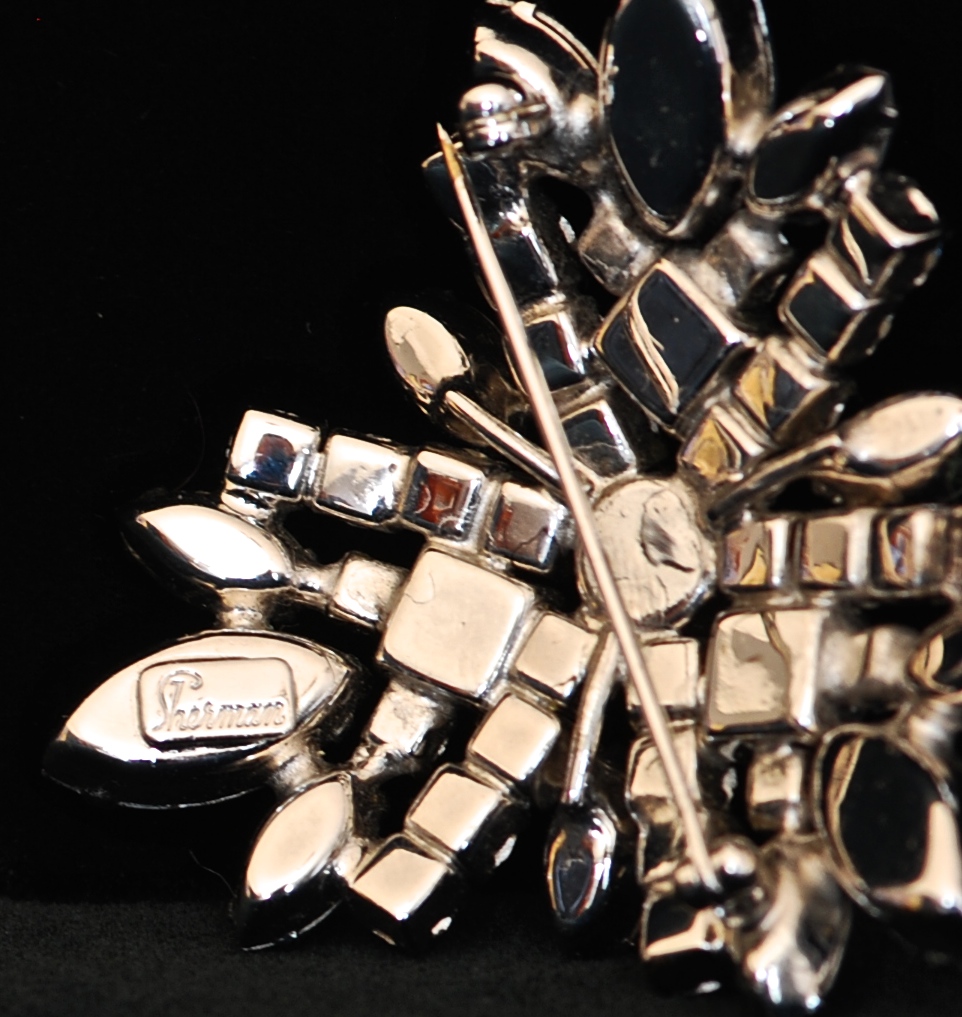
July 2, 2016
| Valerie Hayes
| Business & Web Development, Designer History, Fashion Research, Feature Articles, View All Articles & Photos, Vintage Outfits
Claire Haddad: Born July 17, 1924 – May 17, 2016. Her bio states she is “an Order of Canada recipient, and fashion designer to the stars”. One of her dresses was on the front cover of Vogue magazine in April 1966, worn by model Veruschka von Lendorff, and photographed by Rubartelli.
Based out of Toronto she was known for creating eclectic lounge wear, and luxurious high fashion sleepwear from the early sixties until the eighties. She was forward thinking enough to envision loungewear, worn as elegant evening attire outside the home.
From the Quiet West collection – it is a pleasure to share a fabulous 1960’s Claire Haddad kaftan featuring a desert scene on a vivd background of electrifying colours, which was so hip in the sixties. The trim is black, loopy cord, and outlines the neckline downward to the V opening on the front. The trim changes into looped cord buttonholes, for small, rounded black buttons. The two front slits and sleeves are also accented with matching trim. The overall portrayal is so sixties trippy – of swaying, shocking pink palm trees – and camels heading into a psychedelic oasis. It really is brilliant!
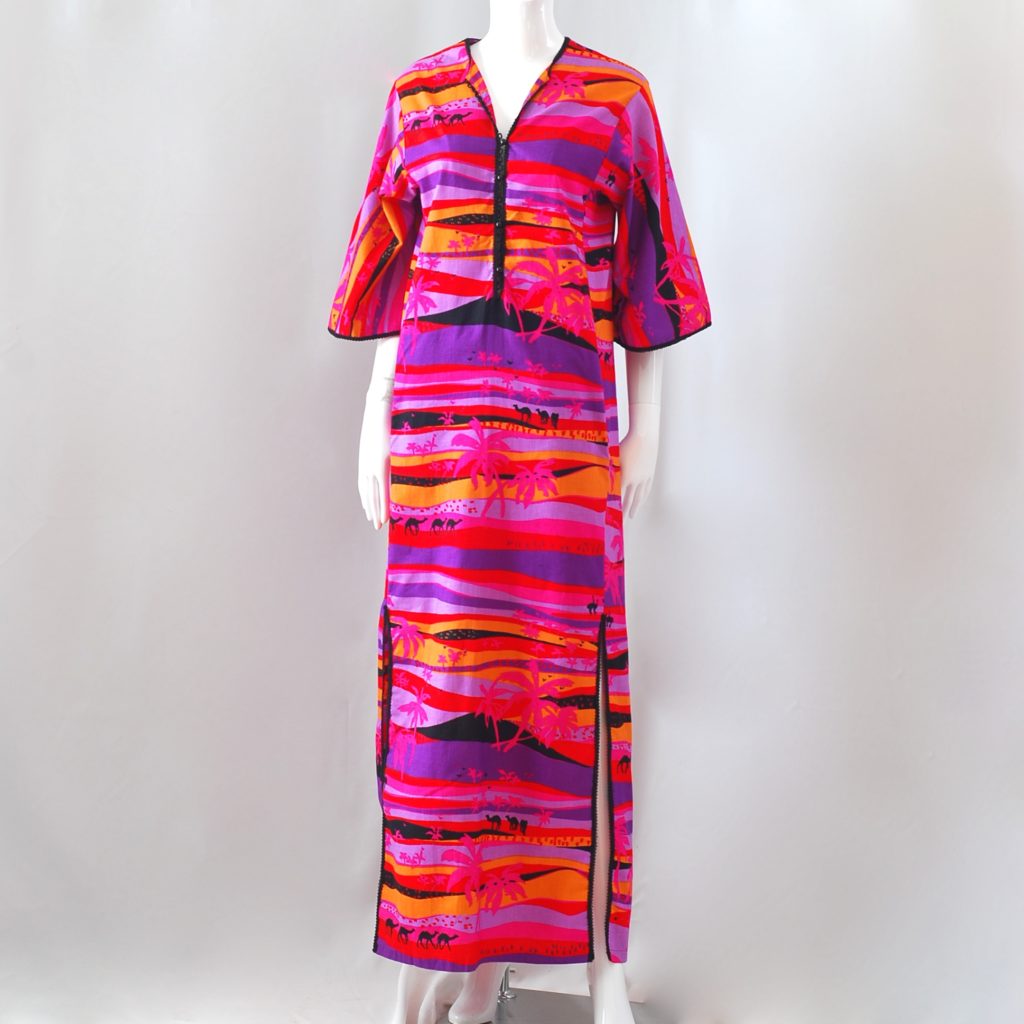
Claire Haddad 1960’s Kaftan
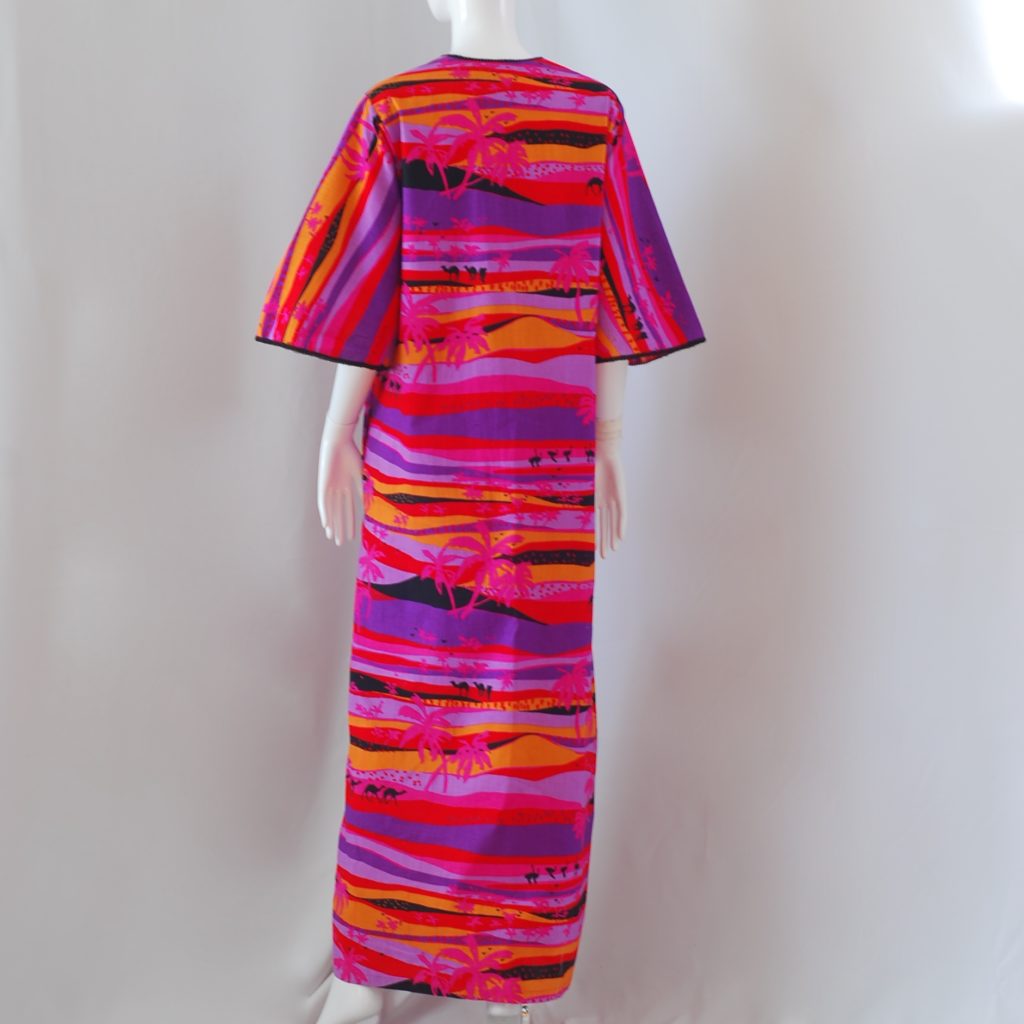
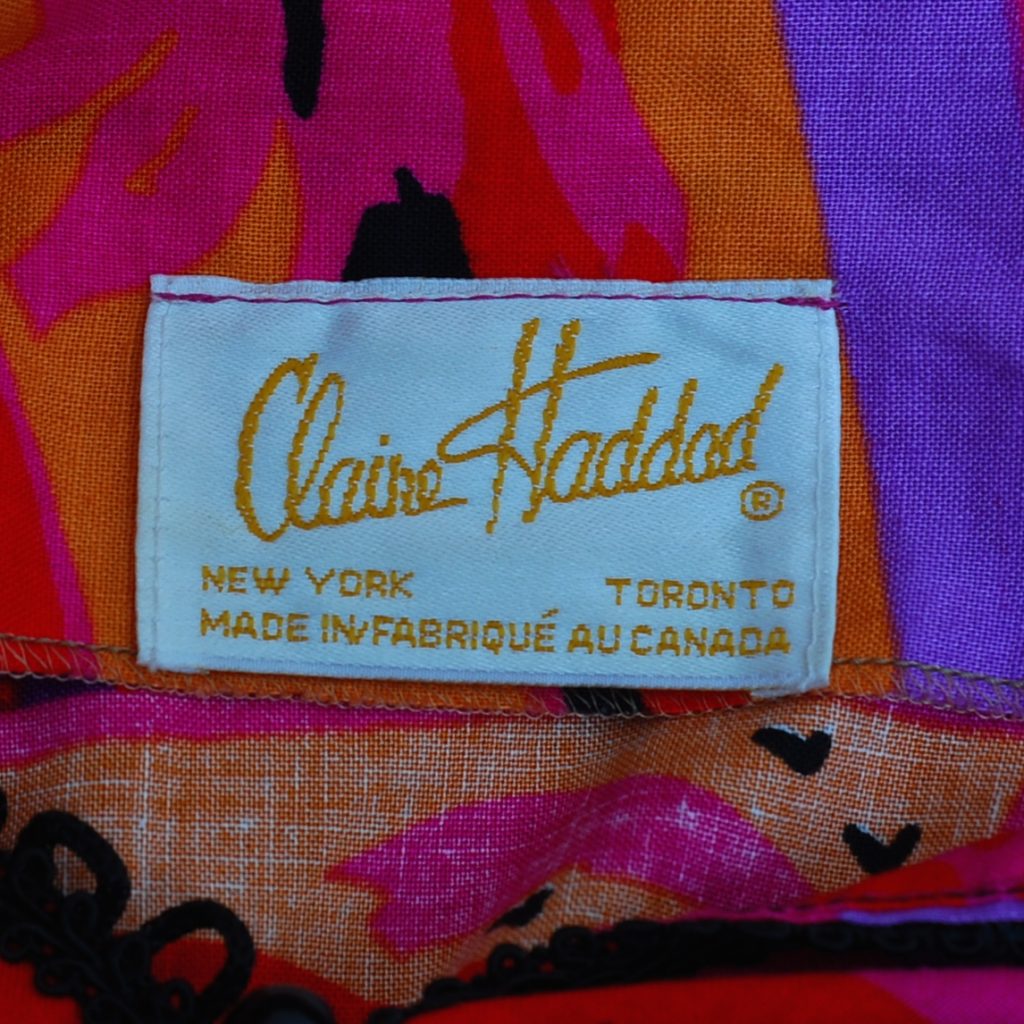
August 24, 2014
| Valerie Hayes
| Fashion Research, Feature Articles, View All Articles & Photos
If we look at an overview of fashion history over the past two hundred years – it is quite revealing. The pendulum did swing. It seems that the two world wars had the greatest influence on women’s fashion, which led to the fashion revolutions of the twenties and again in the sixties. When the men went to war, women had to take care of the farms, children, businesses – and in many cases, do the work of a man. It changed things. There was a period of liberation and newfound confidence that developed. Women did not have to be put on display in corsets and hoops. In danced the flapper era, bobbed hair and the Charleston.
The Charleston is a dance that became popular in 1923, when it was featured in the Broadway show called “Runnin’ Wild”. It became a dance craze associated with flappers, prohibition and the term speakeasy. The term speakeasy caught on when a newspaper described saloons and taverns as speak-easies. During prohibition there were many places that sold alcohol. They were raided frequently, but were so profitable – it made no difference. In fact there was a marked increase in organized crime associated with prohibition. In addition to the term speakeasy, the taverns were also referred to as Big ol Ben, Big Toad, Blind Pig or Blind Tiger. The viewing of the animal was argued to be the main attraction. The owner of the establishment would place an animal on display. The patrons would get served alcoholic beverages after they paid to see the animal. They drank and danced the Charleston – frequently with women dancing while the men watched. It is most interesting to know that a song that was written and composed for a Broadway Musical ended up having such far-reaching societal impact with a strong political message. People just refused to have no fun. And although that is a double negative – it turned out okay.
The Second World War was rife with so much propaganda and grief – it took years for the next wave of rebellion to percolate. When it did – the skirts got shorter and some went on acid Kool-Aid trips. There was a generation gap like never before. LSD was a popular drug during the sixties. A Swiss chemist discovered it in 1949. Once they became aware of the psychoactive properties, it went to big Pharma and was marketed by the drug company Sandoz. The drug was widely used recreationally as well as in medical research. The stories of the use of LSD in psychiatry, oftentimes on unsuspecting patients, so their reaction could be studied – was appalling. It was not until there was public outcry over bad trips, suicides and flashbacks associated with the drug, that they stopped using it. Sandoz stopped production in 1963 – however, it was used in medical research up until 1980. The drug was made illegal as a recreational drug in the late sixties.
The sensational death of Diane Linkletter (TV personality Art Linkletter’s daughter) in 1969 became widely publicized, when she supposedly jumped to her death from a sixth story window when high on LSD. This event became the catalyst for beginning the war on drugs. But, in digging a little deeper into the death of Diane Linkletter, I learned that she was not alone in the apartment. The toxicology showed that she did not have any drugs in her system. Many years later, her boyfriend who was with her at the time, was involved in another suspicious death involving a female celebrity. At the very least, it could be said, that Diane Linkletter’s death is a mystery. And the war on drugs was a pointless hoax.
Marijuana does not have the colored past that is associated with alcohol and LSD as far as drama and tragedy is concerned. It was made illegal long before the more potent drugs like LSD. In 1923 it was somehow placed under the Opium Act, yet it is clearly not an opiate. If you ingested a half a pound of it, it would not show up in toxicology studies as an opiate. Nor would it give the same symptoms of overdose as opiates. As we all know, there is a long history associated with attempts to have marijuana legalized. And similar to prohibition – no matter how many raids crop up – it is still profitable. The thing that seems odd to me is that marijuana is not a narcotic, therefore, how can it be classified as one? It would seem that all drugs, regardless of what they are used for, should be classified with some accuracy, and not lumped together with drugs that have completely different properties. After all, drug properties are supposed to be science.
Fashion and creative freedom stem from a certain level of rebellion. I would term it as a peaceful rebellion, since fashion statements do not usually harm anyone (with the exception of six inch heels!) Fashion – like music, poetry, writing, painting, gardening, and interior design – is all about self-expression. Oppression, contradictions, control, and hypocrisy all force change. The greater the effort to control, the more people will find a way to define themselves. Every individual is unique. We hope not to be changed by the rippling effects of conflict and war. We hope not to be robbed of our identity in any way. To allow others to define us is a mistake and waste of potential. From a purely practical perspective, not all styles and trends suit all body types. We can look back into the political context of the different eras that gave rise to the hemlines. Those individual statements contributed to a movement.
The distinction to be made about Runnin’ Wild – is that it was not so much about being bad, as it was an expression of freedom. After all, if you look at either the flapper style or the Charleston, they are hardly sinister. Even the flapper’s response to prohibition was not all that bad. They actually made a point…when they kicked up their heels.
Copyright Valerie J. Hayes and Quiet West Vintage (2014). Unauthorised use and/or duplication of this material without express and written permission from this blog’s author/owner is strictly prohibited. Excerpts and links may be used, provided that full and clear credit is given to Valerie J. Hayes and Quiet West Vintage with appropriate and specific direction to the original content.
August 23, 2014
| Valerie Hayes
| Business & Web Development, Feature Articles, Thoughts & Ideas, View All Articles & Photos
The word tautology has a nice ambiguous ring to it. It originated with the ancient Greeks who soon saw it as the mere repetition of words to support an argument. The logic behind it, a concept which later cropped up in propositional mathematics – is that if you reword and say the same thing over and over, each statement will fill the contingent of logic, support the argument and make it true. There is a formula.
In the forties and fifties Rudolf Flesch contributed to the recognition of tautologies in the written word. He wrote titles like “The Art of Clear Thinking” with a chapter title “How Not To Be Bamboozled”. He also wrote “The Art of Plain Talk”. Gotta love this guy!
But isn’t repetition with a few variables thrown in, the only way to reinforce something? Tautologies are getting tighter. It is the contraction of the sheer volume that must now be sifted. The information age is causing them to shrink – like wool in a hot washer. If you take out all superfluous words and repetitions – it strips the wordy embellishments to reveal the core. Padded writing is sort of like a glitzy, tacky overdone outfit.
Now, we have SEO’s and key words. We have a skeleton of tautologies in every realm. We just have to remember – that repetition – doesn’t necessarily mean that something is true or authentic. Authenticity has a solid ring to it. It holds onto some class. Maybe stripping away all superfluous and repetitious words brings us closer to poetry…since poetry says as much as possible with as few words as can be gotten away with. Therefore the core concept often has an elemental truth.
It might be on the horizon to drum up SEO’s out of a poem or a song…and like birds in the forest – the white noise is lost, leaving only the voice.
Copyright Valerie J. Hayes and Quiet West Vintage (2014). Unauthorised use and/or duplication of this material without express and written permission from this blog’s author/owner is strictly prohibited. Excerpts and links may be used, provided that full and clear credit is given to Valerie J. Hayes and Quiet West Vintage with appropriate and specific direction to the original content.
August 23, 2014
| Valerie Hayes
| Business & Web Development, Feature Articles, Inside Passage Legendary Map, My Story, Poetry By Valerie Hayes, Thoughts & Ideas, View All Articles & Photos, Vintage Hats
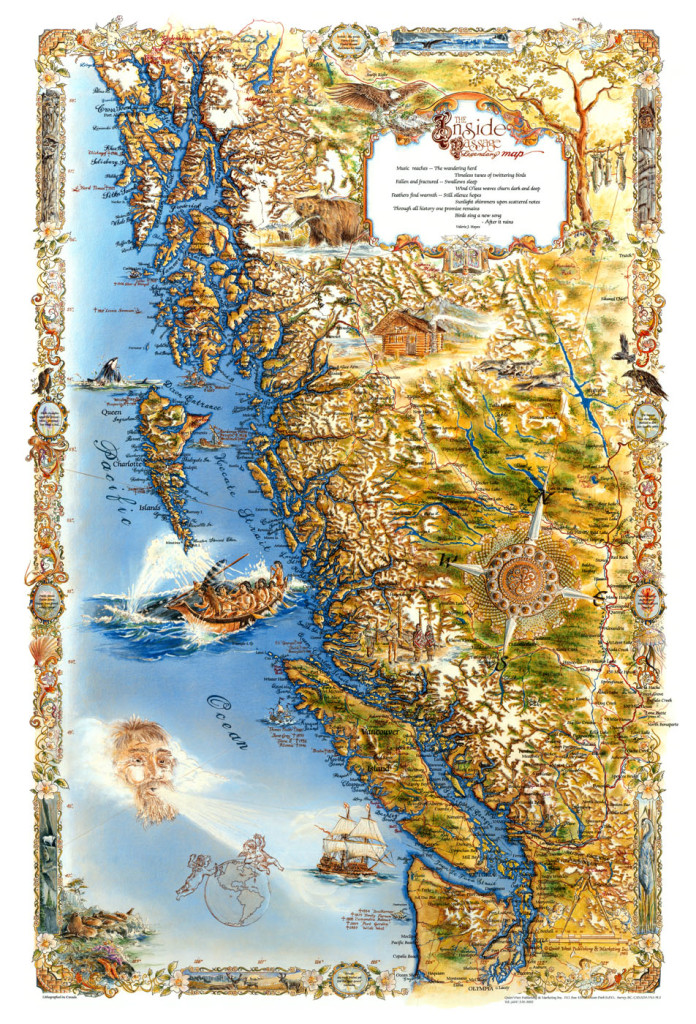
Inside Passage Legendary Map By Quiet West Publishing
Ladies Wear Many Hats
Ladies wear many hats ~
We put the lady on the map,
To illuminate despair –
To journey where we dare;
To follow rivers to wilderness,
To fly and then return to nest.
To soften contours of the stone –
And pave the road with poems.
Valerie J. Hayes
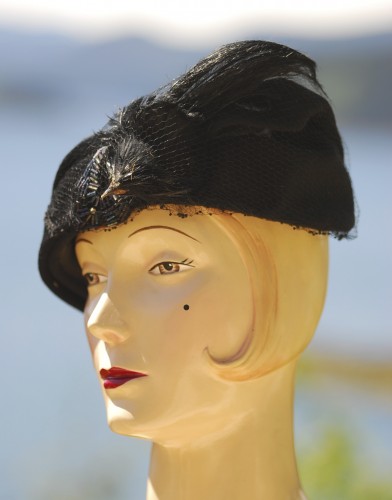
Early 1900’s with Real Bird. This Practice was Banned in 1909
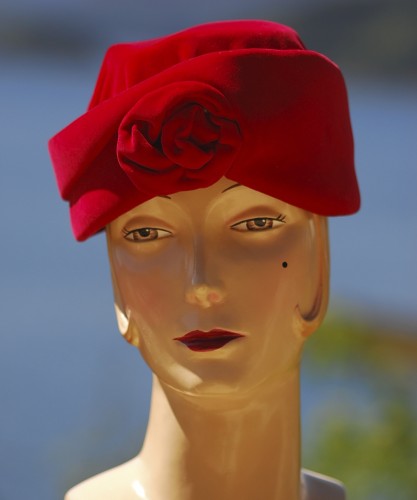
1960’s Velvet Rose Hat
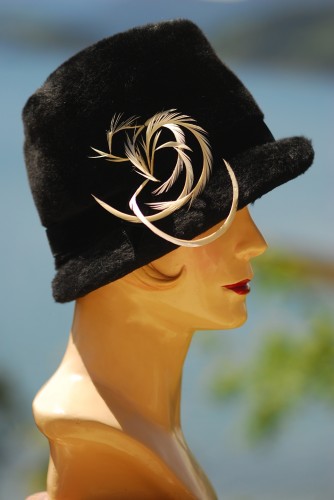
1940’s White on Black
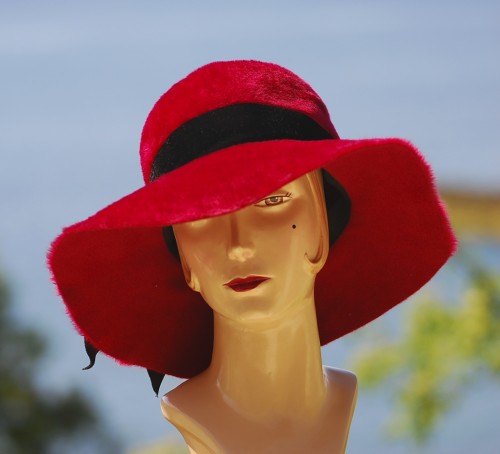
1950’s Scarlet Glamour
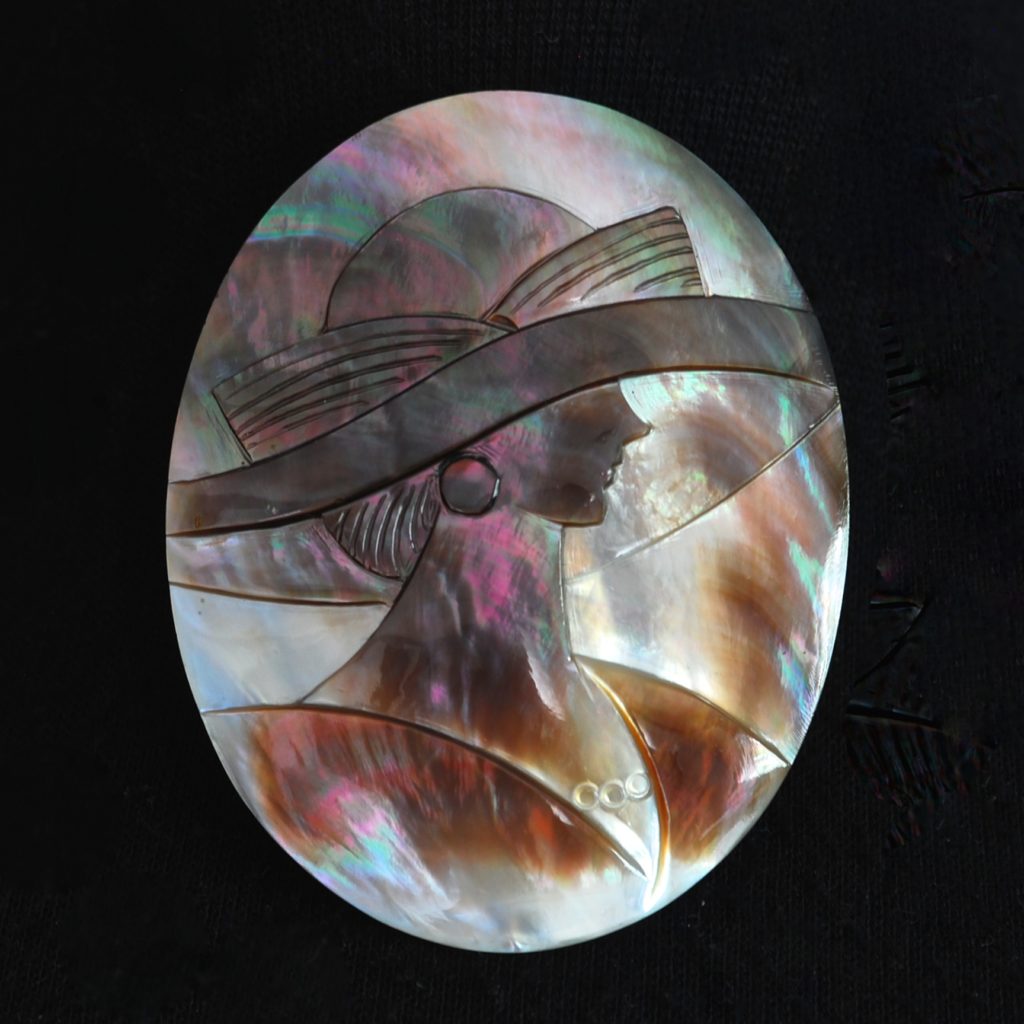
Carved Mother Of Pearl In Natural Sun Lit Colours
Copyright Valerie J. Hayes and Quiet West Vintage (2014). Unauthorised use and/or duplication of this material without express and written permission from this blog’s author/owner is strictly prohibited. Excerpts and links may be used, provided that full and clear credit is given to Valerie J. Hayes and Quiet West Vintage with appropriate and specific direction to the original content.
January 23, 2014
| Valerie Hayes
| Business & Web Development, Designer History, Fashion Research, Feature Articles, View All Articles & Photos, Vintage Hats
When I first started collecting vintage hats, it was enthralling to see all the different designs and colors. Hats from the thirties, forties and fifties were still fairly abundant in the late seventies and early eighties. It was considered “off the wall” to collect them. The general belief was that they would never be worn again. In fact, the key designers have retired or passed away, and many of the styles have never been made again. One thing remains true. Many people wear hats well. There are some gorgeous hats that have survived the test of time and chance.
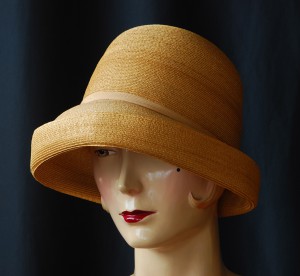
1960’s Straw Cloche by Designer Schiaparelli
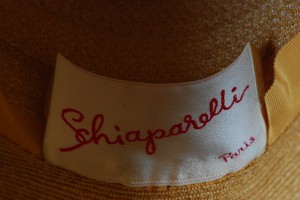
Schiaparelli Paris Label
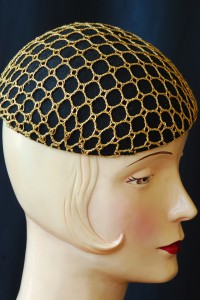
1950’s Gold Beaded Beanie
How could they not fascinate us? A hat changes a person’s aura and creates a heady fashion statement that rivals no other part of the attire. During the 19th and 20th century, every design that could be conceived of was shaped into a hat. One of my favourite photographs is of a 1930’s hat that was listed in the Doyle Gallery in New York several years ago. It looked like a bees nest with bees buzzing all around it. There is a comic and whimsical element to a percentage of designs. Just as the hemlines went up after the war, the hats too, became either more utilitarian or more glamorous. The early 1900’s hats were still mostly wide-brimmed and decorated with flowers, berries, ribbons and even birds. The practice of taxidermy to place birds on hats was banned around 1909. Later on, in the forties – there was a bird revival. They used real feathers and made the body of the bird out of something else.
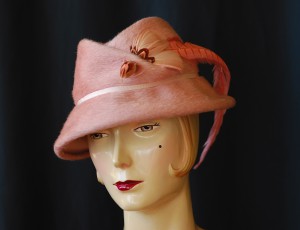
1940’s Bird Revival
During the eighties, when I collected hats that were mostly dated from the 20’s through to the 60’s – it was because those were the hats that were available and fairly abundant. I did not pay much attention to labels, but studied each hat and bought what I liked. Inadvertently, I did end up with some well known designer labels. Elsa Schiaparelli, Lilly Dache, Macy’s, Stetson Fifth Avenue, Christian Dior, Mollie Entwistle, and Jerry Yates – are some of the designers who made vintage hats to marvel at. There are many other more obscure designers who made hats to the same level of quality as the luxury designers. All were affected by the Second World War, which caused some to flourish and others to fail.
When looking for vintage hats now, I look first for a label. If it is made in China, it is not vintage, even though it may be a vintage style. A label for a quality vintage hat will be fairly large (usually) and will be made of fabric that is stitched into place inside on the back of the hat. Some of the labels have a small flower attached on the side of the label. If there is no label and you believe it is vintage, check the brim, inside the crown, to see if there is heavy grosgrain ribbon. Also, if the hat has any embellishments, evaluate what they are made of, since certain types of fabrics, ribbons, flowers, etc. were used that are not modern day. Sometimes the maker and country of origin is printed inside on the crown of the hat.
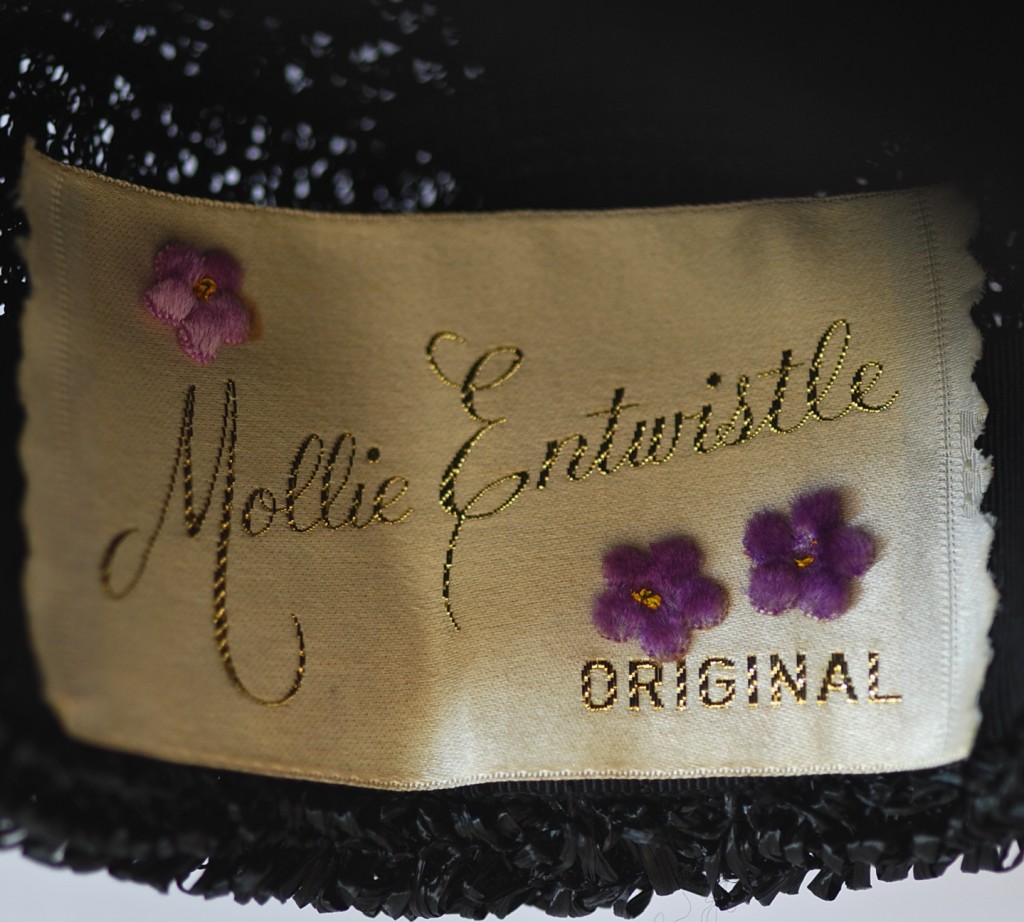
Mollie Entwistle Vintage Hat Label
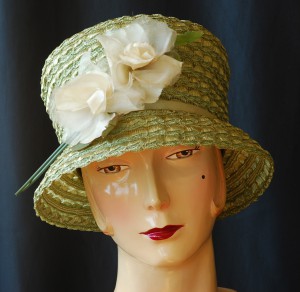
1920’s Stetson Fifth Avenue
Before I acquired some Stetson Fifth Avenue hats, for some reason I thought Stetson was associated only with cowboy hats. But, Stetson Fifth Avenue made some interesting and upscale hats of different styles. A large percentage of fall and winter vintage hats are made of doeskin felt. Some are made of sealskin, which is often dyed.
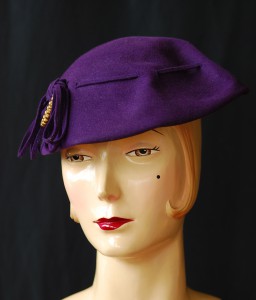
1940’s Stetson Fifth Avenue
In the seventies, hats from the turn of the century were not available to the average person, unless you were a dealer, collector or museum. Hats from the thirties and forties seldom turn up in thrift stores anymore. The hats with face veils often get torn due to the fragility of the veils. Rubber bathing caps – unfortunately, there are only a few that have lasted – since rubber sticks together and disintegrates over time.
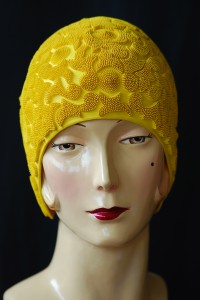
1950’s Rubber Swim Cap
Most hats can be brushed with a soft bristle natural brush in the direction of the grain and steamed into shape. Unless they are for display, it is best to keep them in a box with some acid free tissue paper. Face veils, rubber bathing caps and feathers require extra attention. Be very careful when steaming hats with feathers and avoid it altogether if the feathers have been glued onto the hat.
Copyright Valerie J. Hayes and Quiet West Vintage (2014). Unauthorised use and/or duplication of this material without express and written permission from this blog’s author/owner is strictly prohibited. Excerpts and links may be used, provided that full and clear credit is given to Valerie J. Hayes and Quiet West Vintage with appropriate and specific direction to the original content.























 The next 1960’s little black dress from Montreal is aptly labeled – After dark Cocktails.
The next 1960’s little black dress from Montreal is aptly labeled – After dark Cocktails.




















 Leopold Original, Toronto 1960’s Velvet Hat With Big Satin Bow.
Leopold Original, Toronto 1960’s Velvet Hat With Big Satin Bow.
 Andre, Montreal 1960’s Gold Brocade Turban.
Andre, Montreal 1960’s Gold Brocade Turban.
 M’Sieu Leon, Montreal 1970’s Beaver Fedora.
M’Sieu Leon, Montreal 1970’s Beaver Fedora.




































